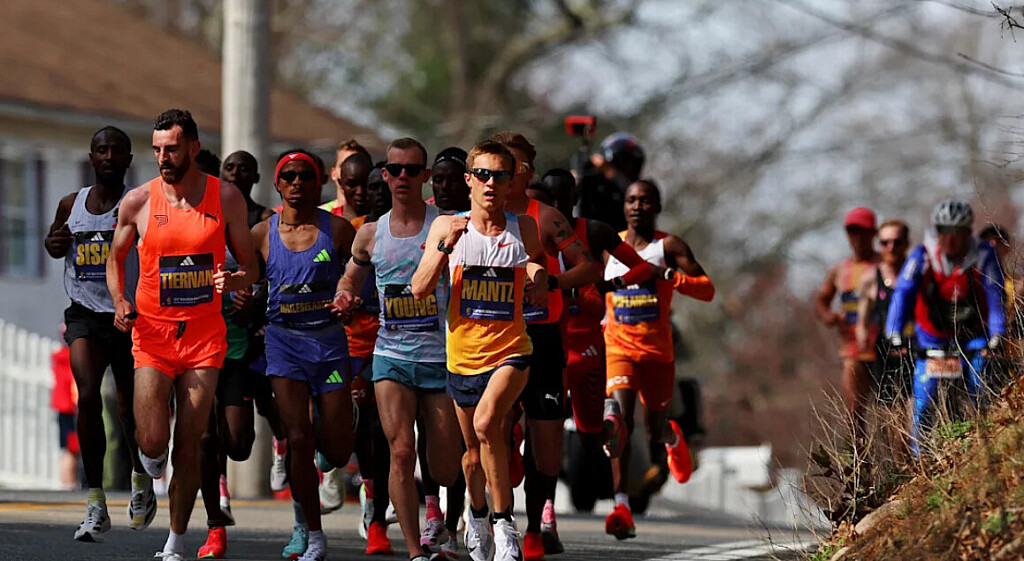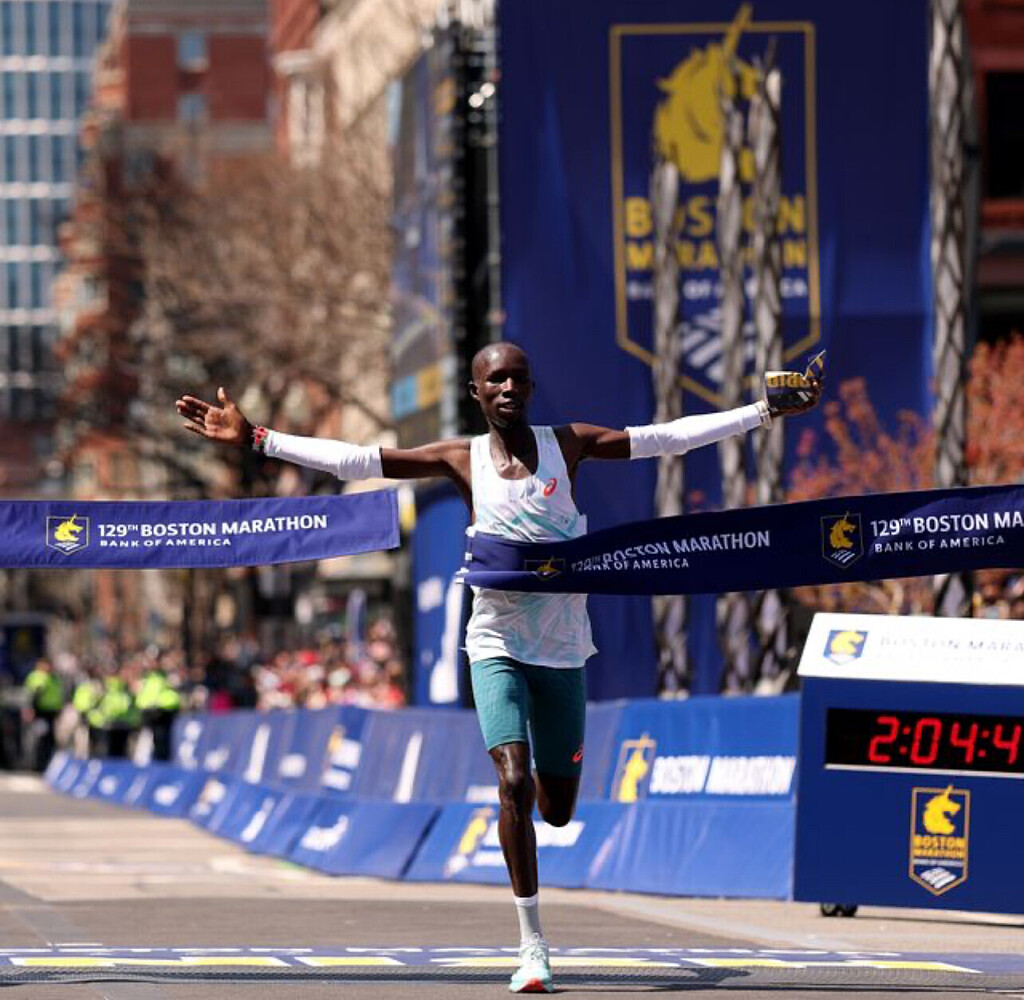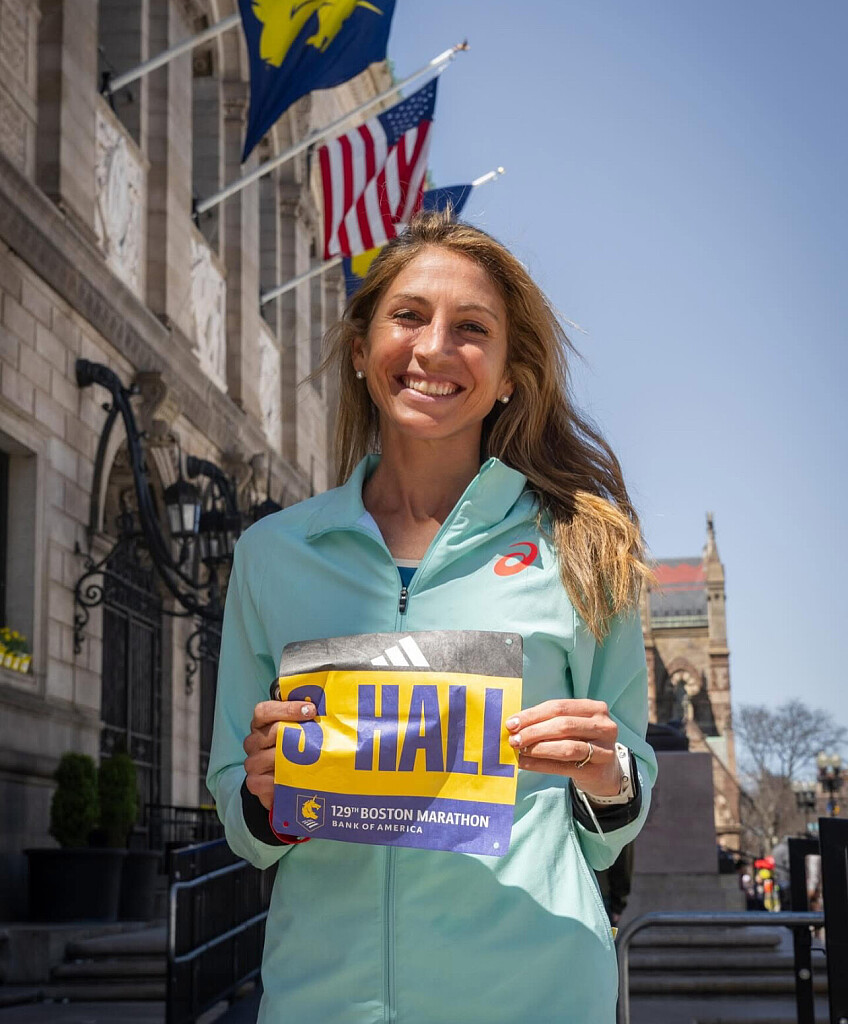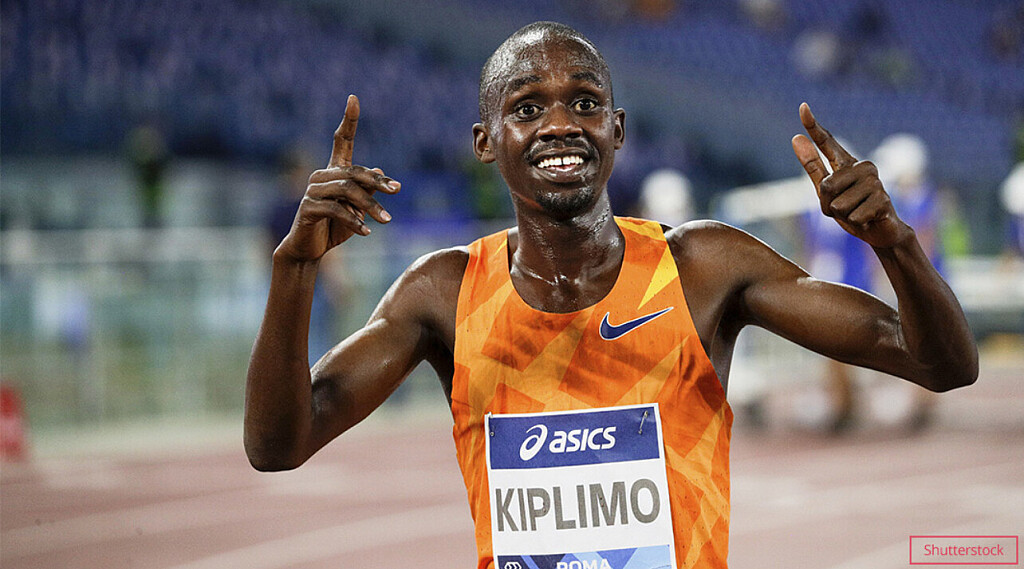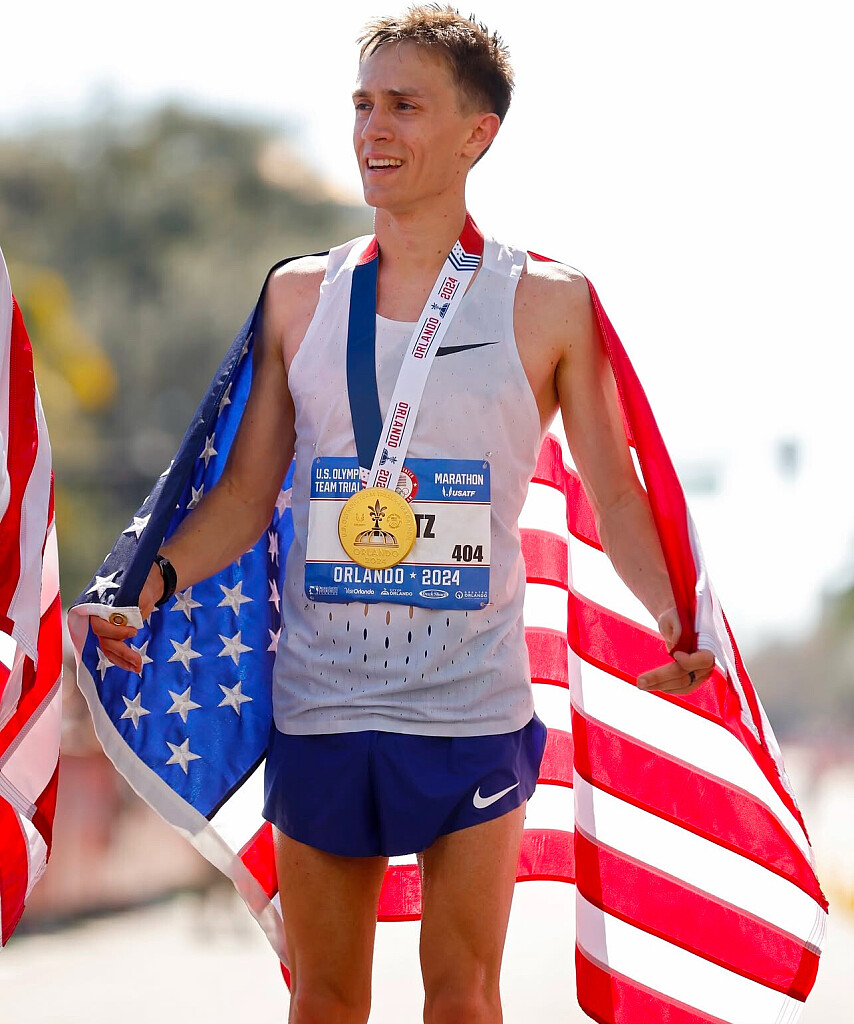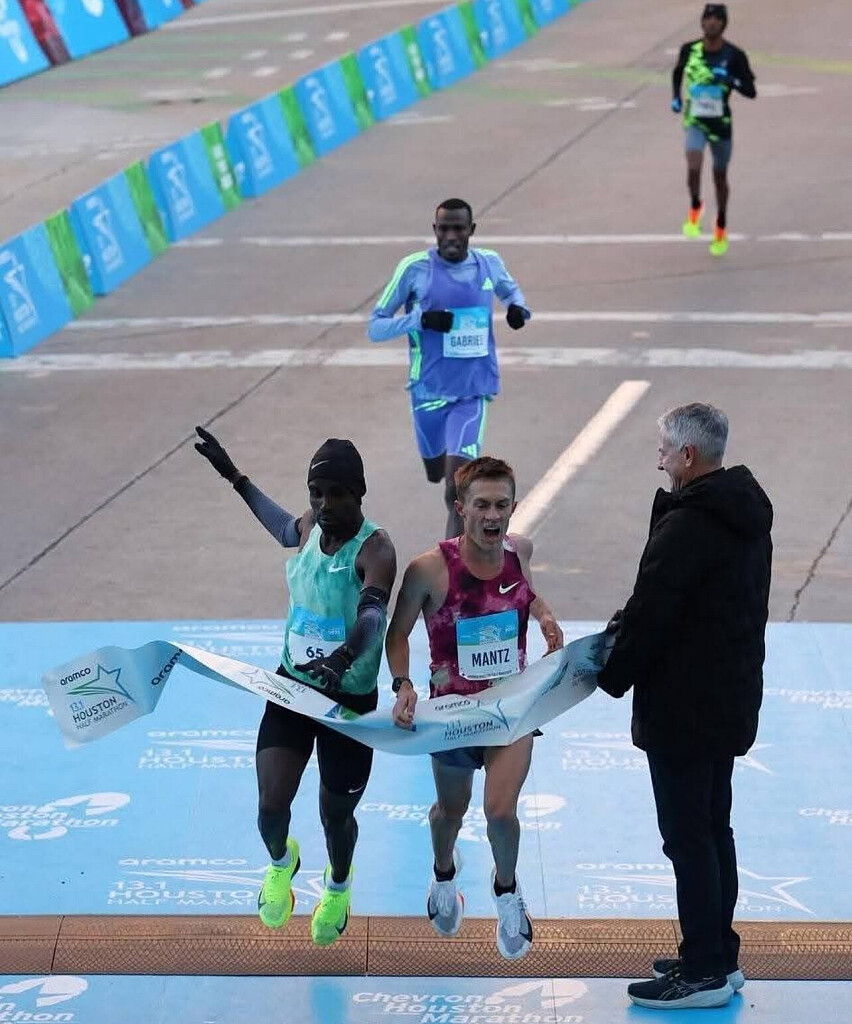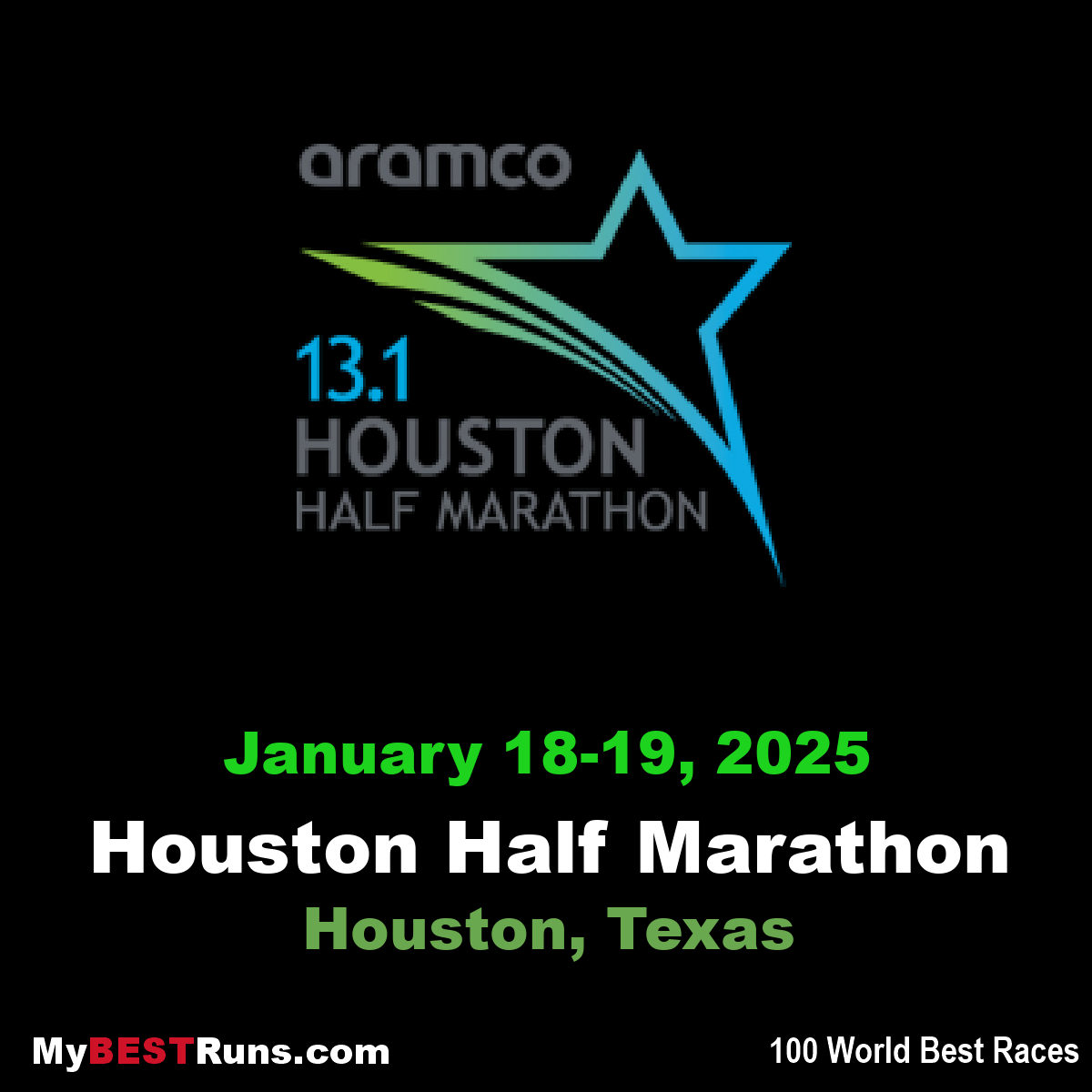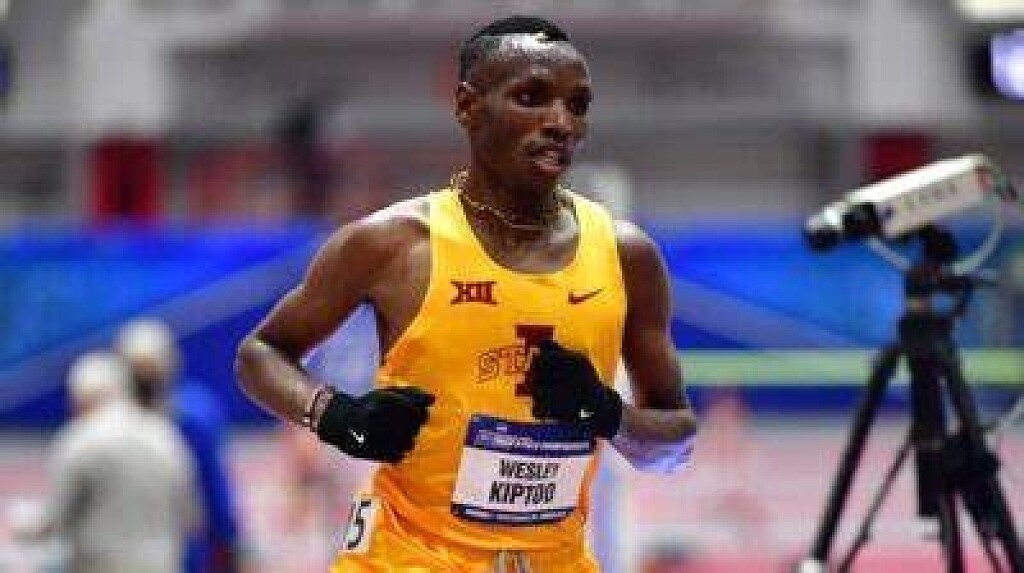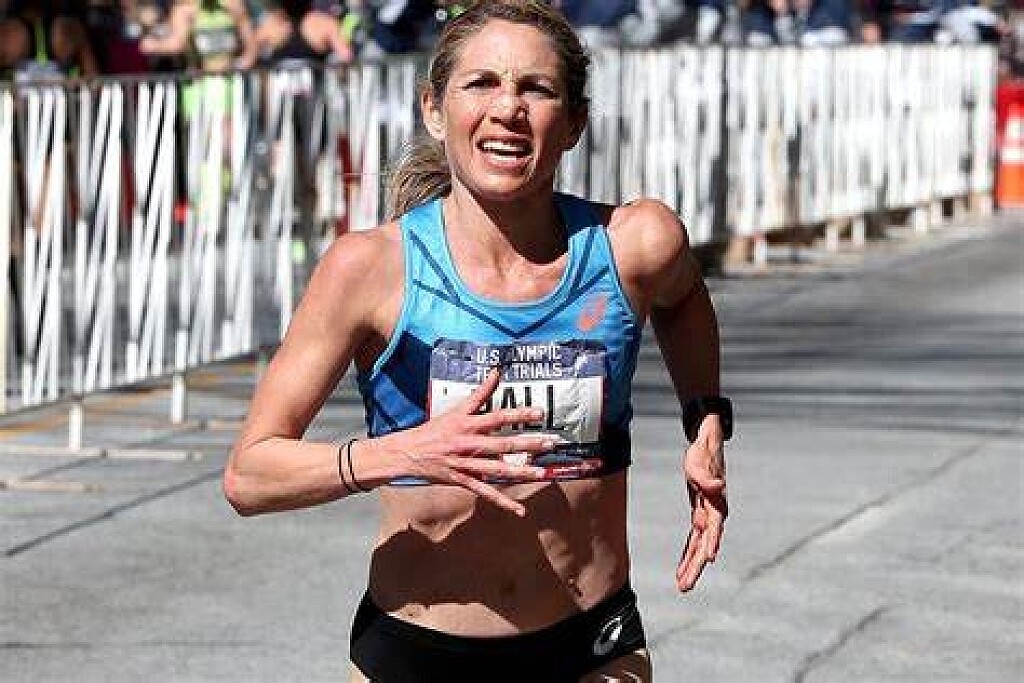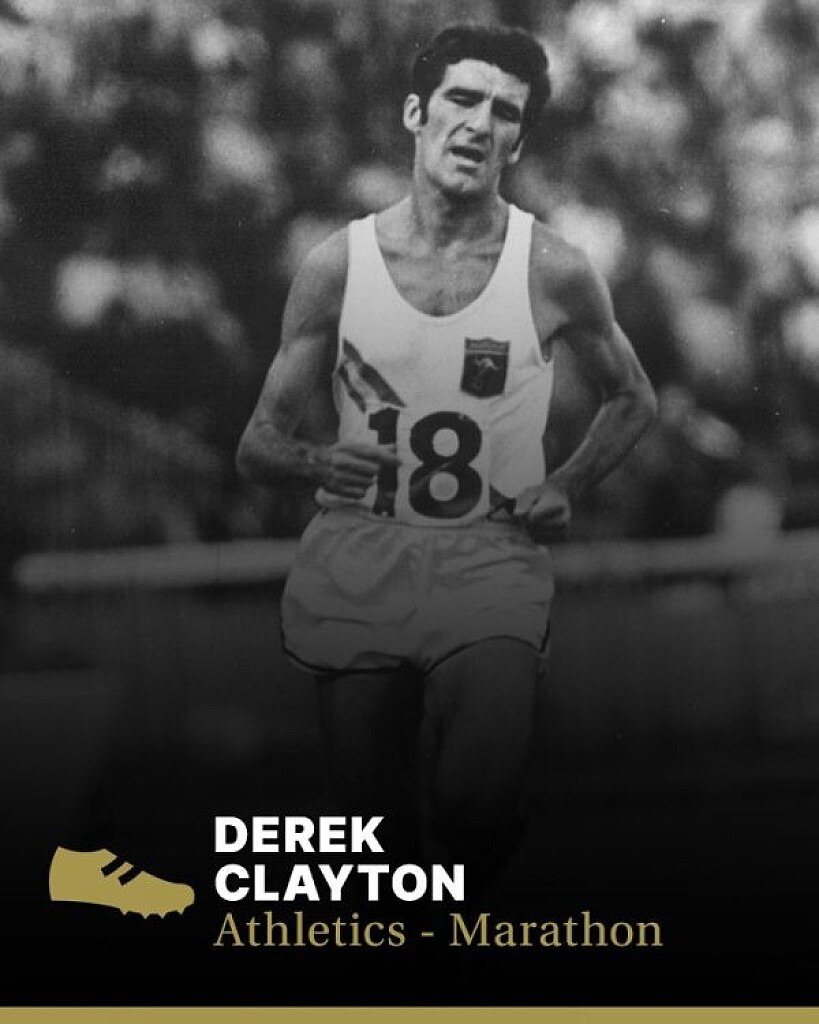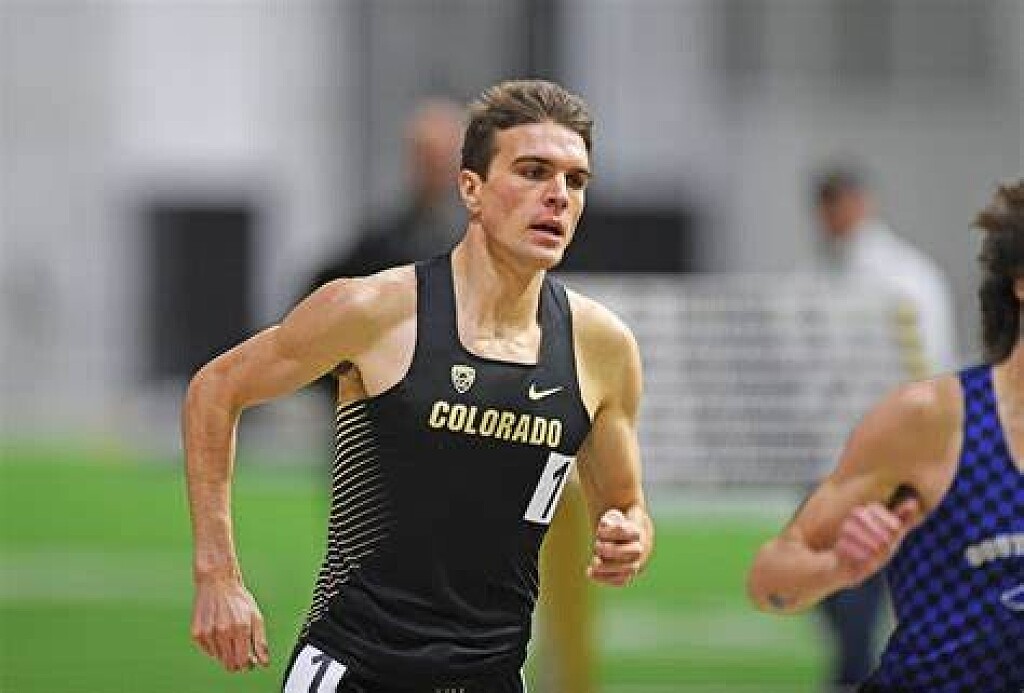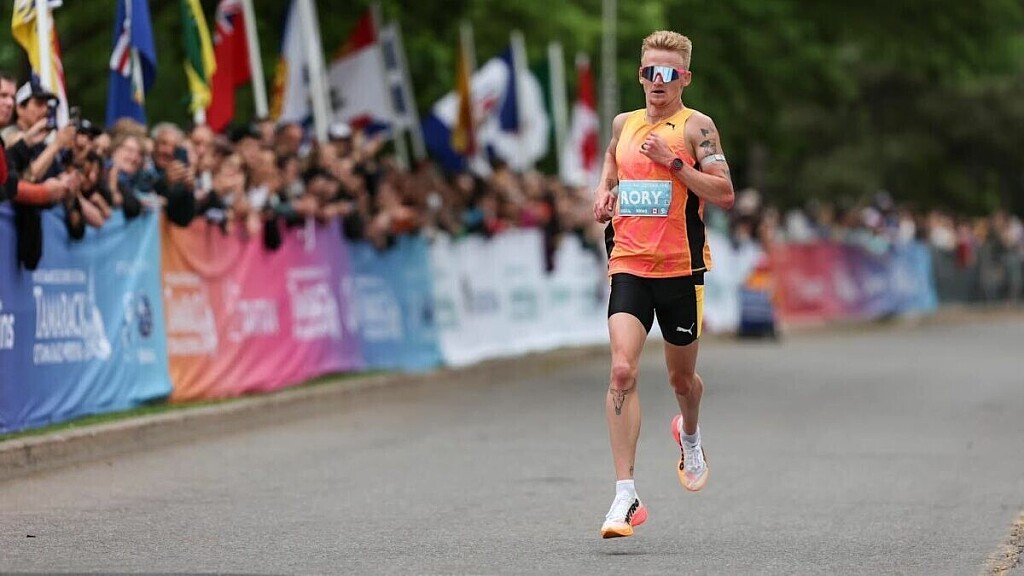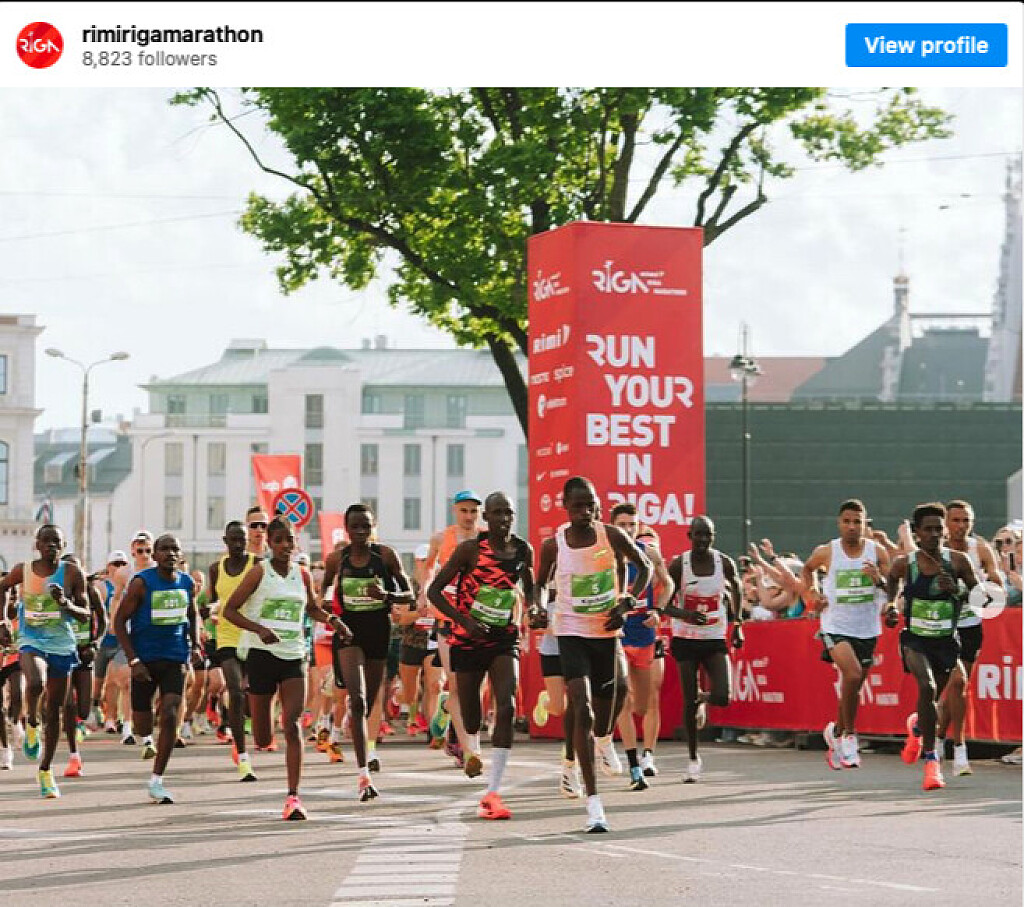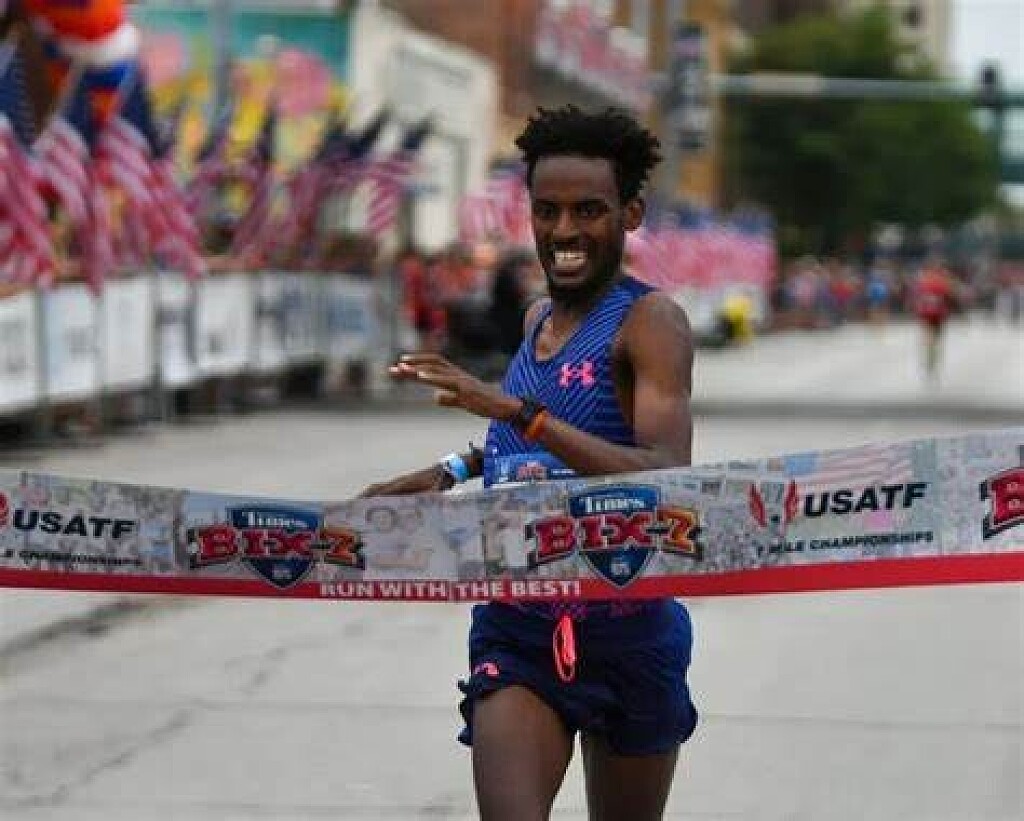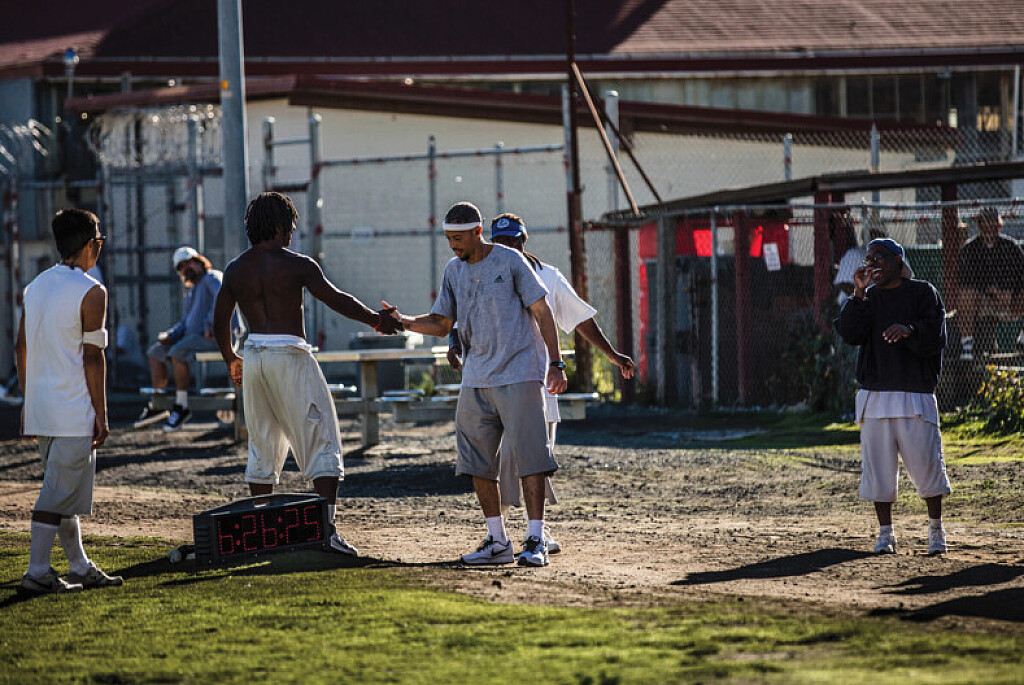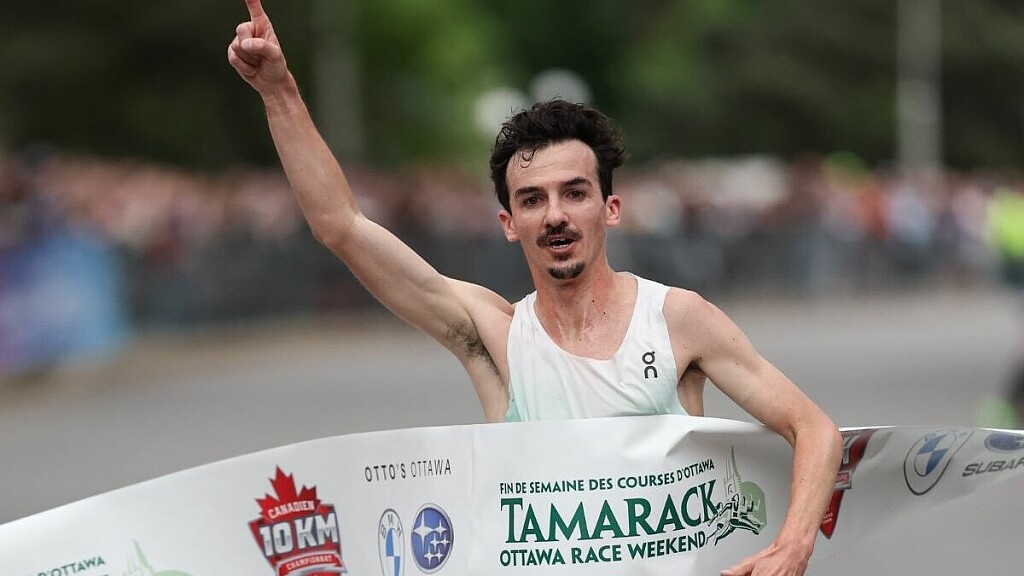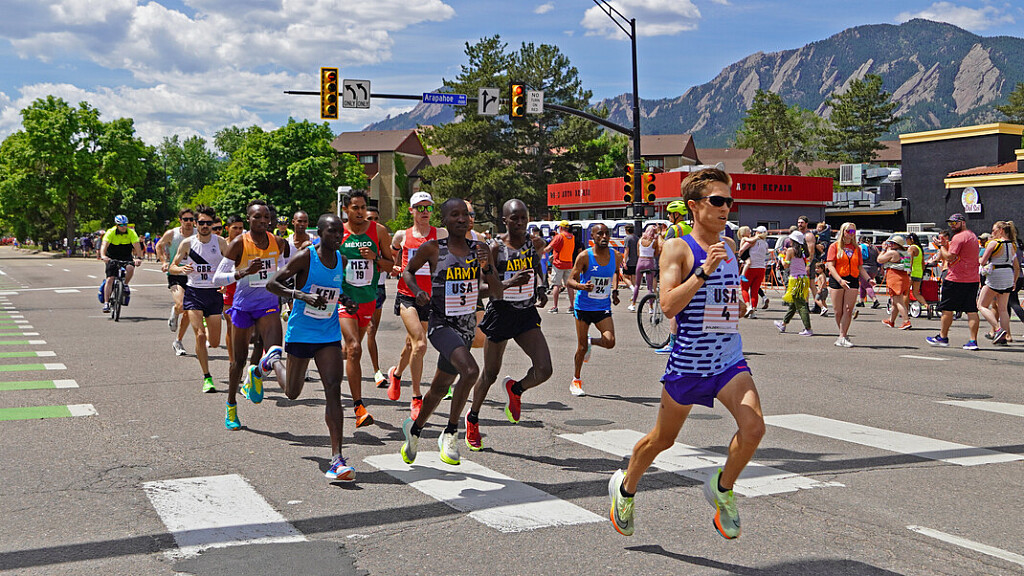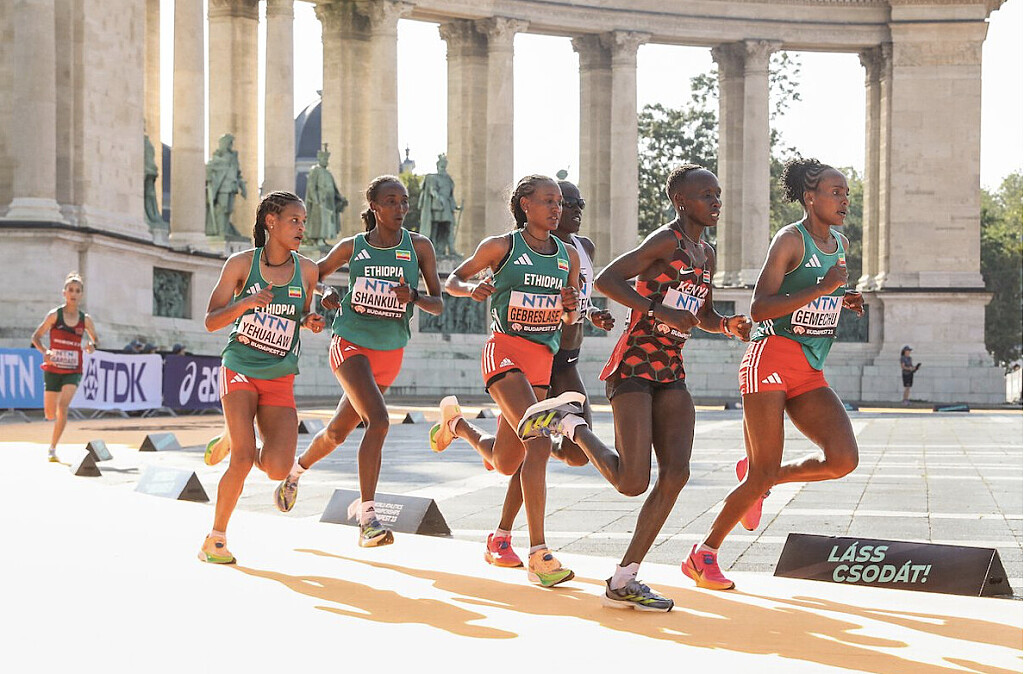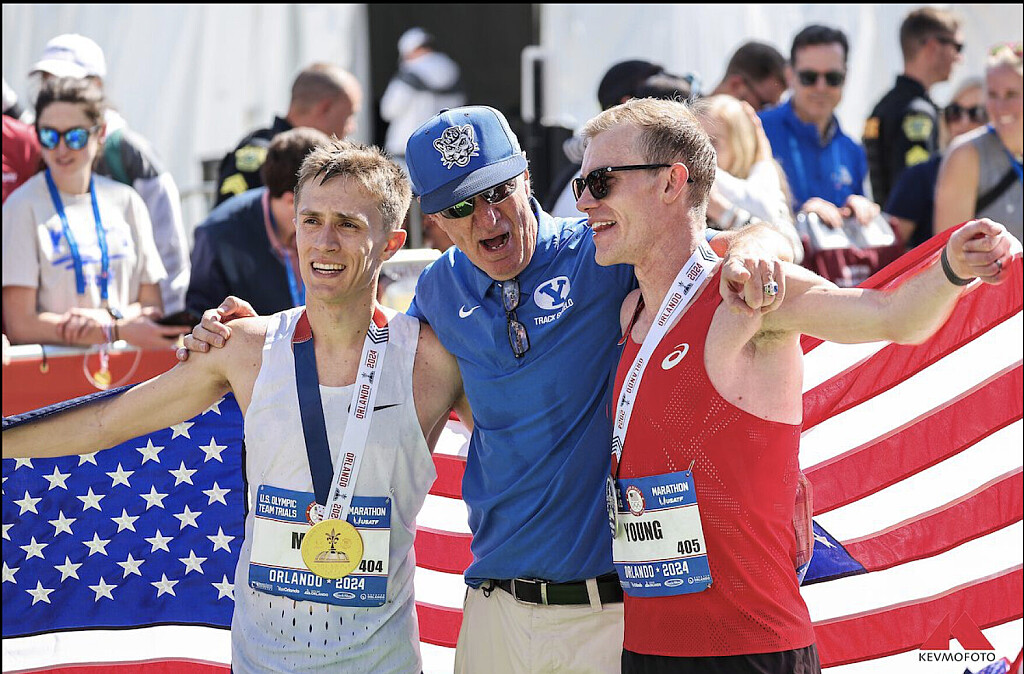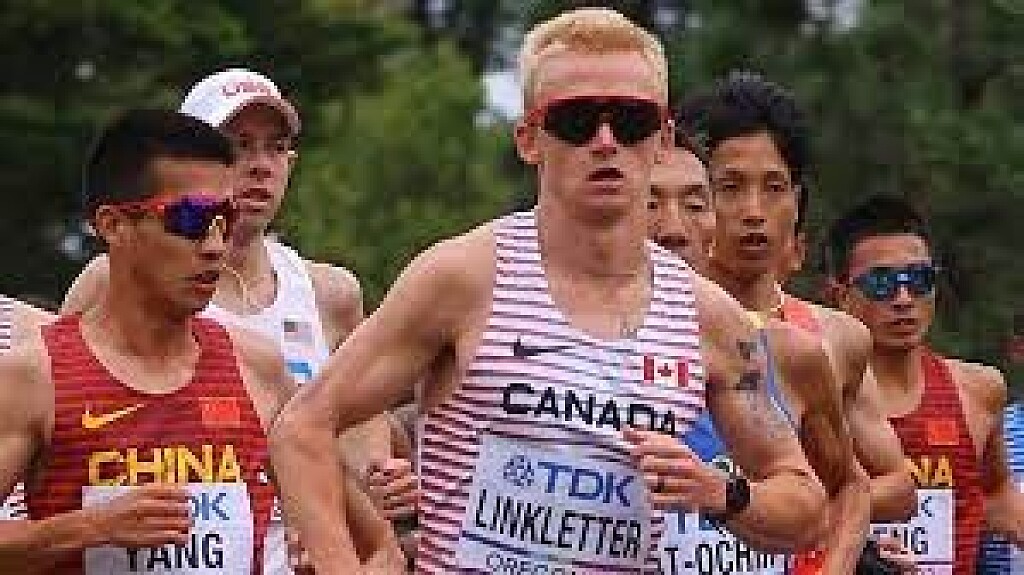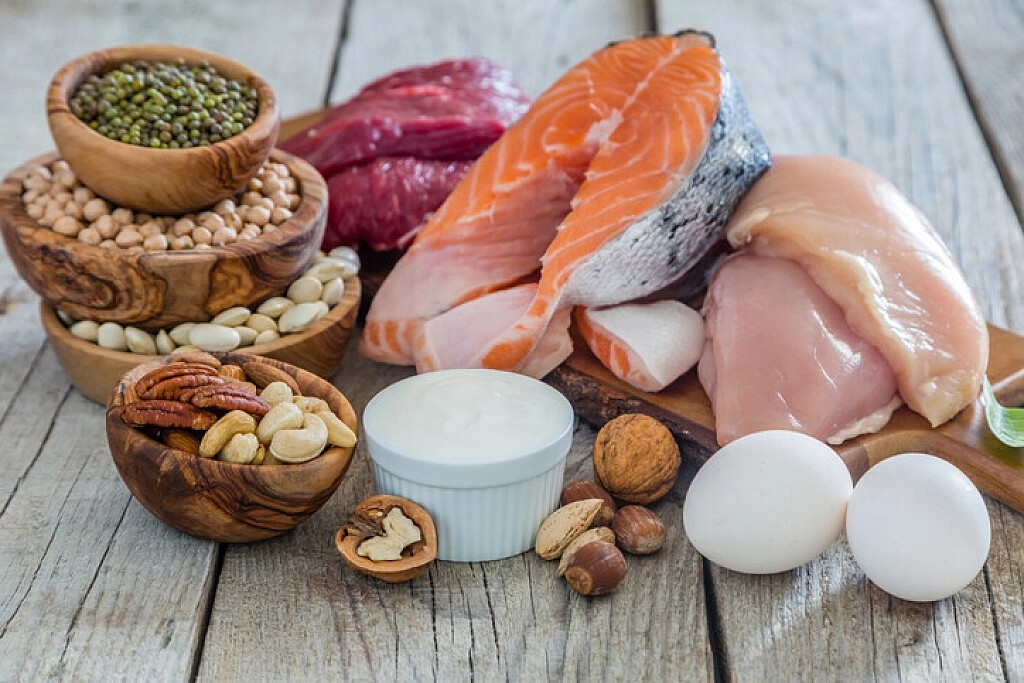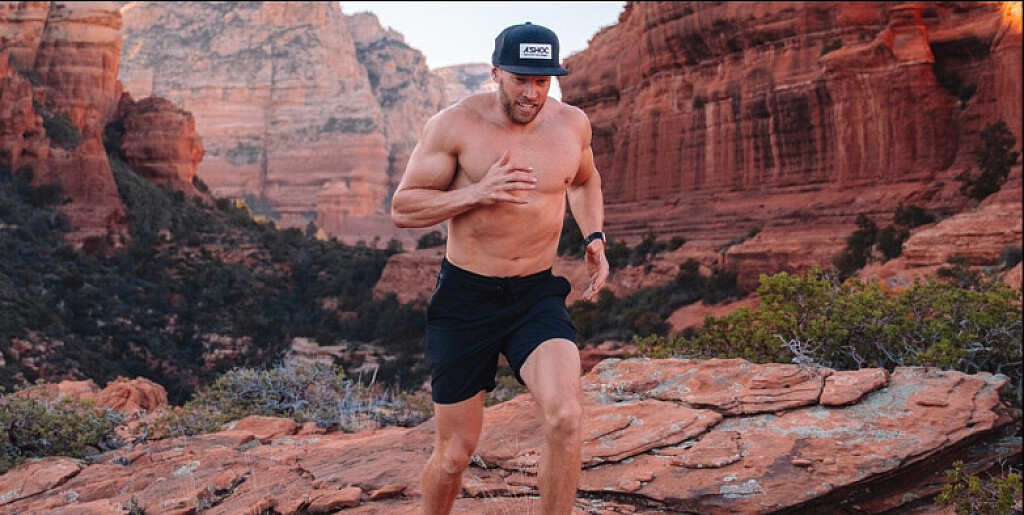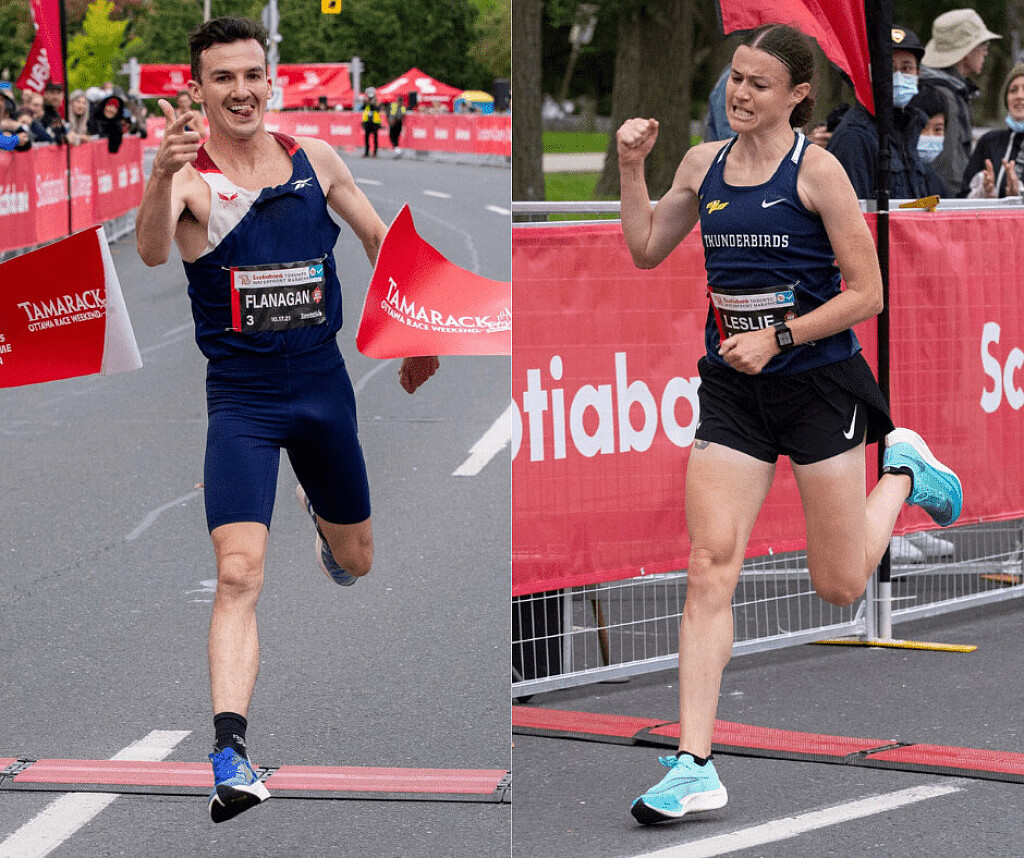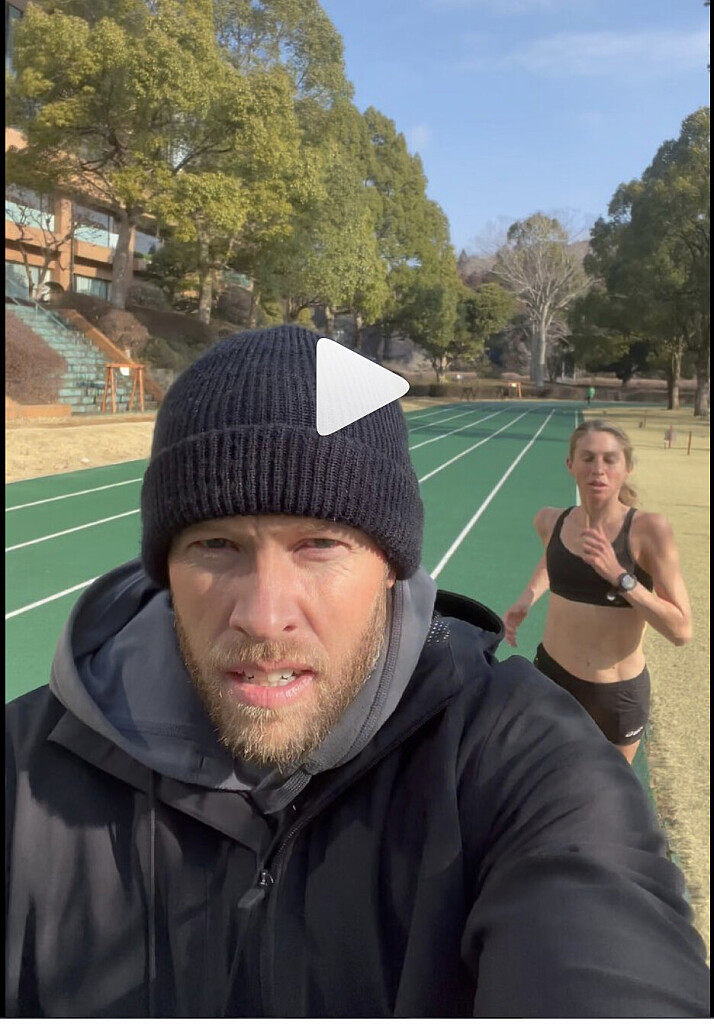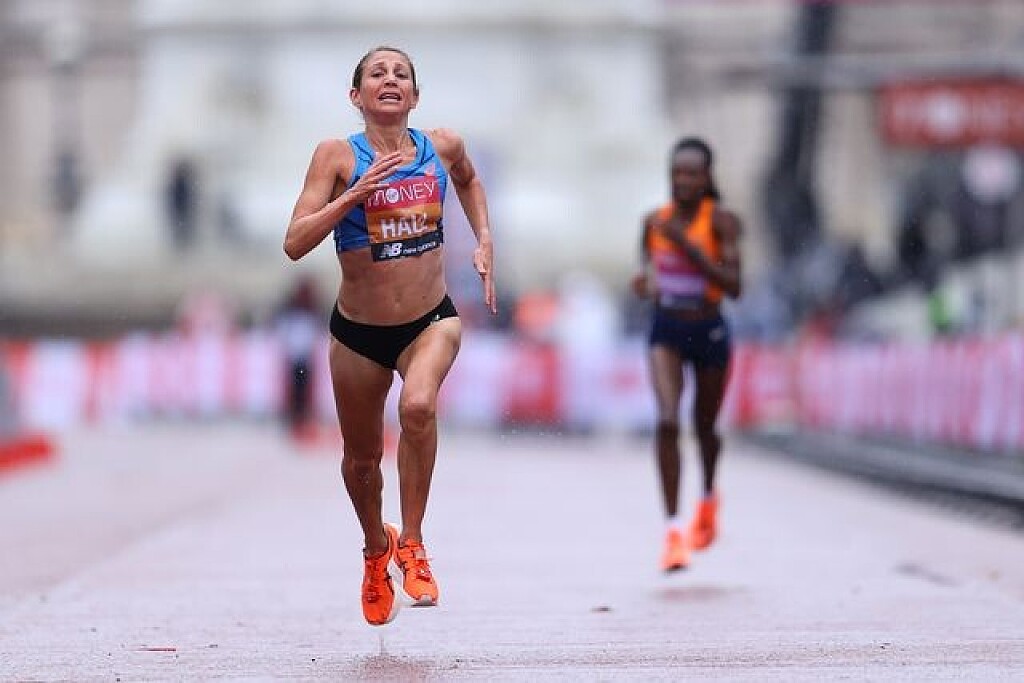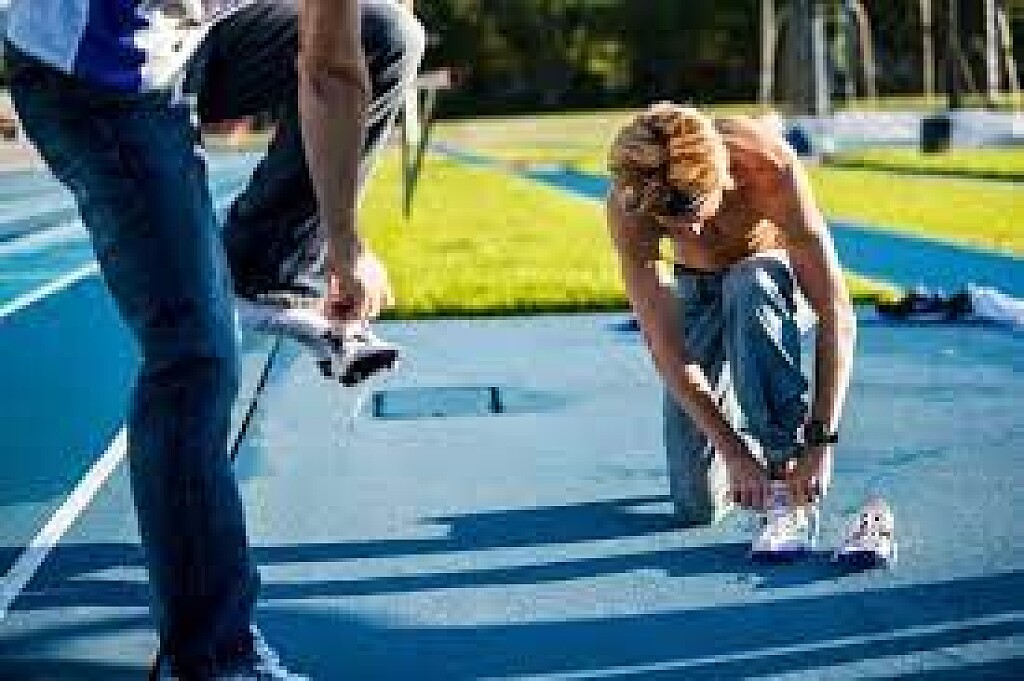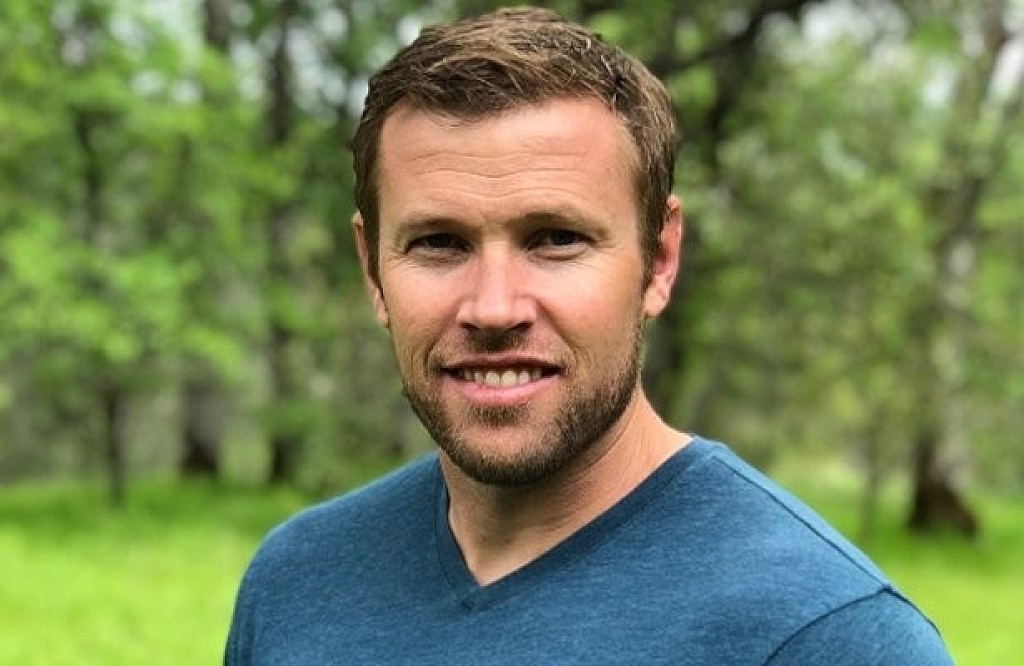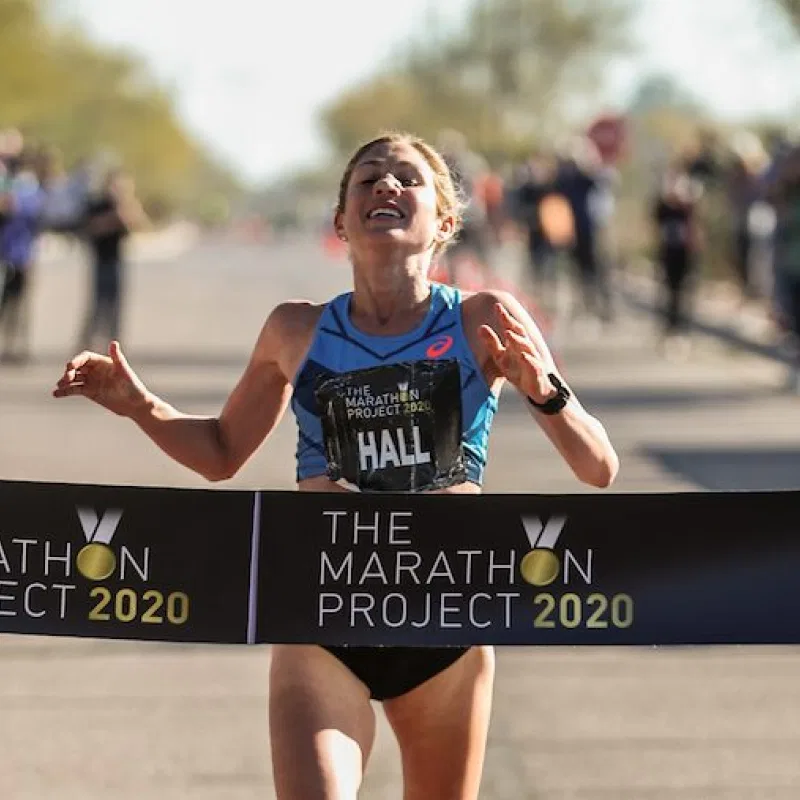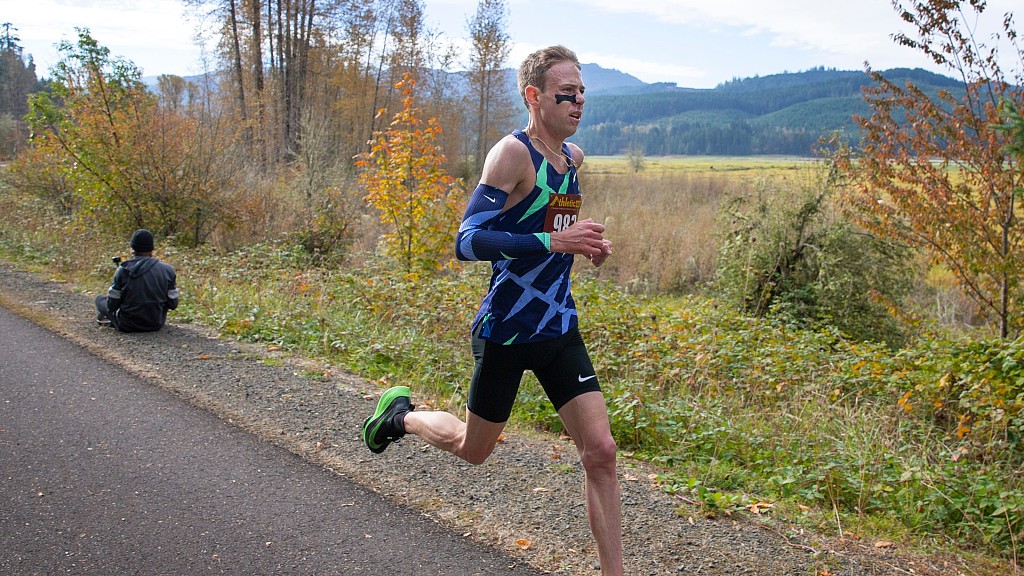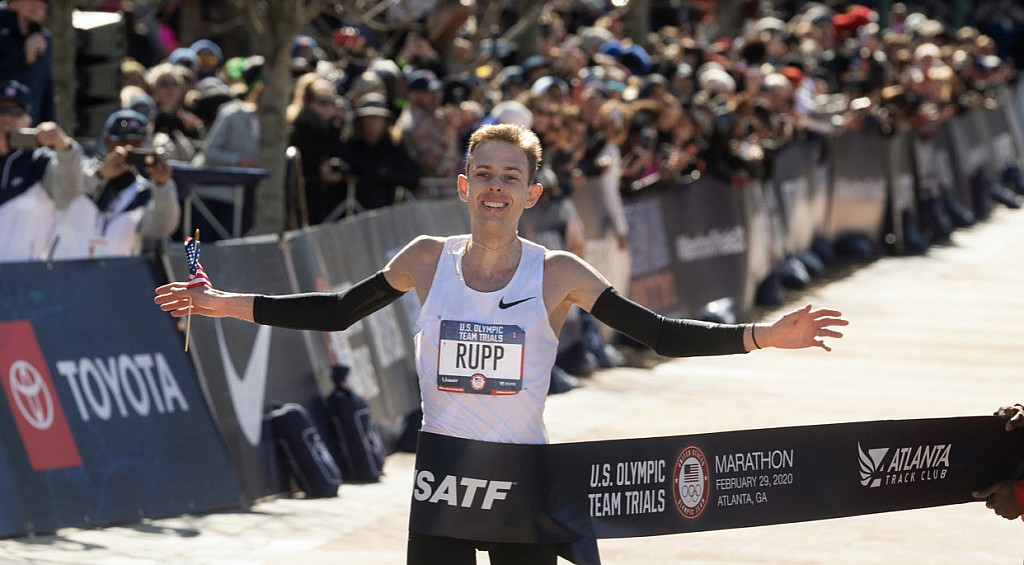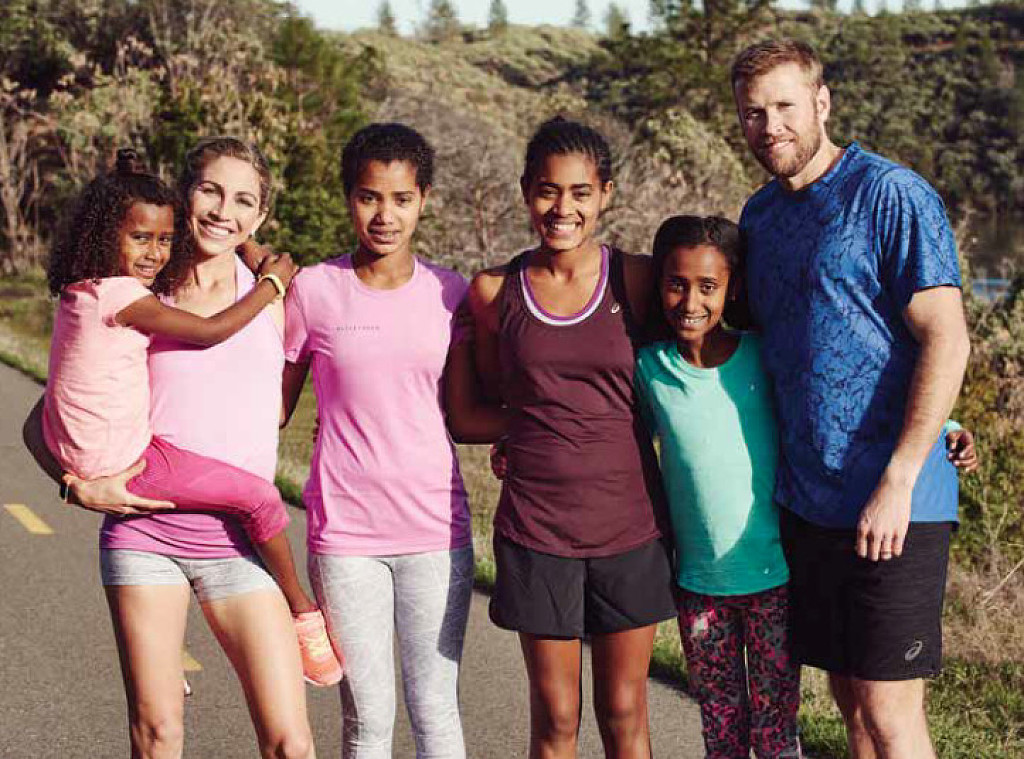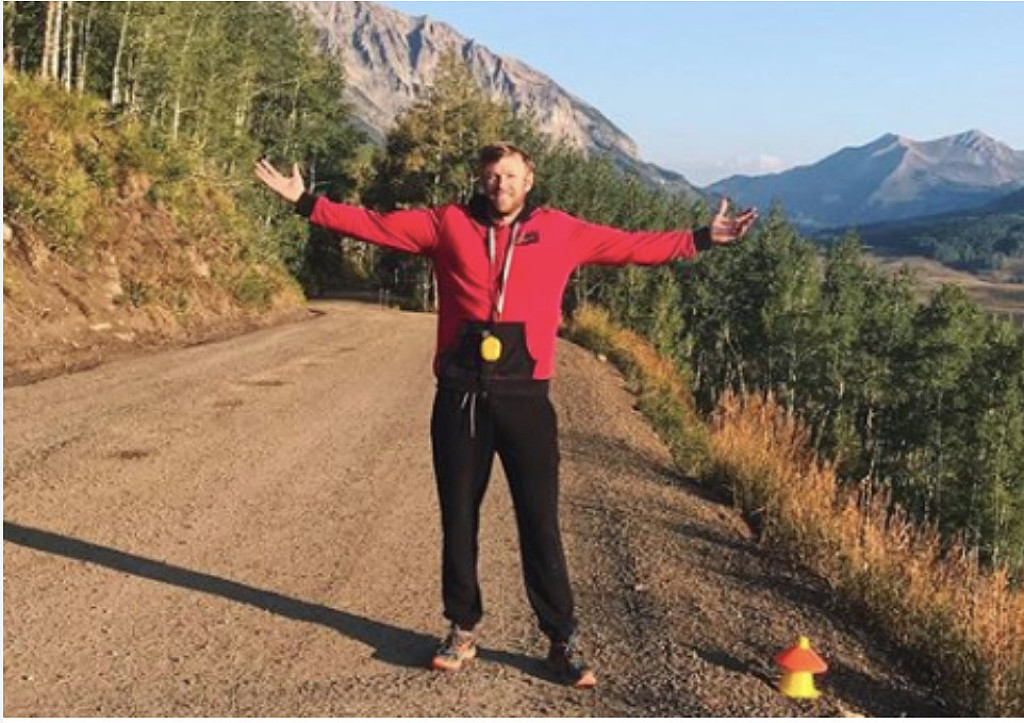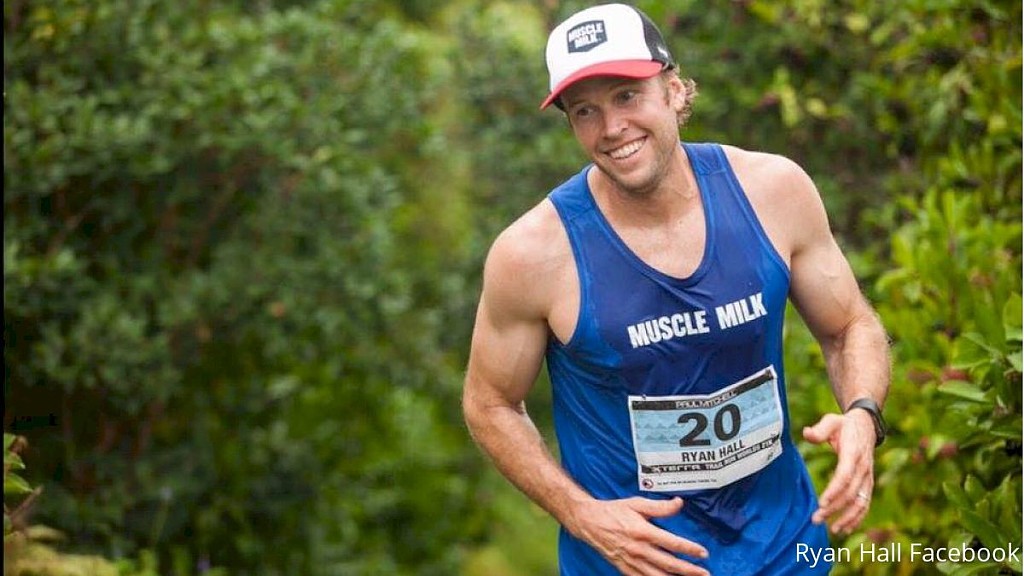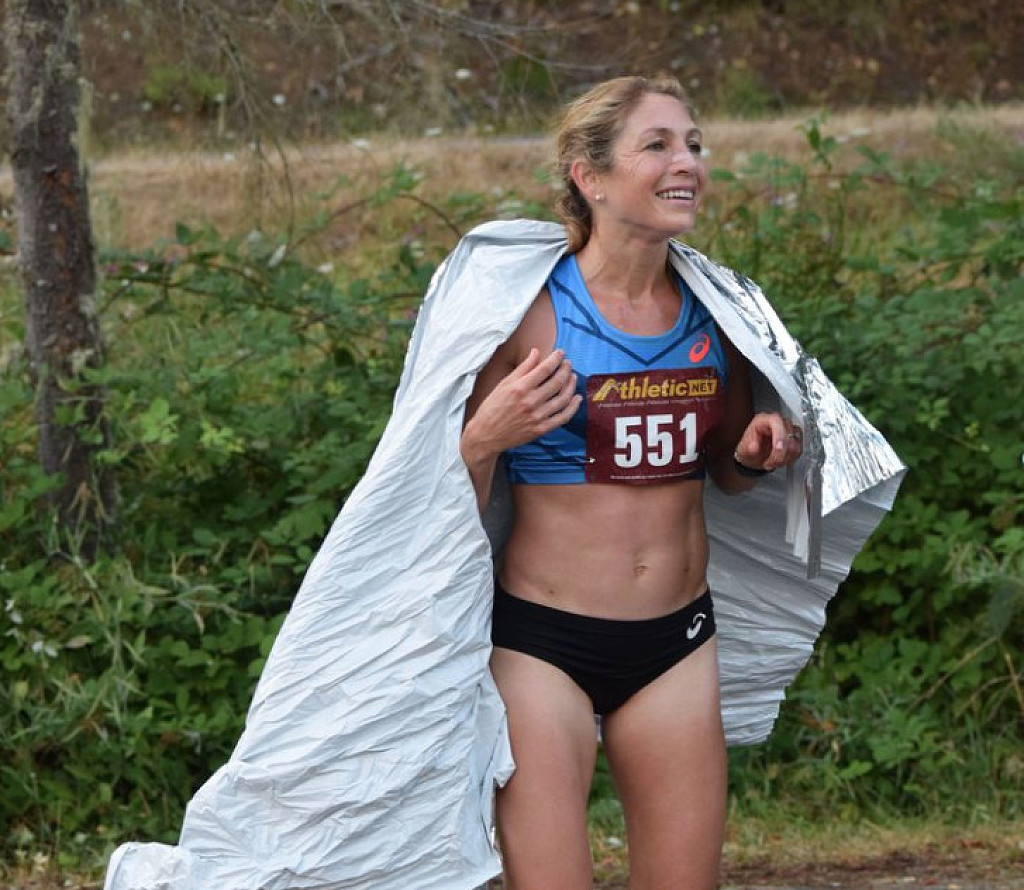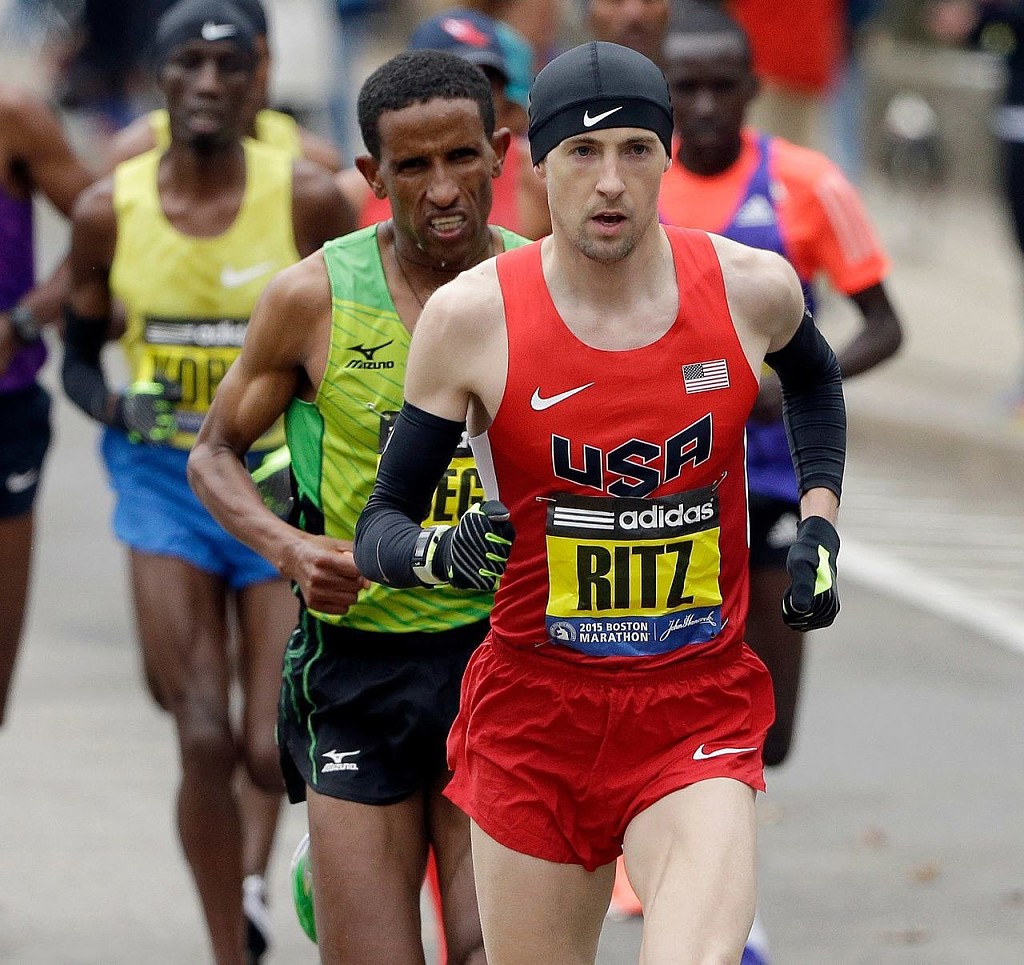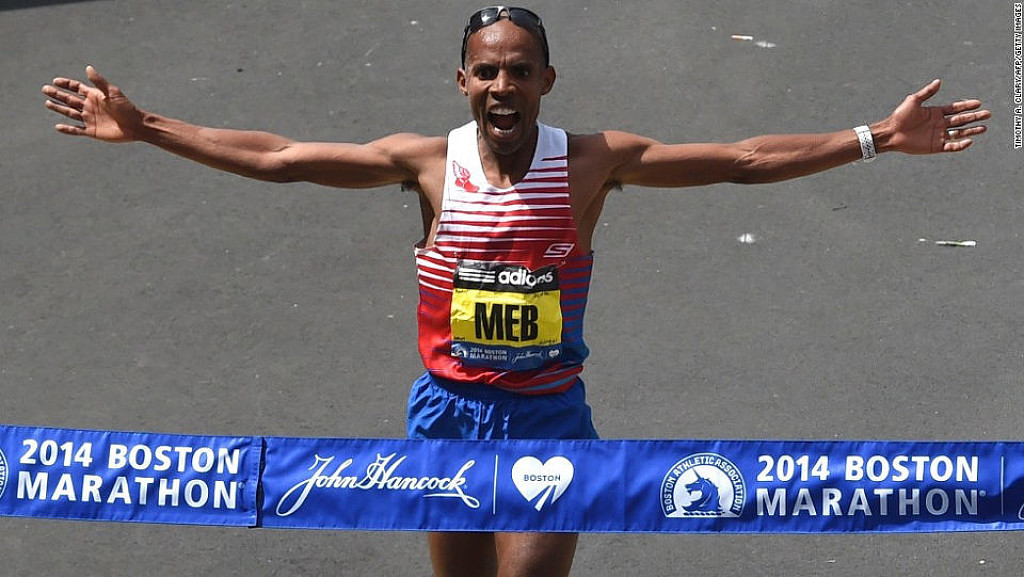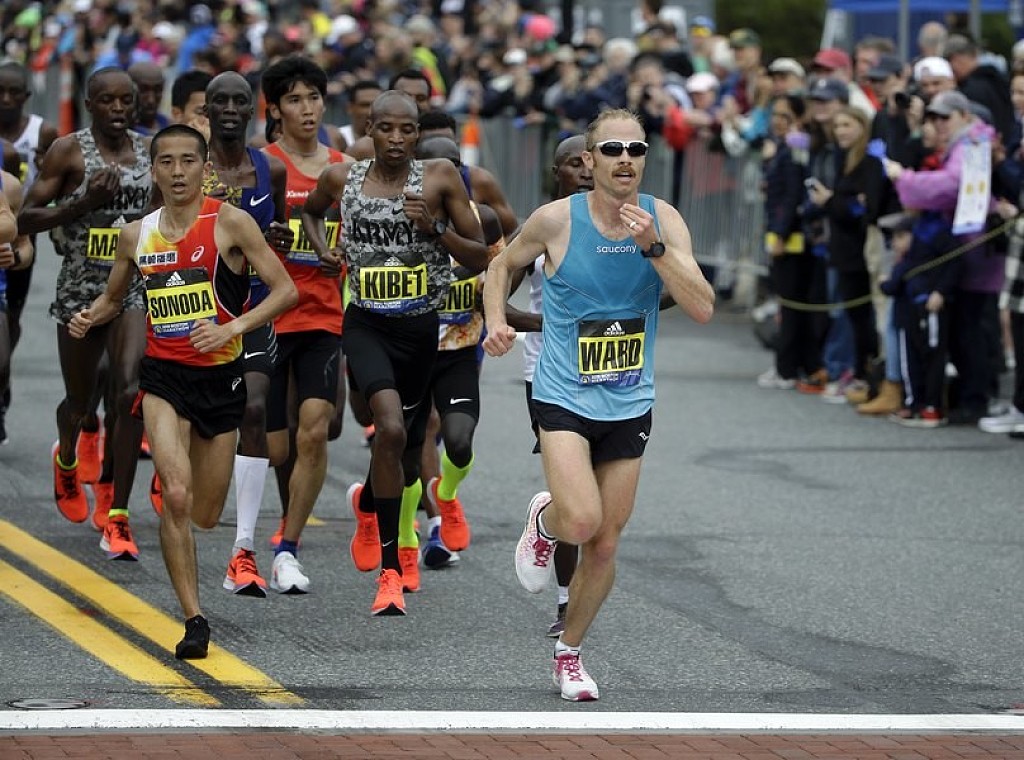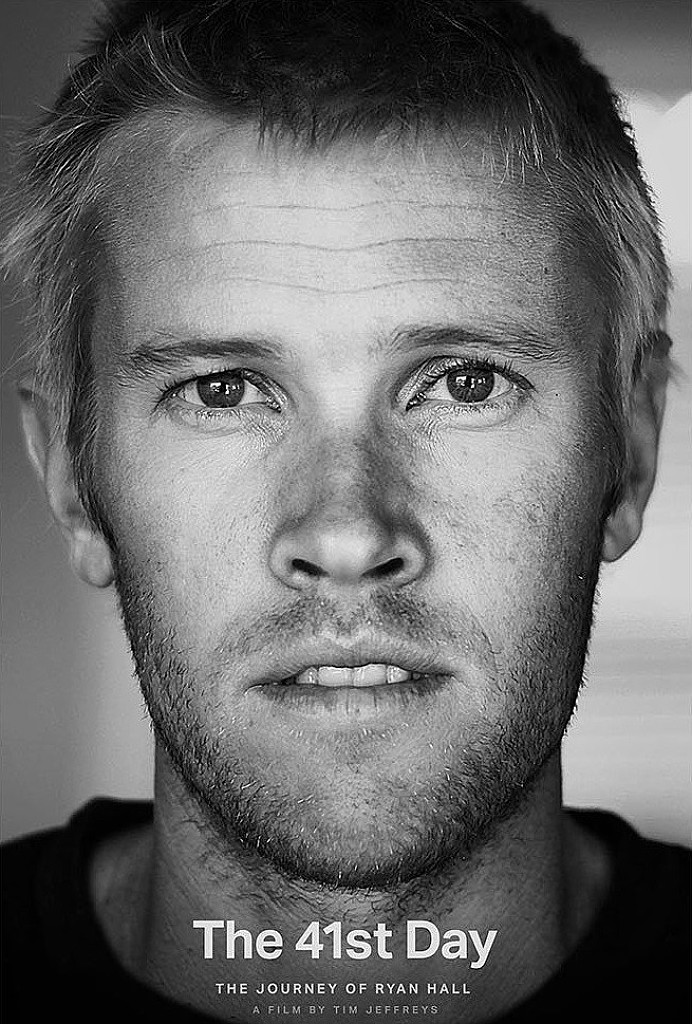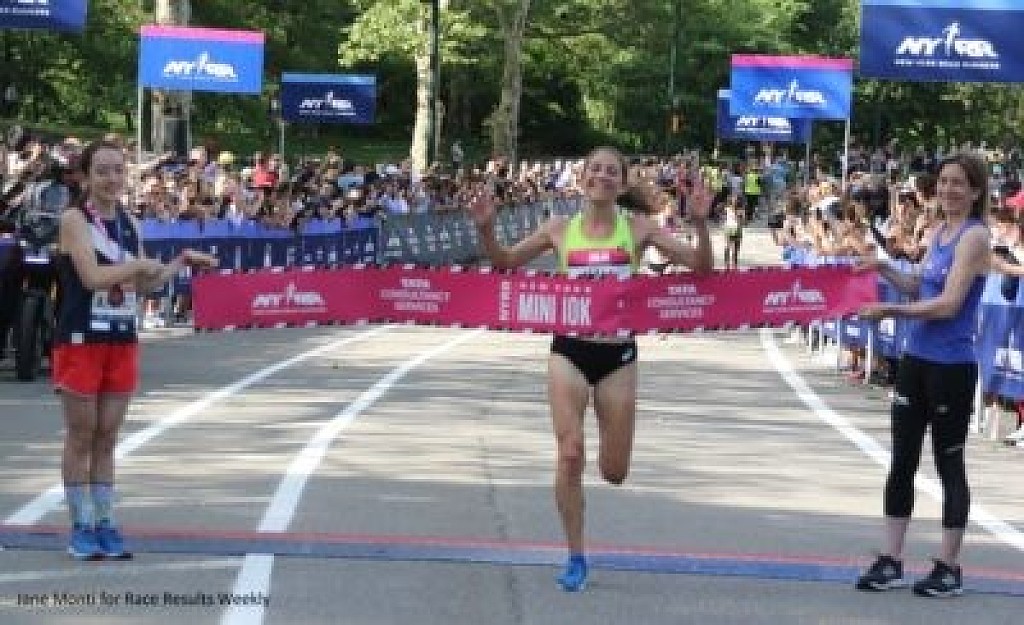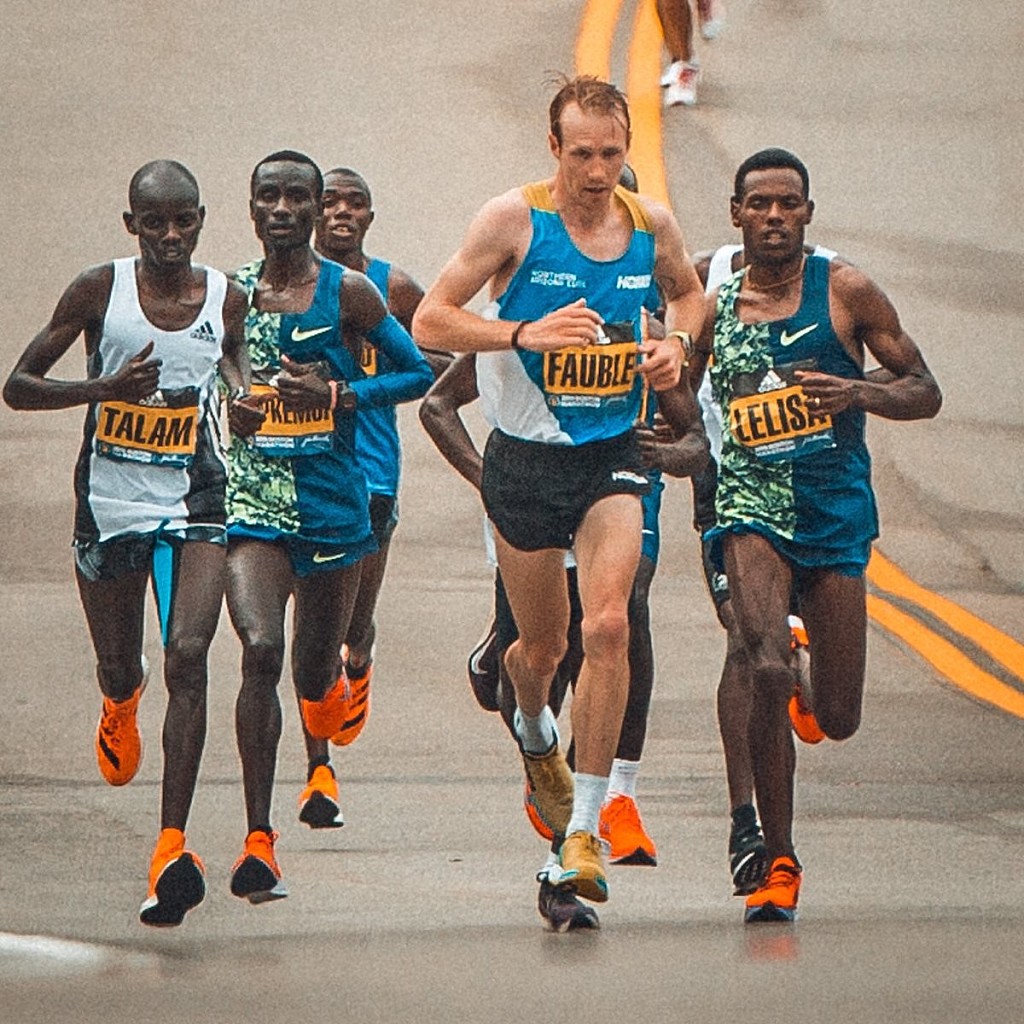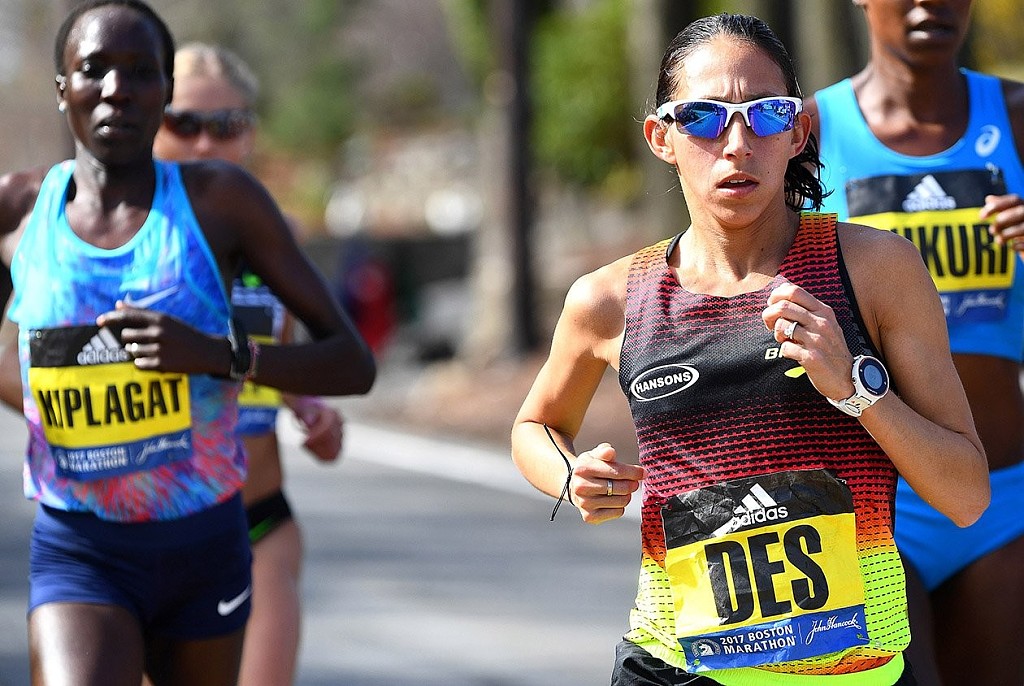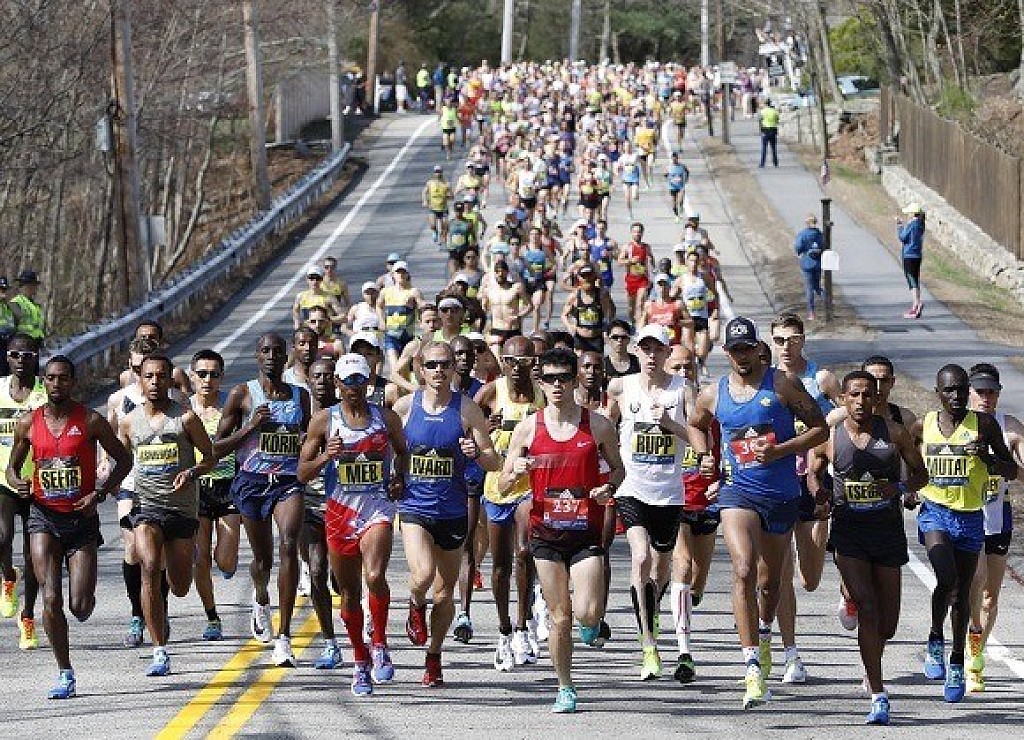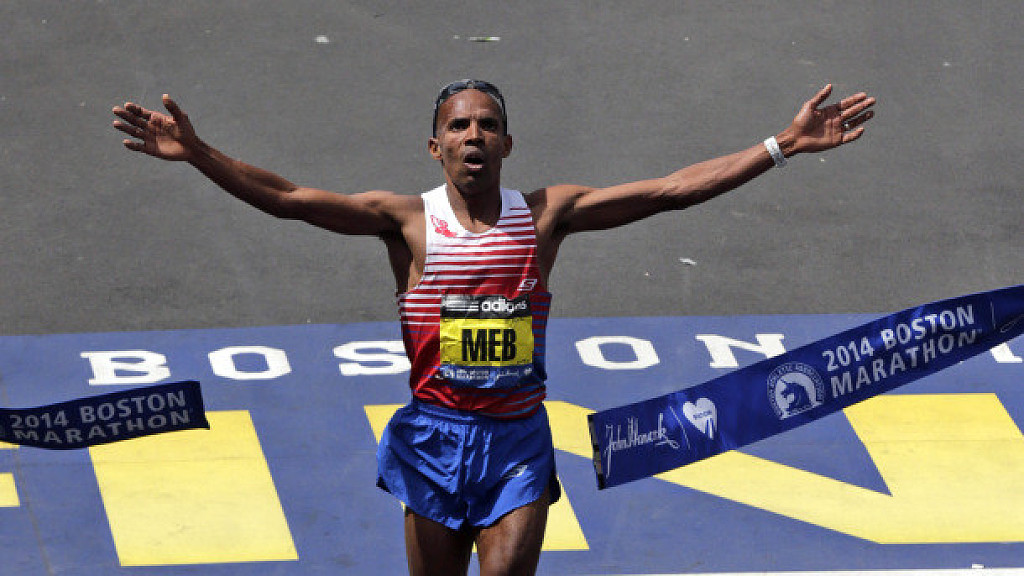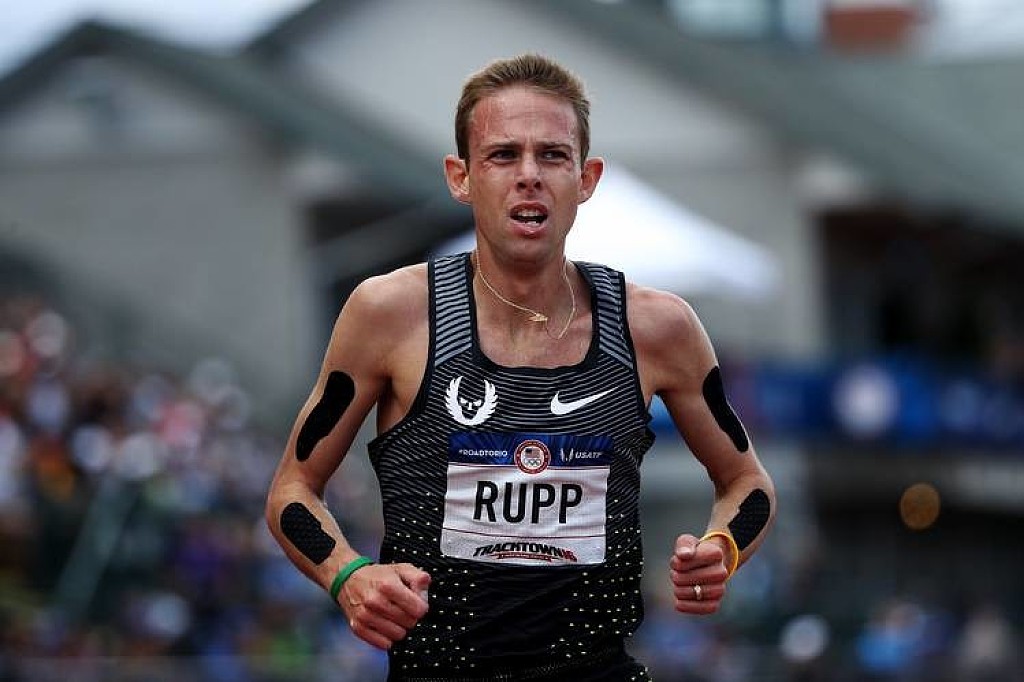Running News Daily
Running News Daily is edited by Bob Anderson. Send your news items to bob@mybestruns.com Advertising opportunities available. Train the Kenyan Way at KATA Kenya and Portugal owned and operated by Bob Anderson. Be sure to catch our movie A Long Run the movie KATA Running Camps and KATA Potato Farms - 31 now open in Kenya! https://kata.ke/
Index to Daily Posts · Sign Up For Updates · Run The World Feed
Articles tagged #Ryan Hall
Today's Running News
Conner Mantz’s Gritty Fourth-Place Finish at the 2025 Boston Marathon
In a performance that underscored his rising stature in American distance running, Conner Mantz delivered a personal best of 2:05:08 at the 2025 Boston Marathon, finishing fourth and narrowly missing a podium spot by just four seconds. This time stands as the second-fastest ever recorded by an American on the storied Boston course, trailing only Ryan Hall’s 2:04:58 from 2011.
A Race of Strategy and Resolve
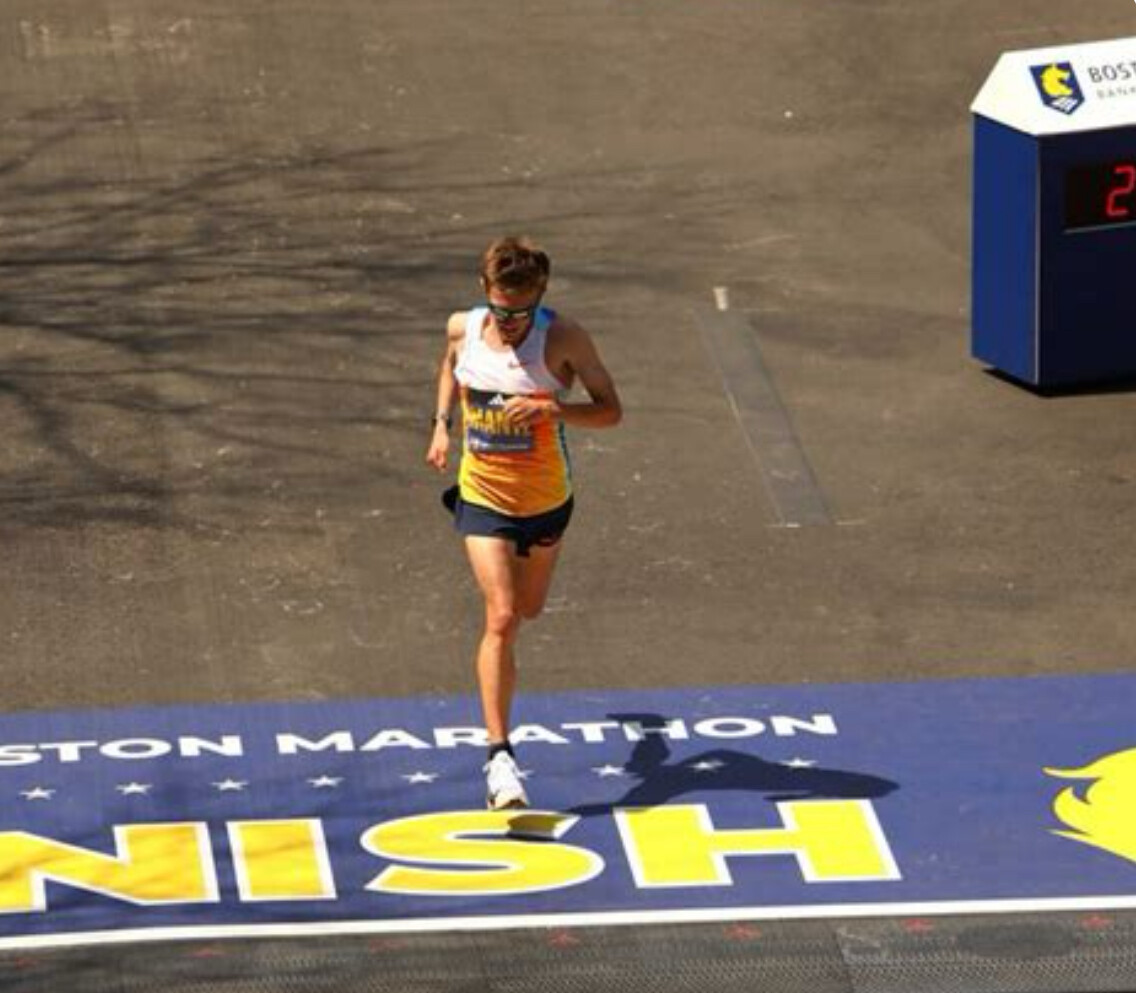
Mantz, 28, positioned himself strategically within the lead pack for much of the race. However, at the 20-mile mark, Kenya’s John Korir executed a decisive move around Heartbreak Hill, opening a 20-second gap that would eventually extend to nearly a minute. Korir went on to win the race in 2:04:45, the second-fastest winning time in Boston Marathon history.
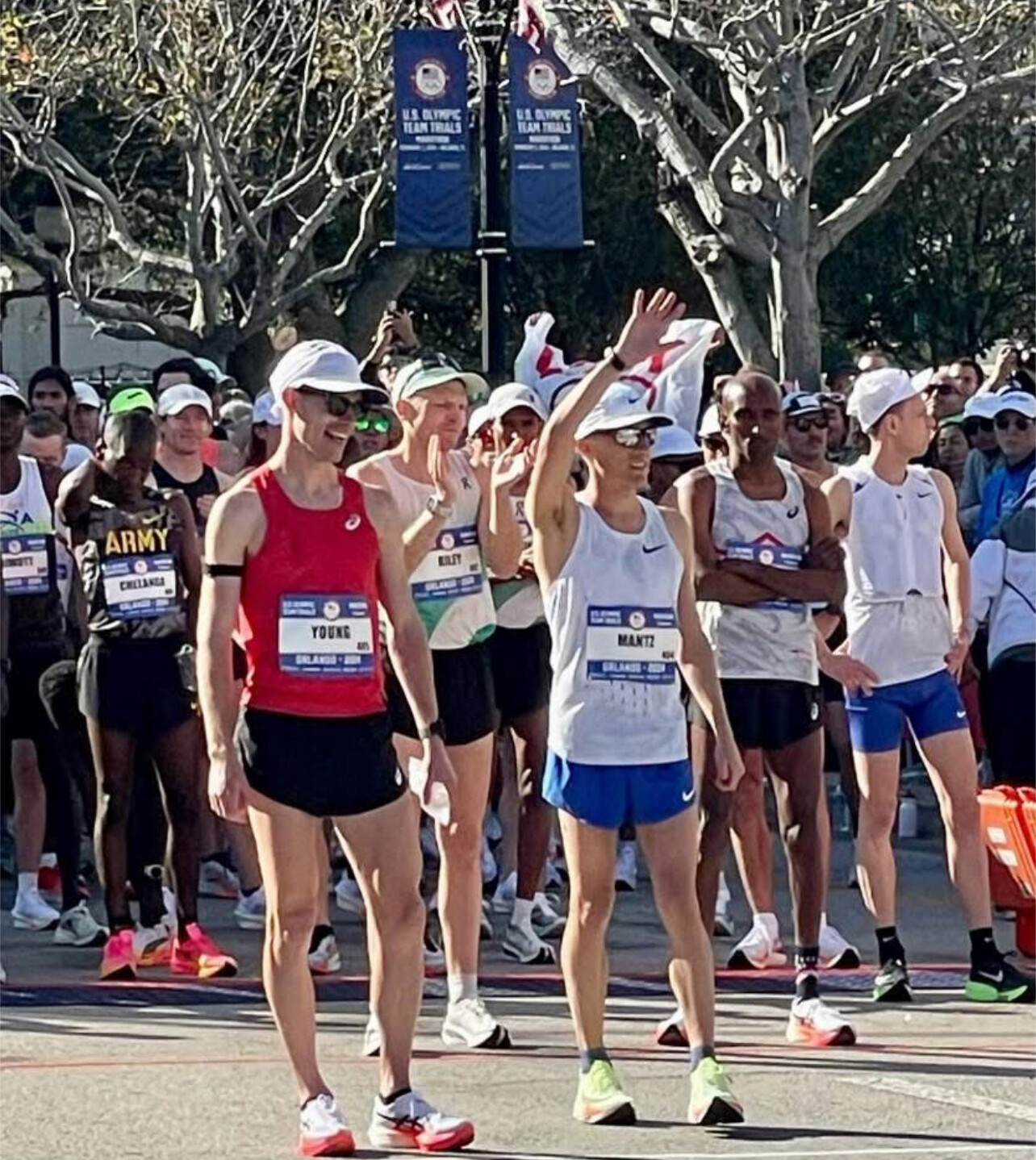
As Korir surged ahead, Mantz found himself in a fierce battle for the remaining podium spots with Tanzania’s Alphonce Simbu and Kenya’s Cybrian Kotut. The trio remained tightly grouped as they approached the final stretch on Boylston Street. Despite a valiant effort, Mantz was outkicked in the last 300 meters, finishing just behind Simbu and Kotut, who both clocked 2:05:04.
Reflections on a Career-Defining Race
After the race, Mantz reflected on the experience:
“I made my hard move and they responded as if I wasn’t there making a move. So it was a little bit humbling,” Mantz said. “Missing it and getting outkicked for the last 300 meters is a little bitter. It’s still probably the best race I’ve had.”
This performance marked a significant improvement over his previous personal best of 2:07:47, set at the 2023 Chicago Marathon, and his 11th-place finish at the 2023 Boston Marathon with a time of 2:10:25.
Building Momentum
Mantz’s Boston performance continues a series of impressive results. In January, he set a new American half-marathon record by finishing the Houston Half Marathon in 59:17, breaking Ryan Hall’s 18-year-old record.
His consistent excellence on the road has solidified his status as one of America’s premier long-distance runners.
Mantz’s achievements not only highlight his personal growth but also signal a resurgence in American distance running. As he continues to build on his successes, fans and fellow athletes alike will be watching closely to see how he performs in upcoming international competitions.
by Boris Baron
Login to leave a comment
A Day for the History Books: Korir and Lokedi Shine at the 2025 Boston Marathon
The 129th edition of the Boston Marathon, held Monday, April 21, 2025, delivered unforgettable drama and record-setting performances on the iconic route from Hopkinton to Boylston Street. Under near-perfect running conditions—mid-50s temperatures, low humidity, and a light tailwind—elite runners took full advantage, producing some of the fastest times in race history.
John Korir Claims His Crown and Continues a Family Legacy
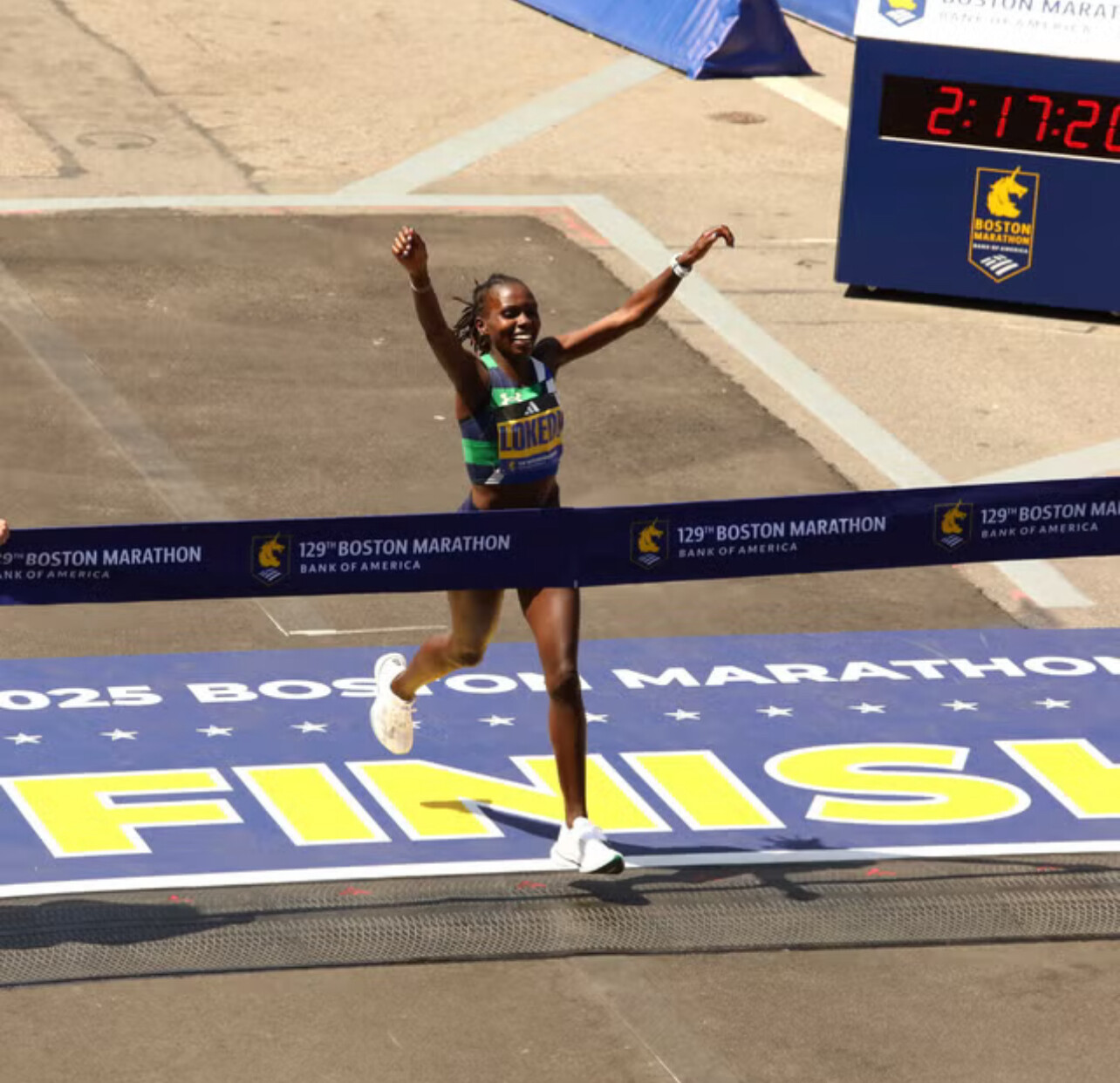
Kenya’s John Korir won the men’s race in a sensational 2:04:45, the second-fastest time ever run on the Boston course. The younger brother of 2012 Boston champion Wesley Korir, John added another chapter to his family’s Boston legacy by not only conquering the challenging course but doing so in dominant fashion.
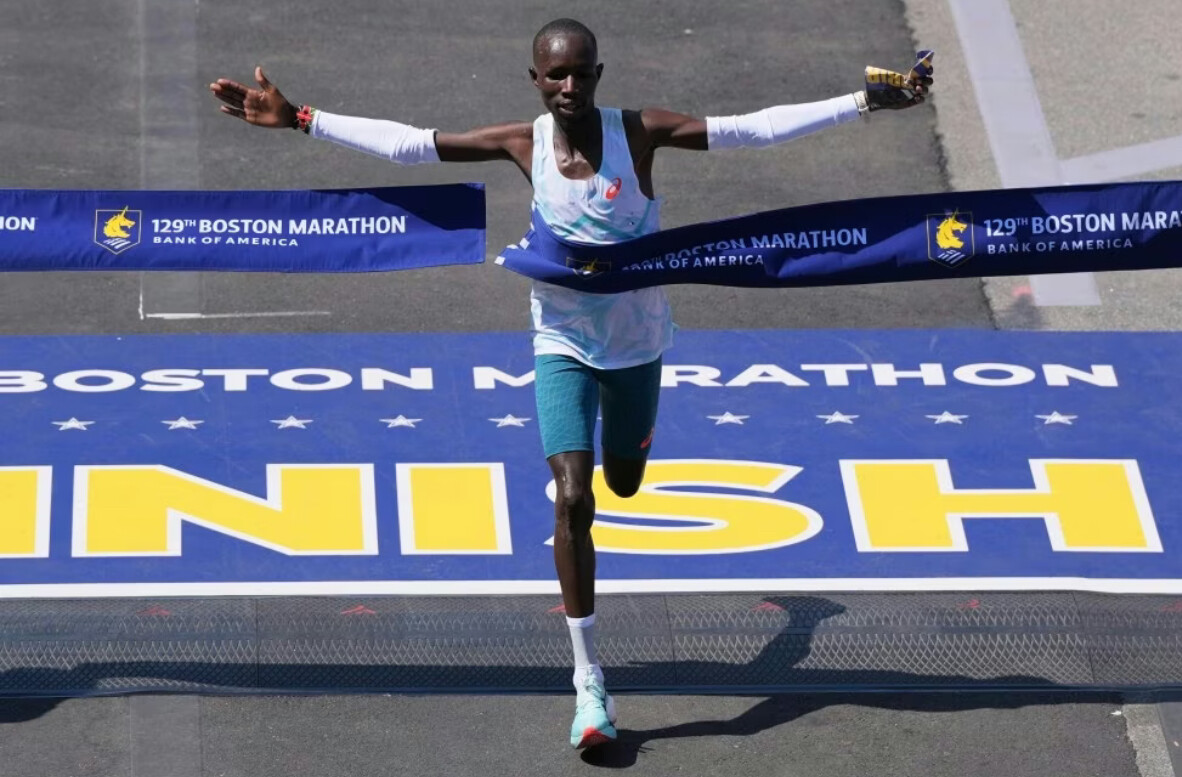
Despite a minor fall early in the race, Korir surged away from a deep international field after 20 miles, building a gap that no one could close. His finishing time was just over a minute shy of Geoffrey Mutai’s legendary 2:03:02 from 2011—the fastest time ever run in Boston but not eligible as a world record due to the course layout.
“I knew I was ready for something big,” Korir said post-race. “To follow in my brother’s footsteps and win Boston means everything.”
American hopes were high coming into the race, and Conner Mantz did not disappoint. Running a massive personal best of 2:05:08, he placed fourth overall and became the second-fastest American ever on the Boston course, behind only Ryan Hall’s 2:04:58 (set in 2011).
Sharon Lokedi Breaks the Tape—and the Record
The women’s race was equally historic. Sharon Lokedi, who won the 2022 New York City Marathon, delivered the performance of her life to win in 2:17:22, a new Boston Marathon course record, smashing the previous mark of 2:19:59 set by Buzunesh Deba in 2014.
Lokedi ran a smart, strategic race. She stayed tucked in a lead pack through the Newton Hills and then launched a powerful surge at mile 24, dropping two-time Boston champion Hellen Obiri and the rest of the field. Obiri finished second in a personal best 2:18:10, making it a Kenyan 1-2 sweep on the women’s podium.
“This course is tough, but I felt strong the whole way,” Lokedi said. “To run a course record here—it’s just unbelievable.”
Top 10 Elite Men – 2025 Boston Marathon
1. John Korir (Kenya) – 2:04:45
2. Alphonce Simbu (Tanzania) – 2:05:04
3. Cybrian Kotut (Kenya) – 2:05:04
4. Conner Mantz (USA) – 2:05:08
5. Muktar Edris (Ethiopia) – 2:05:59
6. Rory Linkletter (Canada) – 2:07:02
7. Clayton Young (USA) – 2:07:04
8. Tebello Ramakongoana (Lesotho) – 2:07:19
9. Daniel Mateiko (Kenya) – 2:07:52
10. Ryan Ford (USA) – 2:08:00
Top 10 Elite Women – 2025 Boston Marathon
1. Sharon Lokedi (Kenya) – 2:17:22 (Course Record)
2. Hellen Obiri (Kenya) – 2:17:41
3. Yalemzerf Yehualaw (Ethiopia) – 2:18:06
4. Irine Cheptai (Kenya) – 2:21:32
5. Amane Beriso (Ethiopia) – 2:21:58
6. Calli Thackery (Great Britain) – 2:22:38
7. Jess McClain (USA) – 2:22:43
8. Annie Frisbie (USA) – 2:23:21
9. Stacy Ndiwa (Kenya) – 2:23:29
10. Tsige Haileslase (Ethiopia) – 2:23:43
Notable American Performances
• Emma Bates finished 13th with a time of 2:25:10.
• Dakotah Popehn secured 16th place in 2:26:09.
• Des Linden completed her 28th and final professional marathon, finishing 17th in 2:26:19.
• Sara Hall placed 18th with a time of 2:26:32.
Looking Ahead
The 2025 Boston Marathon reaffirmed its place as one of the world’s premier races—not just for its history and prestige, but for its ability to showcase incredible athletic achievement. With deep American performances and Kenyan dominance at the front, it sets the stage for an exciting year.
For fans, runners, and historians, this year’s Boston will go down as one of the most memorable ever.
My Best Runs
Your front row seat to the world of running
by Boris Baron
Login to leave a comment
Boston Marathon
Among the nation’s oldest athletic clubs, the B.A.A. was established in 1887, and, in 1896, more than half of the U.S. Olympic Team at the first modern games was composed of B.A.A. club members. The Olympic Games provided the inspiration for the first Boston Marathon, which culminated the B.A.A. Games on April 19, 1897. John J. McDermott emerged from a...
more...Sara Hall Returns to Boston Marathon, Continuing a Legacy of Excellence
Sara Hall, one of America’s most accomplished marathoners, is set to compete in the 129th Boston Marathon on April 21, 2025. This marks her fourth appearance in Boston, where she aims to build upon her impressive track record.
Hall’s personal best in the marathon is 2:20:32, achieved at The Marathon Project in 2020, making her the fourth-fastest American woman in history at the distance. In 2024, she finished 15th overall and was the second American woman at the Boston Marathon with a time of 2:27:58. Later that year, she broke her own American masters record by running 2:23:45 at the Valencia Marathon .
Hall’s versatility is evident in her achievements across various distances. She set an American half marathon record of 1:07:15 in 2022 and has won 10 U.S. national titles, uniquely securikng championships in both the mile and the marathon. Her international accolades include a gold medal in the 3,000m steeplechase at the 2011 Pan American Games .
Beyond her athletic prowess, Hall is known for her commitment to philanthropy. She and her husband, Ryan Hall, a former U.S. Olympian and American record holder in the half marathon, co-founded the Hall Steps Foundation, which focuses on combating global poverty. In 2015, they adopted four sisters from Ethiopia, expanding their family and deepening their connection to the global community .
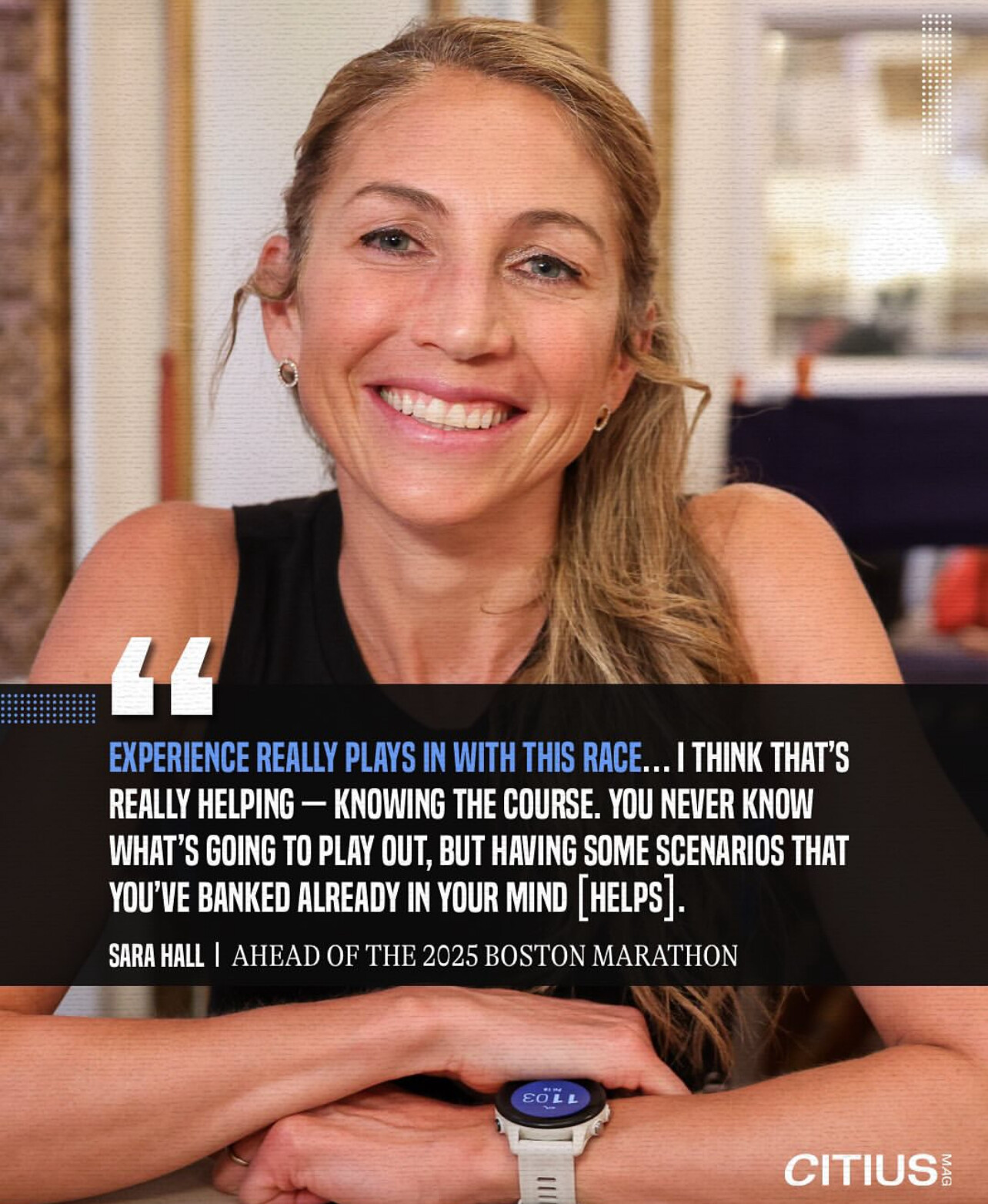
As Hall prepares for the 2025 Boston Marathon, she continues to inspire with her dedication, resilience, and contributions both on and off the course.
by Boris Baron
Login to leave a comment
The Global Sub-60 Chase: Why Breaking 60 Minutes in the Half Marathon Is the New Benchmark
In the world of distance running, certain time barriers carry iconic weight: the four-minute mile, the two-hour marathon, and now, perhaps more than ever before, the sub-60-minute half marathon.
Running 13.1 miles at an average pace of under 4:35 per mile (approximately 2:50 per kilometer) was once a feat reserved for only a handful of legends. Today, more than 100 men have accomplished the mark—transforming what was once historic into a new global benchmark. From the streets of Valencia to the avenues of Houston, the sub-60 chase has reshaped the competitive landscape.

At the heart of this movement is Uganda’s Jacob Kiplimo, arguably the most exciting half marathoner on the planet. In 2021, Kiplimo smashed the world record by clocking 57:31 in Lisbon, Portugal—a performance that combined raw power, impeccable pacing, and near-perfect weather. His fluid stride and ability to surge at will have made him the gold standard for half marathon excellence.
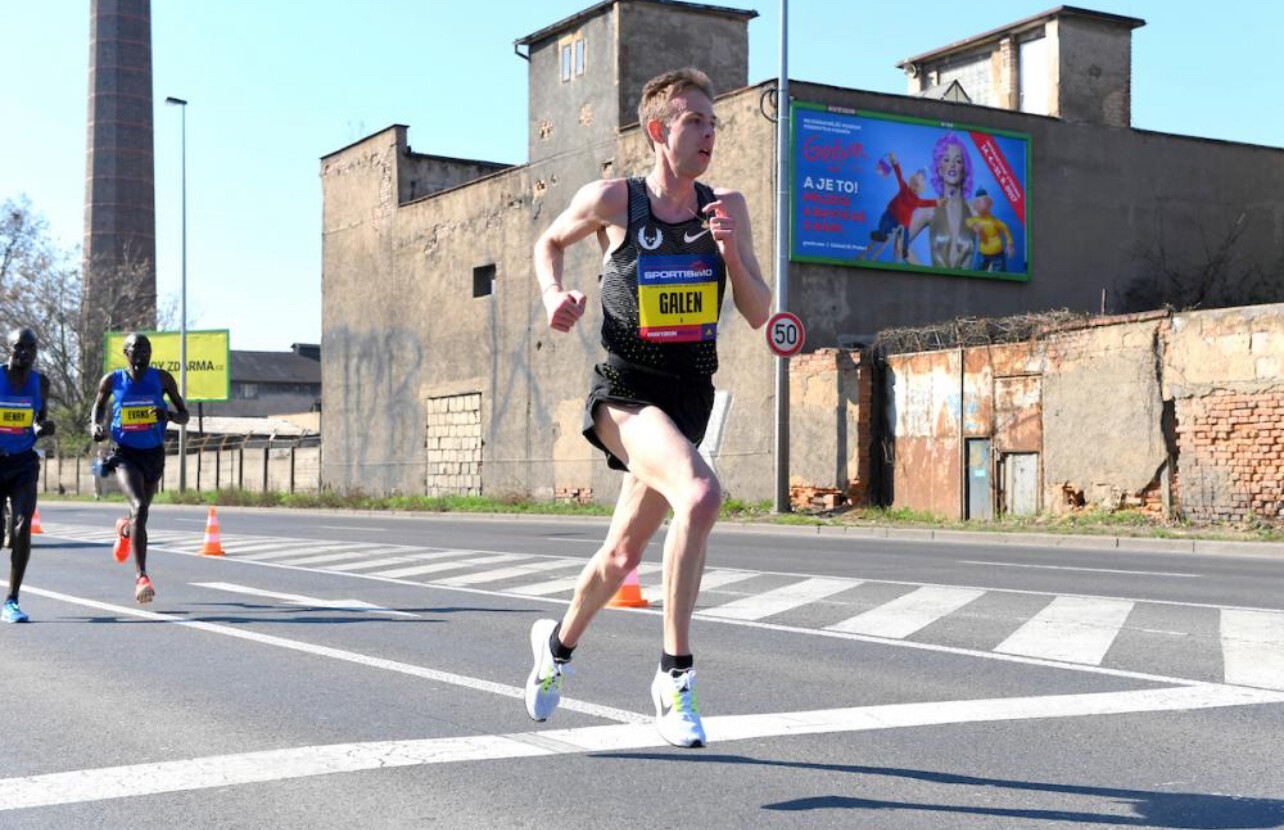
Kiplimo’s brilliance lies not just in his times, but in his consistency. He’s one of the few runners who can deliver near-world-record performances while battling the best in championship-style races, such as his victory at the 2020 World Half Marathon Championships in Gdynia, Poland.
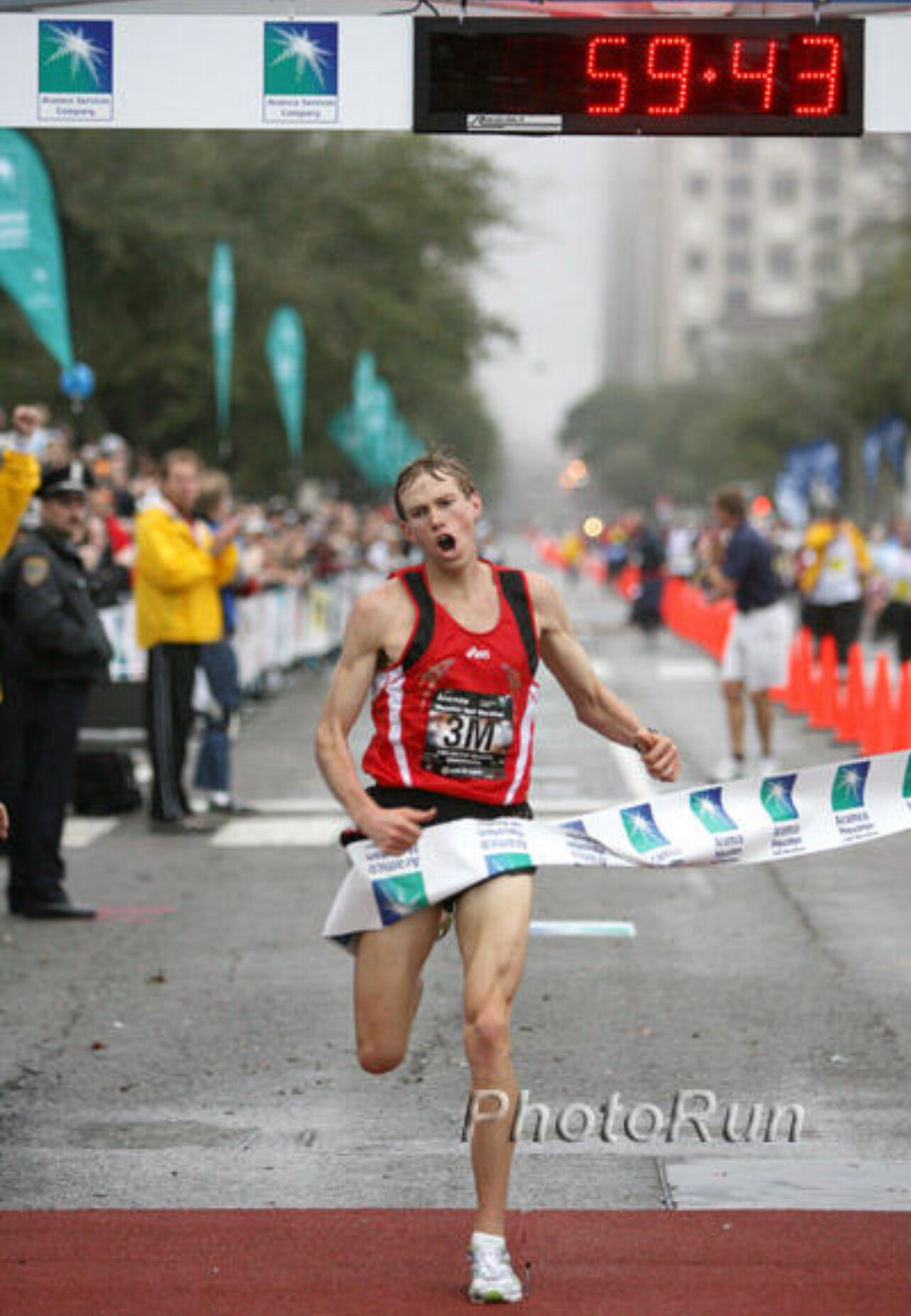
So, what does it take to go sub-60? It’s more than just genetic talent. Athletes training at the Kenyan Athletics Training Academy (KATA) in Thika and at the KATA Retreat in Portugal are learning that going under an hour requires a perfect storm of speed, endurance, tactical racing, and recovery. Former 2:07 marathoner Jimmy Muindi, now coaching at KATA Portugal, emphasizes the importance of training specificity: “It’s not just about the miles—it’s about the right workouts, at the right time, and the right rest.”
Technology has also played its part. Super shoes, optimized pacing, and faster courses have contributed to faster times, but the core remains the same: the athlete. And sub-60 remains a sacred number—an invisible finish line that continues to pull the best out of the world’s elite.
American Runners Breaking the Sub-60 Barrier
For years, American distance running lagged behind East African dominance in the half marathon. However, significant breakthroughs have occurred over the past two decades:
• Ryan Hall made history in 2007 by becoming the first American to break the one-hour barrier, finishing the Houston Half Marathon in 59:43. This performance stood as the American record for 18 years.
• Galen Rupp, a two-time Olympic medalist, joined the sub-60 club in 2018 with a time of 59:47 at the Roma-Ostia Half Marathon, showcasing his versatility across distances.
• Conner Mantz recently set a new American record by completing the Houston Half Marathon in 59:17, demonstrating the rising talent in U.S. distance running.
These achievements signify a new era for American distance runners, who are now competing at the highest levels on the global stage.
“The new super shoes have helped runners from at least 10 countries achieve a sub-60-minute half marathon,” says MBR editor Bob Anderson.
This surge in international performances underscores the evolving landscape of elite distance running, where advancements in technology and training are enabling athletes worldwide to reach new milestones.
With the 2025 racing calendar heating up, all eyes will be on the next generation of half marathoners. Who will be the next to join Kiplimo in the sub-58 club? And how long until sub-59 becomes the norm?
As the sport evolves, one thing is clear: the chase for sub-60 isn’t just about times—it’s about what’s possible.
by Bob Anderson with Boris Baron
Login to leave a comment
More about Conner Mantz: From Utah Prodigy to American Record Holder
Conner Mantz's journey from a young running enthusiast in Utah to an American record holder is a testament to his unwavering dedication and exceptional talent. Born on December 8, 1996, in Logan, Utah, Mantz's early passion for running set the stage for a remarkable career in long-distance running.
Mantz's affinity for running became evident at a young age. At just 12, he completed his first half marathon, igniting a fervor for the sport. By 14, he impressively finished a half marathon in 1:11:24, maintaining an average pace of 5:26.8 minutes per mile. During his time at Sky View High School in Smithfield, Utah, Mantz distinguished himself as a three-time All-American at the Foot Locker Cross Country Championships. His prowess also earned him a spot on Team USA at the 2015 IAAF World Cross Country Championships in Guiyang, China, where he placed 29th in the junior race, leading the team to a commendable sixth-place finish.
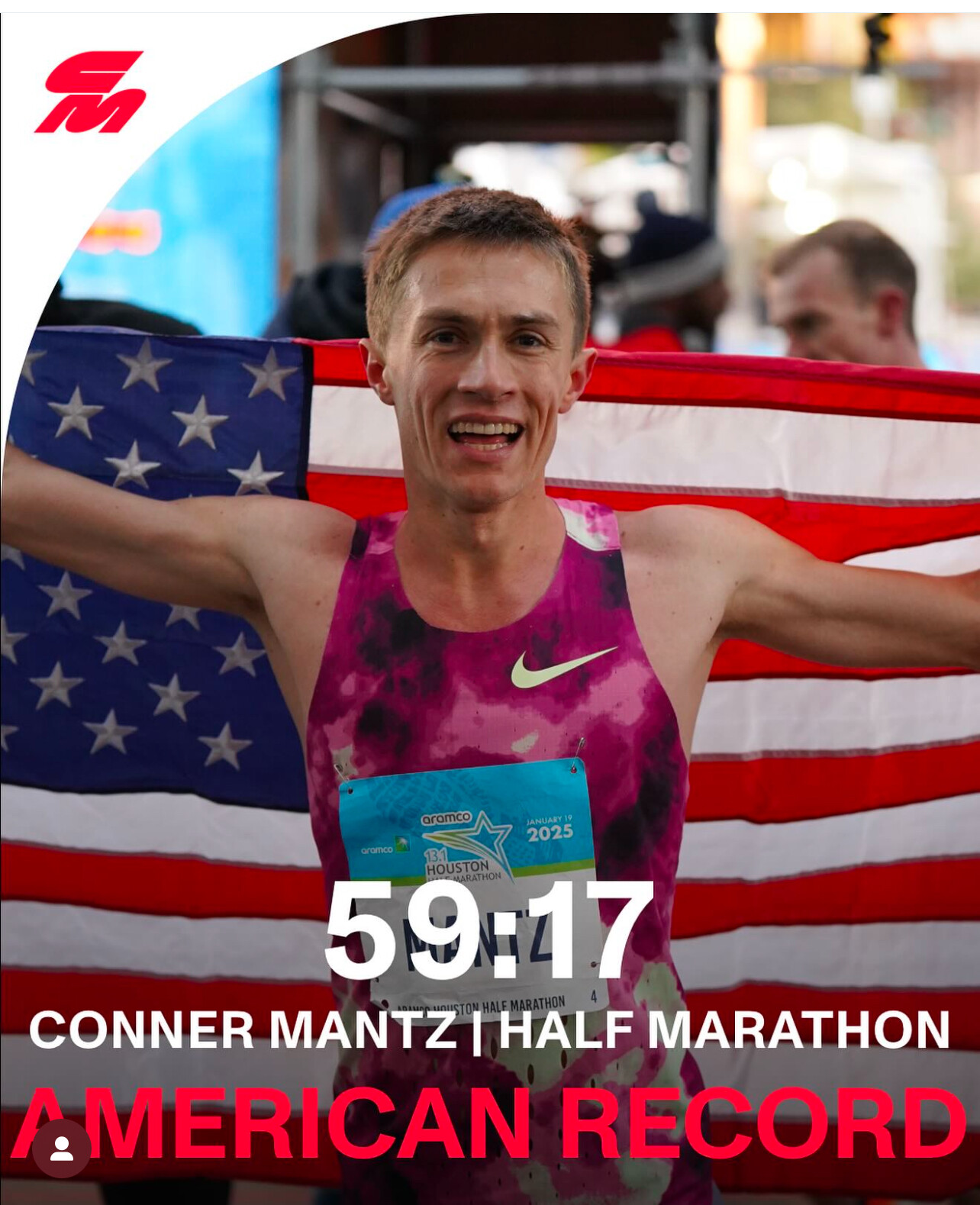
Choosing to further his running career and education, Mantz committed to Brigham Young University (BYU), turning down offers from institutions like Princeton and Furman. Before starting at BYU, he took a two-year hiatus to serve as a missionary for the Church of Jesus Christ of Latter-day Saints in Ghana. Upon his return in 2017, Mantz redshirted his first year, laying a solid foundation for his collegiate career. Under the guidance of coach Ed Eyestone, Mantz clinched back-to-back NCAA Division I Cross Country Championships titles in 2020 and 2021, solidifying his reputation as one of the nation's premier collegiate runners.
Transition to Professional Running
Turning professional in December 2021, Mantz signed with Nike and quickly made his mark. He won the USA Half Marathon Championships in Hardeeville, South Carolina, with a time of 1:00:55. The following year, he debuted in the marathon at the 2022 Chicago Marathon, finishing seventh with a time of 2:08:16. This performance was the second-fastest marathon debut by an American, just behind Leonard Korir's 2:07:56.
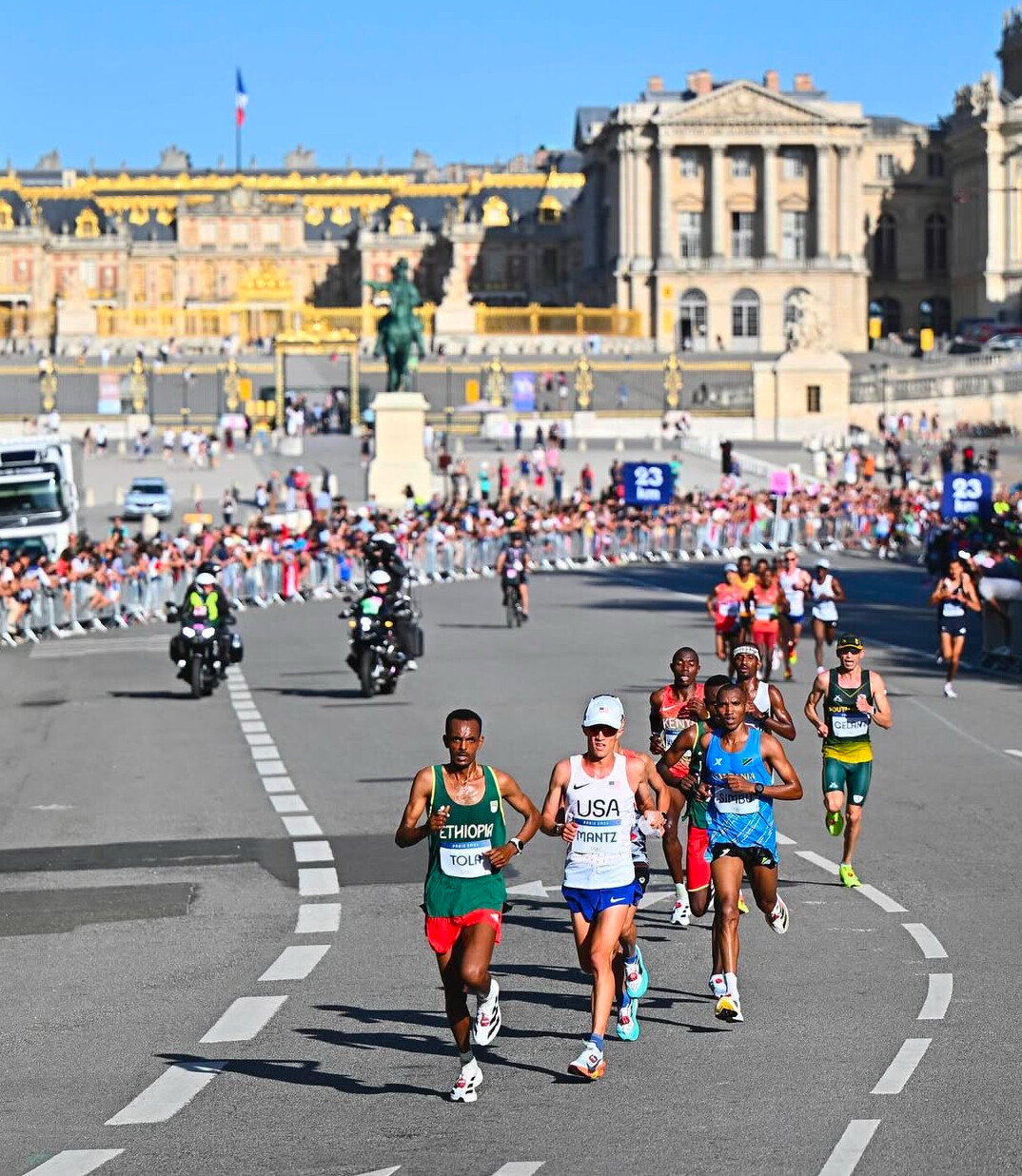
Olympic Pursuits and Notable Performances
In 2024, Mantz's career reached new heights. He won the U.S. Olympic Marathon Trials, securing his spot at the Paris 2024 Olympics. Despite facing a two-inch tear in his quad during preparations, Mantz showcased resilience, finishing eighth in the Olympic marathon. Post-Olympics, he continued to impress, placing sixth at the 2024 New York City Marathon.
Breaking the American Half Marathon Record
On January 19, 2025, at the Houston Half Marathon, Mantz etched his name into the record books. He completed the race in a staggering 59:17, breaking Ryan Hall's 18-year-old American record of 59:43 set in 2007. This achievement not only shattered the long-standing record but also made Mantz the first American in seven years to run a sub-60-minute half marathon.
Looking Ahead
Conner Mantz's trajectory in long-distance running is a blend of early passion, collegiate excellence, and professional triumphs. As he continues to push boundaries and set new standards, the running community eagerly anticipates his future endeavors, confident that Mantz will remain a formidable force on both national and international stages.
by Boris Baron
Login to leave a comment
Thrilling Finish at the 2025 Chevron Houston Half Marathon: Conner Mantz Ties Event Record, Sets New American Standard
The 2025 Chevron Houston Half Marathon delivered an unforgettable race, featuring one of the closest finishes in the event’s history. In a jaw-dropping sprint to the finish line, Addisu Gobena of Ethiopia and Conner Mantz of the United States both crossed the tape at 59:17, sharing the event record in an electric photo finish.
For Mantz, this historic performance was doubly significant. The Utah native not only tied the event record but also shattered Ryan Hall’s longstanding American record of 59:43, set in 2007. Mantz’s 59:17 establishes a new national standard, cementing his place as one of the greatest American half-marathoners.
The men’s field showcased extraordinary depth, with four runners breaking the elusive 1-hour mark and an additional eight runners finishing under 61 minutes. The sheer quality of performances underscores Houston’s reputation as one of the premier half-marathon events in the world.
Men’s Results Overview
1. Addisu Gobena (Ethiopia) – 59:17
2. Conner Mantz (USA) – 59:17 (New American Record)
3. Gabriel Geay (Tanzania) – 59:18
4. Jemal Yimer (Ethiopia) – 59:20
5. Patrick Dever (Great Britain) – 1:00:11
Mantz’s record-breaking run wasn’t the only highlight for American fans. Hillary Bor, Wesley Kiptoo, Andrew Colley, and Alex Maier all posted sub-61-minute finishes, demonstrating the growing strength of U.S. distance running.
A Photo Finish for the Ages
The showdown between Gobena and Mantz captivated spectators. Both runners surged in the final meters, with Gobena just barely edging ahead in the official results. While Gobena claimed the win, Mantz’s breakthrough made headlines, showing that American distance running continues to rise to global prominence.
Conner Mantz’s Perspective
“This was a dream race for me,” Mantz said after the event. “I’ve always admired Ryan Hall’s record, and to not only break it but to do so in such a competitive field is incredibly special. Sharing the event record with Addisu Gobena makes it even more memorable.”
A Record-Setting Day
The 2025 Chevron Houston Half Marathon proved to be one for the history books. With its flat, fast course and deep international field, the event continues to attract world-class talent. Gobena and Mantz’s shared record and Mantz’s new American milestone will stand as highlights of this year’s race, reminding fans why Houston is synonymous with excellence in distance running.
Women’s Half Marathon:
Weini Kelati lowered her own American women’s half marathon record by completing the race in 1:06:09, a 16-second improvement from her previous record of 1:06:25 set at the same event last year. Kelati secured second place in the women’s field, finishing just four seconds behind Ethiopia’s Senayet Getachew, who won with a time of 1:06:05.
The favorable weather conditions in Houston contributed to these record-breaking performances, making the 2025 Houston Half Marathon a memorable event for American distance running.
by Boris Baron
Login to leave a comment
Aramco Houston Half Marathon
The Chevron Houston Marathon provides runners with a one-of-a-kind experience in the vibrant and dynamic setting of America's fourth-largest city. Renowned for its fast, flat, and scenic single-loop course, the race has earned accolades as the "fastest winter marathon" and the "second fastest marathon overall," according to the Ultimate Guide to Marathons. It’s a perfect opportunity for both elite athletes...
more...Houston chases new American records elite fields include Yehaulaw and Kiptoo
The 2025 road racing year will open with an exciting chase for American records at the Aramco Houston Half Marathon and course records at the Chevron Houston Marathon on Sunday, January 19.
The Houston Marathon Committee announced the professional fields for both races today, featuring returning champions and all-time top performers.
The women’s half marathon field is led by the fifth fastest woman in history, Yalemzerf Yehaulaw of Ethiopia who will race in North America for the first time. Yehaulaw, 25, holds two of the top ten all-time half marathon performances including her personal best of 1:03:51 from Valencia in 2021. In 2024, Yehaulaw set a new personal best time in the marathon, winning the Amsterdam Marathon in 2:16:52, a course record.
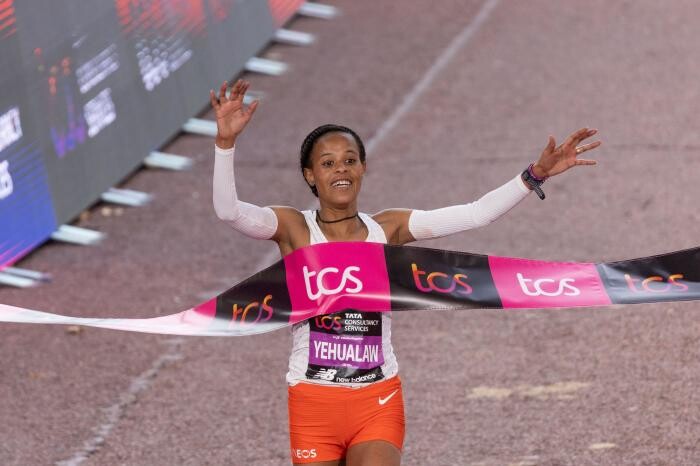
“It has always been my ambition to race in the United States and now the opportunity has finally come,” said Yehaulaw, the 2022 TCS London Marathon winner. “Running an early race means I get a chance to focus fully on the half marathon to go for a fast time. I am eager to win.”
The Aramco Houston Half Marathon women’s race also features the follow-up half marathon for the American record holder Weini Kelati. Kelati set the record of 1:06:25 in her debut half marathon here last year. She has not raced the distance since, instead focusing on the 10,000m in which she represented the United States at the 2024 Paris Games.
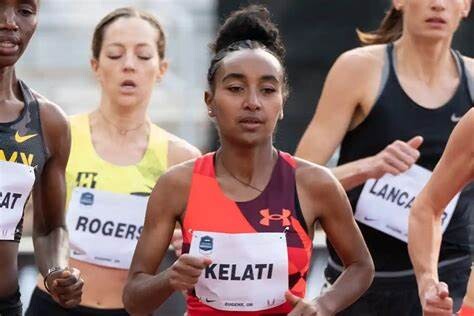
“I’m really excited to come back to Houston and run my second half marathon,” said Kelati, who finished fourth here in 2024. “Last year was great and I hope this year’s race will be even better. My training has been going well and I know the competition will be very good.”
The women’s professional field features 15 women who have run faster than 1:10 in the half marathon. Other top contenders include last year’s third place finisher Buze Diriba of Ethiopia; the third fastest British half marathoner in history, Jessica Warner-Judd, and fellow Brit and 2024 Olympic marathoner, Calli Hauger-Thackery. Hauger-Thackery won the California International Marathon last month.
The men’s competition will see a rematch of last year’s thrilling Aramco Houston Half Marathon. Wesley Kiptoo of Kenya who has been runner-up here for the past two years will again face off against Jemal Yimer of Ethiopia. Yimer outsprinted Kiptoo in 2024, beating him by just one second.
“I can’t wait to return to Houston to try to defend my 2024 title,” said Yimer, who also won here in 2020. “It’s a special place for me to kick off my 2025 road season.”
The pair will be joined by Tanzania Olympian and former Boston Marathon runner-up Gabriel Gaey who has a personal best of 59:42 from his seventh place finish here in 2020.
The men’s race will also see an attempt to finally topple the American half marathon record of 59:43 set here by Ryan Hall in 2007. Leading the chase on the 18-year-old record will be 2024 Olympic marathoners Conner Mantz and Clayton Young. Mantz and Young, who finished eighth and ninth in Paris, train together in Provo, Utah. In November, they were the top two American finishers in the TCS New York City Marathon with Mantz breaking the American course record. This will be Young’s Houston debut. Mantz last ran here in 2023, finishing in sixth place.
“I want to race the Aramco Houston Half Marathon because there are other fast Americans going for the American Record,” said Mantz, who also set the American record in the 10 mile last October. “The opportunities to race in a field like this, on a fast and record-eligible course are rare.”
Mantz and Young will face competition for a spot in the record books from Diego Estrada, the ninth fastest American in history and 2015 Houston champion who had a career-best performance here last year when he finished fifth in 1:00:49. Joe Klecker, an Olympian in the 10,000m, will look to play a factor in his half marathon debut along with his training partner Morgan Pearson, a two-time Olympic silver medalist in the triathlon with a personal best of 1:01:08. Klecker comes to Houston with family history. His mother Janis Klecker is the 1992 Houston Marathon champion.
The Chevron Houston Marathon features the return of two-time champion Dominic Ondoro of Kenya. Ondoro, who won here in 2017 and 2023, will be part of a field that includes two men who have run under Zouhair Talbi’s course record of 2:06:39 set in 2024: Haimro Alame (Israel, 2:06:04) and Ande Filmon (Eritrea, 2:06:38). The field also includes last year’s third place finisher, Hendrik Pfeiffer of Germany. Pfeiffer led nearly 22 miles of last year’s race and finished with a personal best of 2:07:14.
“Houston was the best marathon race in my career so far. I have great memories of the fast course and the impressive city,” said Pfeiffer, whose wife Esther is in the women’s half marathon elite field. “I have already experienced how it feels to lead the race for more than 35 kilometers and I‘m hungry for more. I will definitely try to chase a fast time again.“
A new winner will be crowned in the Chevron Houston Marathon women’s race. After making her half marathon debut here in 2023, Anna Dibaba will return to Houston to run just the second marathon of her career. The sister of Ethiopian legends Tirunesh, Ejegayehu and Genzebe, Dibaba ran 2:23:56 in her debut in Amsterdam last October.
“As I race in more marathons I am sure that I will understand better what I am capable of,” said Dibaba who placed fourth in the 2023 Aramco Houston Half Marathon. “You have to respect the distance of the marathon and it is not enough to be in shape. You must know how to interpret each race, the various courses and conditions. I am looking forward to seeing what I am now able to do in my next race in Houston."
There are two Ethiopian women who have run faster than Dibaba entered in the race. Tsigie Hailesale who has run 2:22:10 and has marathon victories in Stockholm and Cape Town is the fastest and Sifan Melaku, also a past winner in Stockholm with a 2:23:49 personal best.
American Erika Kemp will line up for only her second career marathon in Houston. Kemp, a two-time U.S. champion will look to build on her experience from the Boston Marathon last spring.
“In 2023 I learned what it was like to be out there competing for over two hours,” said Kemp, who runs for Brooks, the footwear and apparel sponsor of the Houston Marathon Weekend of Events. “I’m hoping to utilize the course karma I’ve built up in Houston to have a great marathon.”
“We are excited to see so many top runners kick off their 2025 racing season with us in Houston,” said Wade Morehead, Executive Director of the Houston Marathon Committee. “We are expecting a historic day that will add to this event’s reputation as one of the best races in the world.”
More than USD 190,000 in prize money and bonuses will be awarded to the top finishers of the Chevron Houston Marathon and USD 70,000 plus time bonuses for the top finishers in the Aramco Houston Half Marathon. The races will be broadcast live on ABC13 and feature commentary from Olympic Marathoner and Boston Marathon champion Des Linden.
by AIMS
Login to leave a comment
Chevron Houston Marathon
The Chevron Houston Marathon offers participants a unique running experience in America's fourth largest city. The fast, flat, scenic single-loop course has been ranked as the "fastest winter marathon" and "second fastest marathon overall" by Ultimate Guide To Marathons. Additionally, with more than 200,000 spectators annually, the Chevron Houston Marathon enjoys tremendous crowd support. Established in 1972, the Houston Marathon...
more...Sara Hall Smashes Her Own American Masters Record
In her fourth marathon of 2024, Sara Hall finished 10th at the Valencia Marathon in Spain in 2:23:45. Hall, 41, shattered her own U.S. masters record, 2:26:06, which she set at the Olympic Marathon Trials in February.
The race was won by Megertu Alemu of Ethiopia in 2:16:49.
Hall averaged 5:29 per mile pace in Valencia. It was her best marathon since 2022, when she ran 2:22:10 at the World Championships in Eugene, Oregon, and placed fifth.
Hall has been frequent racer throughout her career, not needing much time to recover between races. Her entry into Valencia was a last-minute addition, after she raced in Chicago eight weeks earlier, and the race did not go according to plan. (Hall was 18th in 2:30:12.) She also ran Boston this year, finishing 15th in 2:27:58.
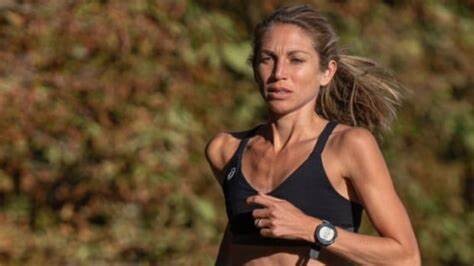
She posted to her Instagram account after the race.
“After a long stretch of not feeling like myself since Boston, it felt so good to have my normal fight out there,” Hall wrote, in part. “Applied the lessons I learned from Chicago, handled the very similar conditions much better. Chose to believe in myself even when my confidence had been rattled over and over. What a dream to do this four times this year.”
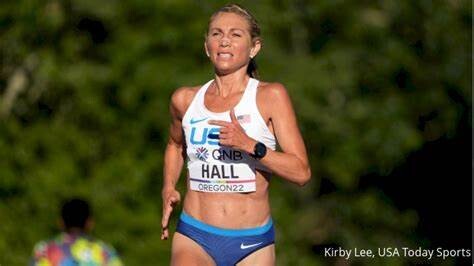
Hall elaborated in a text message to Runner’s World that she missed several bottles in Chicago—she fumbled a couple, and others she didn’t drink much out of—and became dehydrated in the humid conditions. “This time just was much more intentional to consume fluids even if I didn’t feel like I needed it,” she said.
She also increased her electrolytes and said she went out more conservatively than she would normally run and did at Chicago. Hall ran half spits that were almost even—1:11:40 and 1:12:05.
Hall’s PR is 2:20:32 from the Marathon Project in Chandler, Arizona, a one-time event set up for elite runners during the pandemic. That PR puts her fifth on the U.S. all-time list, behind Emily Sisson, Keira D’Amato, Betsy Saina, and Deena Kastor.
Her career is notable for its duration. Hall has appeared in every Olympic Trials since 2004, either on the track or in the marathon, or both. She is coached by her husband, Ryan Hall, who is third on the U.S. all-time list for men’s marathoners.
Hall was not the only record setter in Valencia. Roberta Groner, 46, who represented the U.S. at the 2019 world championships in Doha, Qatar, where she finished sixth, ran 2:29:32, setting an American record for the 45–49 age group.
Groner’s record should be safe for at least the next three years—or until Hall turns 45 in April 2028.
by Sarah Lorge Butler
Login to leave a comment
VALENCIA TRINIDAD ALFONSO
The Trinidad Alfonso EDP Valencia Marathon is held annually in the historic city of Valencia which, with its entirely flat circuit and perfect November temperature, averaging between 12-17 degrees, represents the ideal setting for hosting such a long-distance sporting challenge. This, coupled with the most incomparable of settings, makes the Valencia Marathon, Valencia, one of the most important events in...
more...The Evolution of Marathon Running: A Kenyan Perspective
I can still vividly remember when 2:08:32 in the marathon seemed like an unbreakable barrier. Derek Clayton of Australia set this world record back in 1969 at the Antwerp Marathon—a time so remarkable that it stood for nearly 12 years. Now, hundreds of runners have far surpassed that mark. Today, running a sub-2:05 marathon has become almost routine, particularly for athletes from Africa.
On the women’s side, the achievements are just as groundbreaking. Ruth Chepngetich of Kenya recently made history at the 2024 Chicago Marathon by breaking the 2:10 barrier, finishing in a stunning 2:09:56. While this remarkable time is still awaiting ratification, it is set to redefine the boundaries of women’s marathon running. This performance follows the previous world record of 2:11:53, set by Tigst Assefa of Ethiopia at the 2023 Berlin Marathon. These times show just how far women’s marathon performances have progressed in recent years.
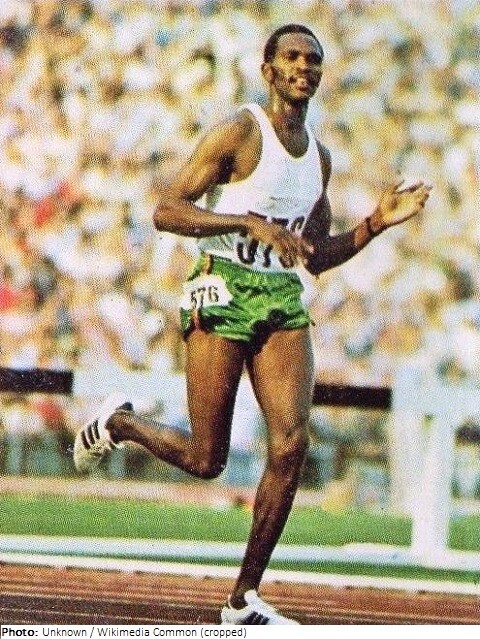
While advancements like “magic” shoes have undoubtedly played a role in these extraordinary performances, it’s important to note that better pacing by other professional runners, now a standard practice, has also made a significant difference. These pacesetters help keep athletes on target through much of the race, ensuring consistency and reducing mental strain. However, the story of record-breaking runs runs much deeper than technology and pacing strategies.
In Kenya alone, there are at least 80,000 distance runners who dream of nothing else but becoming professional athletes. For them, running isn’t just a passion—it’s a path to success and stability.
At the Kenyan Athletics Training Academy (KATA), the training camp I established in Thika, Kenya, we house, feed, and train aspiring athletes. I Each week, I receive messages from 10 or more runners hoping to join our program. For these athletes, running is not a hobby or a pastime. It’s a career aspiration, with the ultimate goal of winning races and securing prize money. They love running, but make no mistake—their drive is fueled by the potential to achieve financial security and support their families.

Contrast this with the United States, where very few runners train with the sole focus of becoming professional athletes. Instead, many children grow up dreaming of careers in sports like baseball, basketball, football, or, more recently, soccer. The talent pool for these sports is massive, and from this base, the superstars emerge.
That said, American marathoners have delivered incredible performances. Ryan Hall’s 2:04:58 at the 2011 Boston Marathon remains a monumental achievement, showcasing what U.S. athletes are capable of on a favorable course. On the women’s side, runners like Keira D’Amato (2:19:12) and Emily Sisson (2:18:29, an American record) are setting new benchmarks, proving that the U.S. can compete at the highest levels.
In the U.S., running is often a lifestyle choice rather than a career ambition. Recreational and “fun” runners dominate the scene, which has its benefits—contributing to a higher average life expectancy (76 years in the U.S. compared to 63 in Kenya). In Kenya, it’s rare to see runners over 40 years old out training. The focus there is on younger athletes whose primary goal is to make a living through running.
For many in Kenya, running is the equivalent of pursuing a high-paying job in other fields. This mentality dates back to pioneers like Kip Keino, who opened the door for countless Kenyan athletes to achieve global success. His legacy inspired generations, and today, Kenyan runners—both men and women—continue to push the limits of human potential.
As marathon times keep dropping and prize money continues to grow, I believe we’ll see even faster performances from both men and women—especially in Africa, where running is deeply ingrained as a pathway to opportunity.
by Bob Anderson
Login to leave a comment
Joe Klecker Plans His Half Marathon Debut
In a live recording of The CITIUS MAG Podcast in New York City, U.S. Olympian Joe Klecker confirmed that he is training for his half marathon debut in early 2025. He did not specify which race but signs point toward the Houston Half Marathon on Jan. 19th.
“We’re kind of on this journey to the marathon,” Klecker said on the Citizens Bank Stage at the 2024 TCS New York City Marathon Expo. “The next logical step is a half marathon. That will be in the new year. We don’t know exactly where yet but we want to go attack a half marathon. That’s what all the training is focused on and that’s why it’s been so fun. Not that the training is easy but it’s the training that comes the most naturally to me.”

Klecker owns personal bests of 12:54.99 for 5000m and 27:07.57 for 10,000m. In his lone outdoor track race of 2024, he ran 27:09.29 at Sound Running’s The Ten in March and missed the Olympic qualifying standard of 27:00.00.
His training style and genes (his mother Janis competed at the 1992 Summer Olympics in the marathon and won two U.S. marathon national championships in her career; and his father Barney previously held the U.S. 50-mile ultramarathon record) have always linked Klecker to great marathoning potential. For this year’s TCS New York City Marathon, the New York Road Runners had Klecker riding in the men’s lead truck so he could get a front-row glimpse at the race and the course, if he chooses to make his debut there or race in the near future.
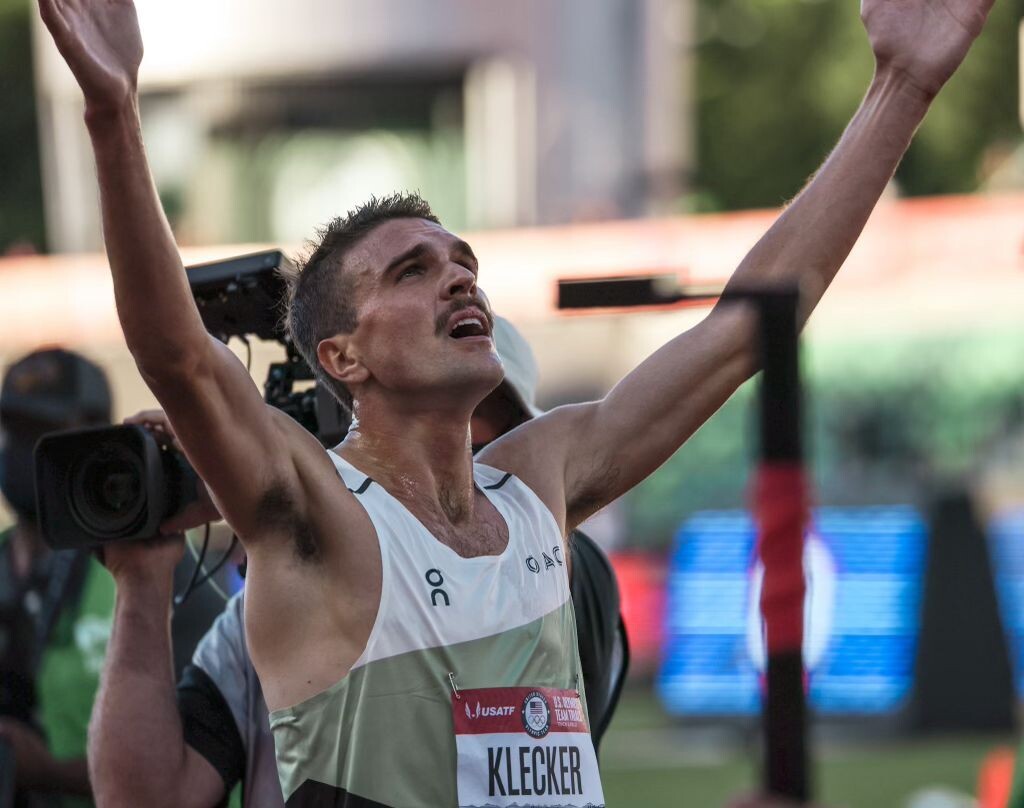
The Comeback From Injury
In late May, Klecker announced he would not be able to run at the U.S. Olympic Track and Field Trials in June due to his recovery from a torn adductor earlier in the season, which ended his hopes of qualifying for a second U.S. Olympic team. He spent much of April cross training and running on the Boost microgravity treadmill at a lower percentage of his body weight.
“The process of coming back has been so smooth,” Klecker says. “A lot of that is just because it’s been all at the pace of my health. I haven’t been thinking like, ‘Oh I need to be at this level of fitness in two weeks to be on track for my goals.’ If my body is ready to go, we’re going to keep progressing. If it’s not ready to go, we’re going to pull back a little bit. That approach is what helped me get through this injury.”
One More Track Season
Klecker is not fully prepared to bid adieu to the track. He plans to chase the qualifying standard for the 10,000 meters and attempt to qualify for the 2025 World Championships in Tokyo. In 2022, after World Athletics announced Tokyo as the 2025 host city, he told coach Dathan Ritzenhein that he wanted the opportunity to race at Japan National Stadium with full crowds.
“I’m so happy with what I’ve done on the track that if I can make one more team, I’ll be so happy,” Klecker says. “Doing four more years of this training, I don’t know if I can stay healthy to be at the level I want to be. One more team on the track would just be like a dream.”
Klecker is also considering doubling up with global championships and could look to qualify for the 2025 World Road Running Championships, which will be held Sept. 26th to 28th in San Diego. To make the team, Klecker would have to race at the Atlanta Half Marathon on Sunday, March 2nd, which also serves as the U.S. Half Marathon Championships. The top three men and women will qualify for Worlds. One spot on Team USA will be offered via World Ranking.
Sound Running’s The Ten, one of the few fast opportunities to chase the 10,000m qualifying standard on the track, will be held on March 29th in San Juan Capistrano.
Thoughts on Ryan Hall’s American Record
The American record in the half marathon remains Ryan Hall’s 59:43 set in Houston on Jan. 14th, 2007. Two-time Olympic medalist Galen Rupp (59:47 at the 2018 Prague Half) and two-time U.S. Olympian Leonard Korir (59:52 at the 2017 New Dehli Half) are the only other Americans to break 60 minutes.
In the last three years, only Biya Simbassa (60:37 at the 2022 Valencia Half), Kirubel Erassa (60:44 at the 2022 Houston Half), Diego Estrada (60:49 at the 2024 Houston Half) and Conner Mantz (60:55 at the 2021 USATF Half Marathon Championships) have even dipped under 61 minutes.
On a global scale, Nineteen of the top 20 times half marathon performances in history have come since the pandemic. They have all been run by athletes from Kenyan, Uganda, and Ethiopia, who have gone to races in Valencia (Spain), Lisbon (Portugal), Ras Al Khaimah (UAE), or Copenhagen (Denmark), and the top Americans tend to pass on those races due to a lack of appearance fees or a stronger focus on domestic fall marathons.
Houston in January may be the fastest opportunity for a half marathon outside of the track season, which can run from March to September for 10,000m specialists.
“I think the record has stood for so long because it is such a fast record but we’re seeing these times drop like crazy,” Klecker says. “I think it’s a matter of time before it goes. Dathan (Ritzenhein) has run 60:00 so he has a pretty good barometer of what it takes to be in that fitness. Listening to him has been really good to let me know if that’s a realistic possibility and I think it is. That’s a goal of mine. I’m not there right now but I’m not racing a half marathon until the new year. I think we can get there to attempt it. A lot has to go right to get a record like that but just the idea of going for it is so motivating in training.”
His teammate, training partner, and Olympic marathon bronze medalist Hellen Obiri has full confidence in Klecker’s potential.
“He has been so amazing for training,” Obiri said in the days leading up to her runner-up finish at the New York City Marathon. “I think he can do the American record.”
by Chris Chavez
Login to leave a comment
Aramco Houston Half Marathon
The Chevron Houston Marathon provides runners with a one-of-a-kind experience in the vibrant and dynamic setting of America's fourth-largest city. Renowned for its fast, flat, and scenic single-loop course, the race has earned accolades as the "fastest winter marathon" and the "second fastest marathon overall," according to the Ultimate Guide to Marathons. It’s a perfect opportunity for both elite athletes...
more...Rory Linkletter adjusts to new coach ahead of TCS New York City Marathon
Canadian marathoner Rory Linkletter is preparing for the 2024 TCS New York City Marathon on Nov. 3 with a new coach and a renewed focus. After his previous coach, Ryan Hall, decided to step away from coaching following the Paris 2024 Olympics, Linkletter was forced to seek new guidance with less than 10 weeks to go until the race.
For Linkletter, his Paris Olympic marathon was a mix of pride and disappointment. He was proud to represent the red and white at an event he had always dreamed about competing at, but he felt his race was underwhelming. “I feel like I didn’t show my best,” Linkletter said on his 47th-place finish (2:13:09).
Linkletter told Canadian Running his preparation for Paris centred heavily on mastering the challenging course and hills: “I felt like I needed to get strong and run hills, but at the end of the day, it’s always the fittest man who wins,” he says. “I got too far away from speed and power.”
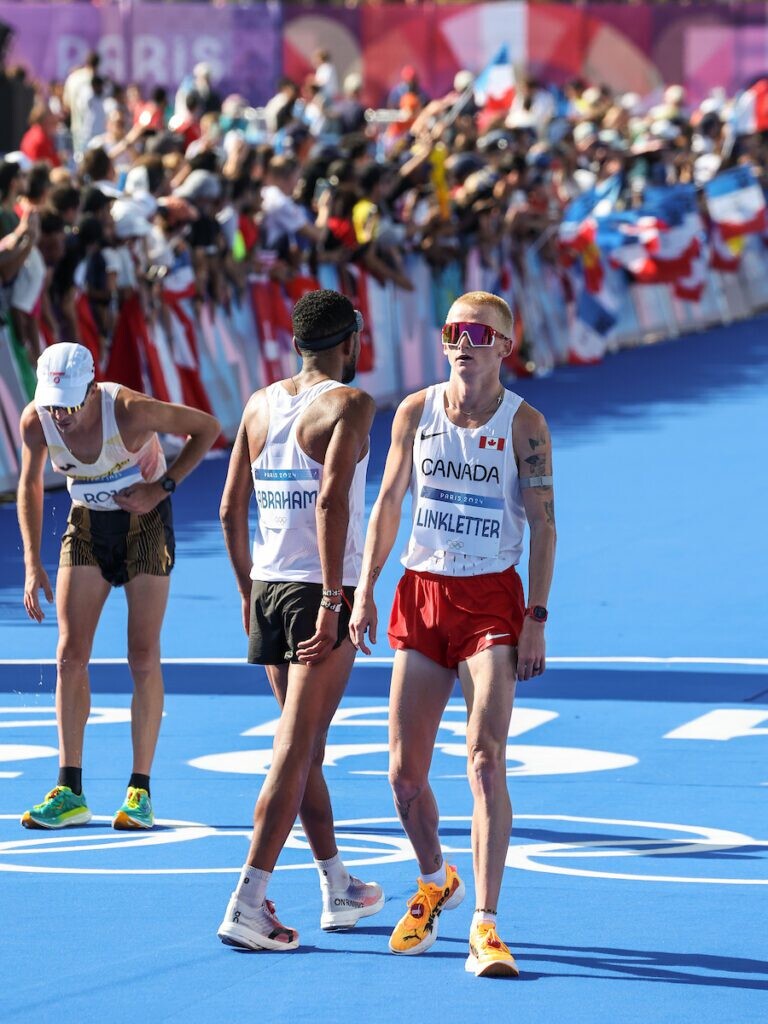
He took a week off after Paris and then dove back into training, focusing on his next challenge–the 2024 New York City Marathon. During his time off, Linkletter was taken by surprise when Hall announced he would be stepping back from coaching. “I was shocked. It was all so sudden,” Linkletter admits. “If you knew Ryan, you wouldn’t be surprised, but I didn’t expect it to happen so soon.”
New beginnings
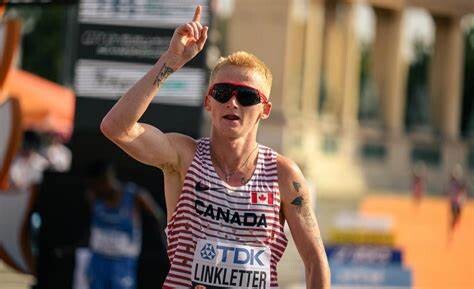
Balancing the post-Olympic blues with the sudden coaching transition wasn’t easy, but Linkletter says he’s the most motivated to train when he’s disappointed.
The 2:08:01 marathoner initially created his own training plan for NYC, and reached out to a few people he trusted for feedback. One of those was Jon Green, coach of U.S. Olympic marathon bronze medallist Molly Seidel. “We met up, had a conversation, and he said he’d be happy to help me get to NYC,” Linkletter says. “By the time we met again, he had mapped out a plan for me. I liked what he had.”
Green is someone Canada’s second fastest marathoner has long respected, going back to their days racing against each other in the NCAA—Linkletter competing for Brigham Young University (BYU) and Green for Georgetown. Now, as a coach-athlete duo, they’re working to fine-tune Linkletter’s strengths for the NYC Marathon in his home of Flagstaff, Ariz.
Moving forward
Training in Flagstaff has become a constant for Linkletter. He’s found a home in the high-altitude environment, which is known for its ideal training conditions. “I love it here,” he says. “It’s one of the best, if not the best, places to train.” With the NYC Marathon on the horizon, Linkletter is content in Flagstaff, but remains open to exploring options that will best prepare him for the future. “Paris was awesome, but I want to be there again in L.A. 2028 and be the best version of myself,” he says.
By then, Linkletter will be 31 years old—what he believes will be his prime—and he’s determined to make every year count as he builds toward the goal.
by Marley Dickinson
Login to leave a comment
TCS New York City Marathon
The first New York City Marathon, organized in 1970 by Fred Lebow and Vince Chiappetta, was held entirely in Central Park. Of 127 entrants, only 55 men finished; the sole female entrant dropped out due to illness. Winners were given inexpensive wristwatches and recycled baseball and bowling trophies. The entry fee was $1 and the total event budget...
more...What the elites eat: Marathon Edition
Curious about what elite marathoners eat to fuel their peak performance? From carb-loaded pre-race meals to post-race burger feasts, here’s an inside look at what the elites eat before, during, and after a marathon.
As runners and human beings, we’re naturally curious, slightly nosy people. With information instantly available with the twitch of a finger across our iPhone screens, this curiosity has never been easier to satisfy. Plus, many of our favorite runners are more transparent than ever about their training blocks, pulling back the blinds through social media to show what it takes to be the best. Which is why we’re ever-fascinated by the race-related nutrition strategy of elite runners, who often perform at superhero-like levels.
We asked a few elite marathoners what they eat surrounding race day—pre-race dinner, pre-race breakfast, and post-race celebration—so you don’t have to.
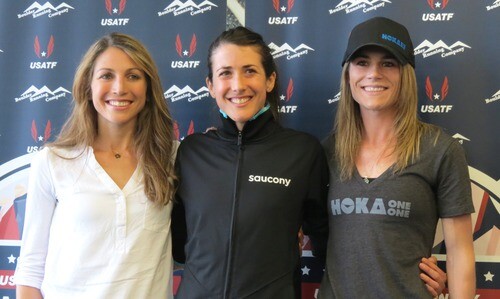
Note: One sentiment echoed among all of the athletes interviewed was that their diets are personal and have gone through lots of trial-and-error to be finessed to their specifications. No lifestyle should be replicated exactly.
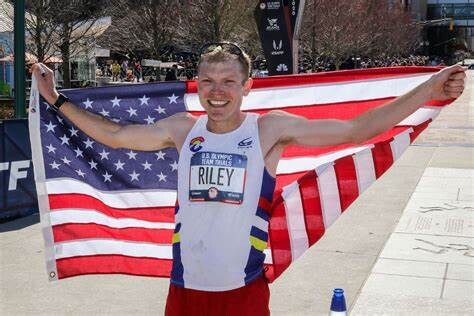
35, Boulder, Colorado
About him: First American and ninth overall finisher in the 2019 Chicago Marathon (2:10:36). Placed second at the 2020 U.S. Olympic Trials Marathon (2:10:02); Finished 28th in Tokyo Olympics marathon (2:16:26). After a second round of double Haglund’s surgery in 2022, he’s back in top form and running the 2024 New York City Marathon on November 3.
The night(s) before a race:
“I start thinking about meals two nights out, and I go carb-heavy on both. For the first night, I like to have Thai food, usually a noodle dish, and a side of rice. The only thing I’ll really avoid is spice since I’ve had issues from it a couple times. The night before, I do pasta, usually a marinara (that’s what a lot of races provide for the elite athletes), but a good pesto sauce works well, too. I mostly stay away from the creamy sauces. I don’t like to get too much more specific—you never know exactly what’s going to be available, so I try not to make particular foods part of my routine.”
Race morning:
“Race mornings I’ll get up at least three hours before (I prefer four, but with 7 to 8 A.M. starts, that becomes a little counter-productive), I’ll go for a short walk with some skipping or something, just to get the body moving. My first choice for breakfast is oatmeal with peanut butter, honey, and a little fruit mixed in. And at least one, usually two cups of coffee. It’s not something to avoid, but I recommend making sure that you have more than just simple carbs (cereal, muffin, etc), I find that if there isn’t at least some protein, I start getting that ‘empty’ feeling during my warmup, and if that mixes with the adrenaline, I feel real queasy. If I’m taking gels, I take one on the start line, maybe five minutes before. I also like Generation UCAN, which I’ll sip as I’m going through my drills, maybe half an hour out.”
During the race:
“I like to get my calories from gels and have just electrolytes in my bottles. Most major marathons provide drink stations every 5K, and I’ll drink about 8-10 oz of SOS per bottle (there can be splashing, and you never get it all out). I’ll take Roctane gels before every other drink station (every 30 minutes or so).”
Post-race meal:
“Most races I want a hash—lots of potatoes with some eggs, bacon, cheese, and veggies all mixed up, but after marathons my stomach takes a while to settle down, so I’m more in a lunch mood. So my go-to post-race meal is a big bistro bacon cheeseburger, ideally with an onion ring and barbecue sauce, side of fries, and a beer. I mostly stay away from fried foods during a build up, but I always take at least a week off after a marathon and at this point, that beer and burger is almost a Pavlovian ‘vacation time’ signal for my whole body.”
41, Flagstaff, Arizona
About her: She’s the fourth-fastest American woman in history based on her personal best (2:20:2) at the 2020 Marathon Project; Second-fastest American female half-marathon runner and former American record-holder (1:07:15). Most recently, she was 18th overall and the women’s master champion in the 2024 Chicago Marathon (2:30:12).
The night(s) before a race:
“Rice with chicken. I skip the veggies to not risk having to make a bathroom stop in the race.”
Pre-race breakfast:
“Two scoops of UCAN energy powder with whey protein, and a little bit of almond butter.” Bonus, Hall credits her husband, Ryan Hall, as being the best coffee maker, brewing pour-over, medium roast coffee blended with butter.
During the race:
Ketone-IQ—peach flavored.
Post-race meal:
“My favorite post-meal race is Thai food. I’m usually eating a lot of boring food before the race, so I want something spicy and more flavorful after.”
Bonus—Lunch during training blocks:
“Two scoops of UCAN powder, two pieces of gluten-free bread with Kerrygold Butter.”
36, Boulder, Colorado
About her: Won the 2019 Grandma’s Marathon and finished ninth in the 2020 U.S. Women’s Olympic Trials Marathon in 2:30:39. She was the top American finisher in the Boston Marathon in 2021 (fifth, 2:27:12, ) and 2022 (10th, 2:25:57). In January, she placed ninth in the Houston Half Marathon in a new personal best of 1:08:52.
The night(s) before a race:
“I always have the same thing. Basically, a couple cups of white rice and a chicken breast is where I tend to fall. White rice is going to fuel the most carbs per serving. I used to mix up potatoes and white rice, but for me, I digest white rice well, I feel better, it’s easy to find, simple, and works well.
I don’t care about spices—and I’m usually not making it myself if I’m not at home. Typically, before races, there’s a pre-race dinner, and chicken is an option. I wouldn’t do any cream-based sauces. If it tastes good, great. If it doesn’t, great. I don’t care.”
Pre-race breakfast:
“Typically it’s oatmeal with a tablespoon of peanut butter, a banana, and maybe honey. I’m not 100 percent satisfied with my pre-race meal, because sometimes it can feel a bit heavy in my stomach, because oatmeal does have some fiber. So I try to play around with things. Sometimes I’ll do a couple pieces of toast with a banana and peanut butter. I can switch between those two. Try to get 500-600 calories in, mostly from carbs, two-three hours before the race. Plus, I drink coffee with half-and-half.
Post-race meal:
“Immediately after the race, I honestly will grab whatever is available. Typically, after a race, we’ll be shuttled to a post-race holding area where you’re waiting, so there are usually refreshments there. I’ll slam Gatorade—anything with sugar and electrolytes. Maybe there’s my own bottle with Skratch in it. Banana, a protein shake. I’m pretty open, as long as it’s immediate.
And as far as later, it completely depends. I’m trying to do a better job at this—especially after a major marathon—but it kind of takes a while. You might get drug-tested, then shuttled back to your hotel, shower, then six hours later you’re like, ‘I need to eat.’ If it’s a marathon, I love a big burger with fries—the classic stuff, lettuce, tomato, onion, and tons of ketchup and mayo. That’s something my body would crave. Fries are my favorite food ever that I don’t typically eat during a marathon cycle.”
35, Louisville, Colorado
About her: Finished sixth in the 2017 London Marathon (2:25:38), seventh in the 2019 New York City Marathon (2:28:23), eighth in the 2019 Chicago Marathon (2:29:06), eighth in the 2021 New York City Marathon (2:27:00). Most recently, an Achilles injury forced her to pull out of the 2024 Chicago Marathon days before the race.
The night(s) before a race:
“I do 72-hours of carb-loading. So, obviously, in the build to that, carbs are key. Three days out from the race is when I start it. It is always the same. The night before, I have pasta with marinara sauce, and I don’t do a lot of protein with that. I do love angel hair, that’s my go-to. I also like rigatoni. Plus, I’ll have some type of bread and salad.”
Pre-race breakfast:
“The morning of, I always do a plain bagel and peanut butter with a banana. I’ve done that since high school. And I do an Americano with two shots. I eat that threeish hours out from the race.
During the race:
“I’ll take my first gel 15 minutes before the start of the race. I’ve been all over the place with what I take, but right now, Neversecond. Big fan of their Cola C30 gels. They worked wonders for me during this build. I had some stomach issues earlier in the build with long runs and couldn’t quite figure out what was going on, so I switched up my nutrition during, so never second has been a godsend.”
Post-race meal:
“After the race, it’s hard because usually my stomach is a mess. Not only did you just run really hard for two and a half hours, but you’re taking all this fuel during, so I have a really hard time eating solids immediately after the race. My choice if I can get it is soda. I’m not a big soda drinker, but after a marathon, all I want is a Coke, Sprite, or Ginger Ale. I’m always really thirsty when I finish.
Then later when I feel like eating, I always do a burger (stacked with all the fixings—sometimes adding bacon) and sweet potato fries with ranch. I never opt out of Ranch. Anything I can dip ranch in is a plus for me. And I order a Blue Moon. I’m not a beer drinker, but that’s what I want after a marathon.”
by Mallory Arnold
Login to leave a comment
NCAA school faces backlash over 28-year-old Kenyan freshman
This time of year, many 18 and 19-year-olds are preparing for their first year of college or university. Kenyan runner Solomon Kipchoge will be experiencing the same firsts as a 28-year-old freshman at Texas Tech University in Lubbock, Texas. Kipchoge has a half marathon best faster than the American record and will be 10 years older than the majority of the incoming NCAA recruiting class for the 2024/2025 season, which has caused a stir among athletes.
The 28-year-old holds a half-marathon personal best of 59:37, which was set at the Semi-Marathon de Lille 2023 in France (a World Athletics Elite Label road race). His personal best is faster than any time ever run by an American over the half-marathon distance. (The American record of 59:43 is held by Ryan Hall.)
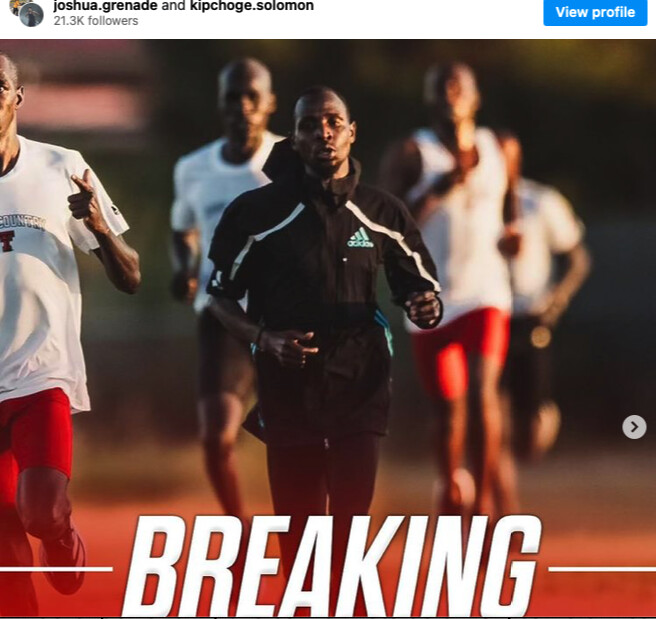
The 28-year-old holds a half-marathon personal best of 59:37, which was set at the Semi-Marathon de Lille 2023 in France (a World Athletics Elite Label road race). His personal best is faster than any time ever run by an American over the half-marathon distance. (The American record of 59:43 is held by Ryan Hall.)
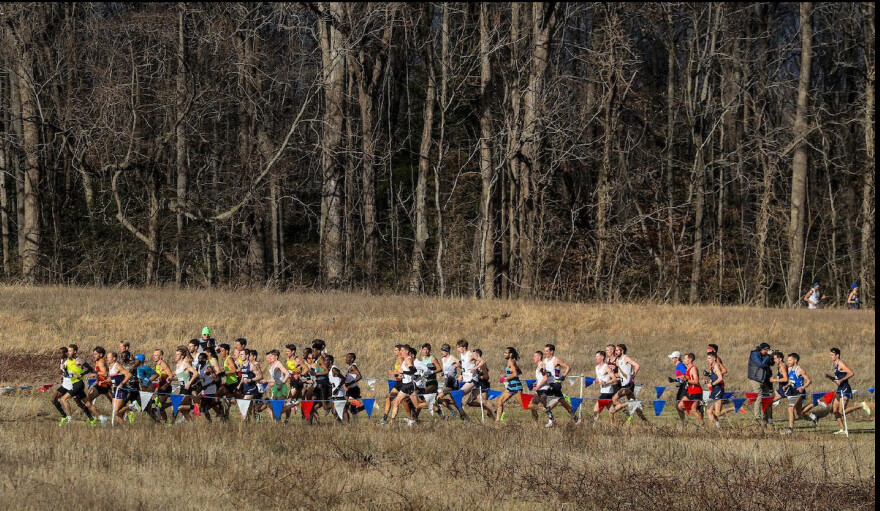
Although the NCAA has no restrictions on age, eligibility rules grant athletes a period of five years to complete four seasons of their sport. This means that athletes entering university at age 18 (the standard age for graduating high school) will be finished competing at age 23. Athletes who postpone the start of their post-secondary education will still be eligible at an older age–but beginning at age 28 seems like quite a stretch; the Kenyan will be competing against a field with athletes 10 years younger than himself.
Many users on Instagram are unsupportive of Kipchoge’s (very) late start to his degree in agricultural education. “It’s awesome that these guys are getting this opportunity and they should take advantage of it…With that being said, the NCAA regulations are objectively extremely flawed, and there is no reason nearly pro-caliber runners should be competing against teenagers 10+ years younger than them who are straight out of high school,” one comment reads.
Some international athletes still choose to compete in the NCAA (despite financial barriers) to take advantage of opportunities for development–but the Kenyan is already one of the fastest half-marathon runners in the world. In May, Kipchoge took fourth in an elite field at the Rimi Riga Half-Marathon, clocking 1:02:15. Already a world-class athlete, Kipchoge is unlikely to find development opportunities within NCAA-level competition.
by Running Magazine
Login to leave a comment
Defending champions return to Bix
Kellyn Taylor and Biya Simbassa each ran the Quad-City Times Bix 7 for the first time last year.
They clearly loved the course, the atmosphere and just about everything about the annual race through the streets of Davenport.
Both Taylor and Simbassa held off late challenges from other runners, both ran the sixth best Bix 7 times ever by a U.S. athlete of their gender and both plan to return to defend their championships when the race is held for the 50th time on July 27.
It marks the first time in 12 years that both the men’s and women’s champions are returning to defend their Bix titles.
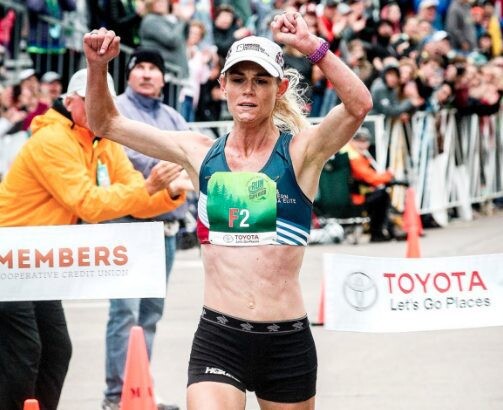
Simbassa admitted he wasn’t really sure how he felt about the Bix 7 course last year when he first saw the endless array of ups and downs in the course. But after holding off Olympian Clayton Young to win, he liked it.
“I mean, now I do,’’ he said after his victory. “It’s a course that’s all about strength and I train for this."
Taylor went through a similar transformation.
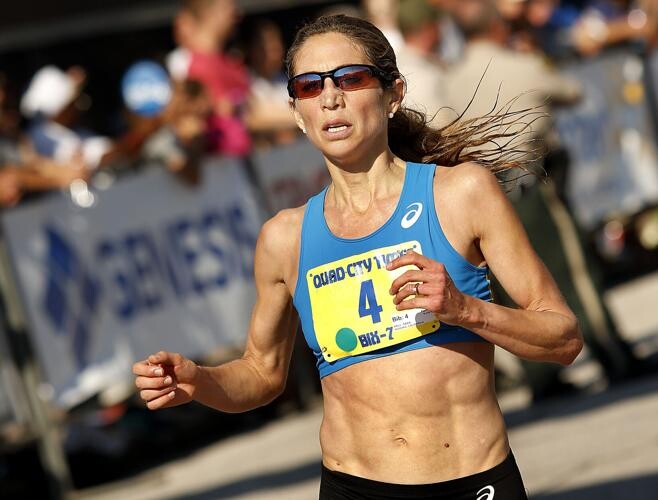
“When I saw the course, I was like, ‘Oh, no. What did I get myself into?’ ” she said. “That’s a super substantial hill right at the beginning and then it rolls all the way through. It’s certainly not easy by any means. I think that works to my favor since I’m more of a strength runner.”
Taylor appreciated more than just the hills.
“The crowds were amazing,” she said. “It’s not what I expected at all — the streets were completely lined, and a race that isn’t a huge marathon, I don’t feel like you see that that often. The crowds were incredible.”
Taylor and Simbassa will be bidding to repeat as Bix 7 champions, something that has been done only seven times in the race’s history, four times by men, three times by women.
Both runners failed to land berths on the U.S. Olympic team, which would have precluded a return to Bix, but they’ve still used their 2023 victories as a springboard to additional success.
Taylor briefly led the New York City Marathon last November before placing eighth, making her the top American finisher in the race. It was the third time she has been in the top eight at New York.
The Wisconsin native, who will turn 38 a few days before the Bix 7, then focused her attention on making the U.S. Olympic team and made a respectable showing in the trials in the marathon, finishing 15th, and the 10,000 meters, placing sixth.
Simbassa, a 31-year-old native of Ethiopia who now lives in Flagstaff, Arizona, attempted to earn an Olympic spot in the marathon but placed 11th in the trials.
However, he has followed that with an ambitious schedule on the U.S. road racing circuit, recording top-five finishes in the Bolder Boulder 10k (5th), Cherry Blossom 10-miler (5th), Gate River 15k (4th), Amway River Bank 25k (3rd) and Houston Half-marathon (4th).
Also included in the field are four former Olympians and nine other runners who have placed in the top 10 at the Bix 7 in the past. Elite athlete coordinator John Tope said even more top runners could be added between now and race day.
Among the top men’s entries are two former Iowa State University standouts.
Wesley Kiptoo of Kenya was the 2021 NCAA indoor 5,000-meter champion and a seven-time All-American for the Cyclones. He was seventh in the Bix 7 two years ago and won the Cherry Blossom 10-miler earlier this year.
Hillary Bor, a Kenya native who is now an American citizen, also attended Iowa State before representing the U.S. in the 3,000-meter steeplechase at the Olympics in both 2016 and 2021. He also is the U.S. record-holder in the 10-mile run.
Other former Olympians in the field are Morocco’s Mohamed El Aaraby and Americans Jake Riley and Shadrack Kipchirchir. Riley and Araby both competed in the marathon in Tokyo in 2021 and Kipchirchir ran the 10,000 meters in 2016.
Riley also is a Bix 7 veteran along with Kenya’s Reuben Mosip and Americans Frank Lara, Andrew Colley and Isai Rodriguez. Lara was second in the Bix 7 in 2021 and eighth a year ago.
Rounding out the men’s field are Raymond Magut of Kenya; Tsegay Tuemay and Tesfu Tewelde of Eritrea; and Americans Nathan Martin, Ryan Ford, JP Trojan, Merga Gemeda and Titus Winders.
The most recognizable name in the women’s field is 41-year-old Sara Hall, the wife of two-time Olympian, U.S. half-marathon record-holder and 2010 Bix champion Ryan Hall. Sara Hall was fifth in the U.S. Olympic marathon trials earlier this year and has two strong Bix 7 efforts on her resume, placing second in 2014 and third in 2017.
She and Taylor will be challenged by three up-and-coming runners from Kenya — Emmaculate Anyango Achol, Grace Loibach Nawowuna and Sarah Naibei. Achol has run the second fastest women’s 10k ever (28:57) and Naibei won the Lilac Bloomsday 12k in May.
Also in the field are Bix 7 veterans Kassie Parker, Jessa Hanson, Carrie Verdon and Tristin Van Ord along with Americans Annmarie Tuxbury and Stephanie Sherman, Ethiopia’s Mahlet Mulugeta and Kenya's Veronicah Wanjiru.
The elite field also includes four legendary runners who have helped build the Bix 7 into the international event that it is. Two-time champion Bill Rodgers, who has run the Bix 7 43 times, will be joined by four-time women’s champion and 1984 Olympic gold medalist Joan Samuelson, two-time Olympic medalist Frank Shorter and Meb Keflezighi, who has two Bix titles and an Olympic silver medal on his resume.
by Don Doxsie
Login to leave a comment
Bix 7 miler
This race attracts the greatest long distance runners in the world competing to win thousands of dollars in prize money. It is said to be the highest purse of any non-marathon race. Tremendous spectator support, entertainment and post party. Come and try to conquer this challenging course along with over 15,000 other participants, as you "Run With The Best." In...
more...TWENTY-ONE YEARS AGO, HE WAS INCARCERATED FOR LIFE. LAST YEAR, HE RAN THE NYC MARATHON A RADICALLY CHANGED MAN.
RAHSAAN ROUNDED THOMAS A CORNER. Gravel underfoot gave way to pavement, then dirt. Another left turn, and then another. In the distance, beyond the 30-foot wall and barbed wire separating him from the world outside, he could see the 2,500-foot peak of Mount Tamalpais. He completed the 400-meter loop another 11 times for an easy three miles.
Rahsaan wasn’t the only runner circling the Yard that evening in the fall of 2017. Some 30 people had joined San Quentin State Prison’s 1,000 Mile Club by the time Rahsaan arrived at the prison four years prior, and the group had only grown since. Starting in January each year, the club held weekly workouts and monthly races in the Yard, culminating with the San Quentin Marathon—105 laps—in November. The 2017 running would be Rahsaan’s first go at the 26.2 distance.
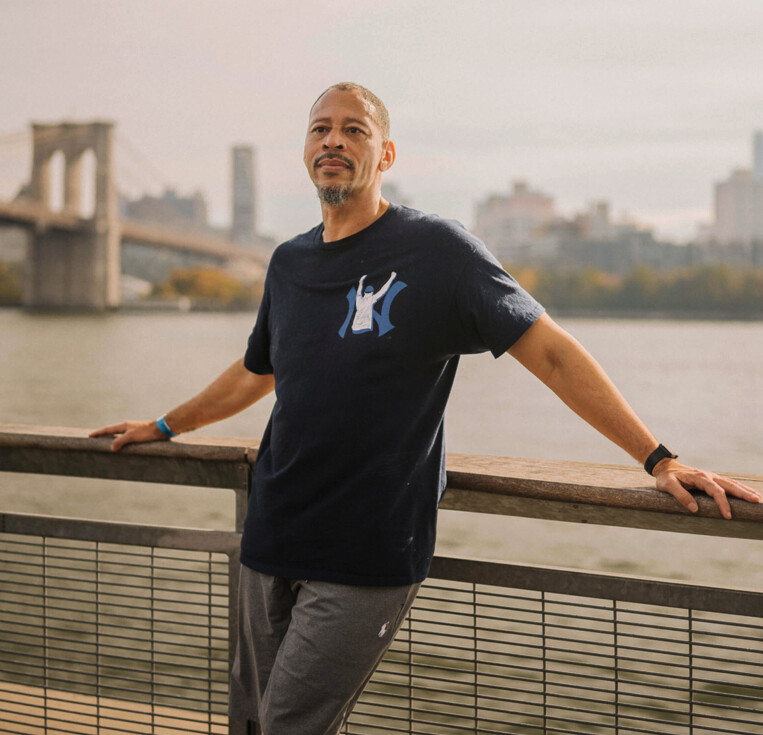
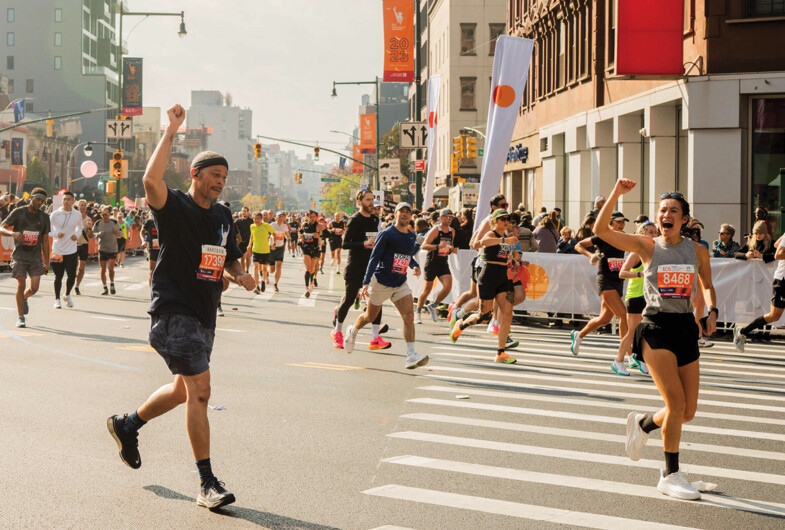
For Rahsaan and the other San Quentin runners, Mount Tam, as it’s known, had become a beacon of hope. It’s the site of the legendary Dipsea, a 7.4-mile technical trail from Mill Valley to Stinson Beach. After the 1,000 Mile Club was founded in 2005, it became tradition for club members who got released to run that trail; their stories soon became lore among the runners still inside. “I’ve been hearing about the Dipsea for the longest,” Rahsaan says.
Given his sentence, he never expected to run it. Rahsaan was serving 55 years to life for second-degree murder. Life outside, let alone running over Mount Tam all the way to the Pacific, felt like a million miles away. But Rahsaan loved to run—it gave him a sense of freedom within the prison walls, and more than that, it connected him to the community of the 1,000 Mile Club. So if the volunteer coaches and other runners wanted to talk about the Dipsea, he was happy to listen.
We’ll get to the details of Rahsaan’s crime later, but it’s useful to lead with some enduring truths: People can grow in even the harshest environments, and running, whether around a lake or a prison yard, has the power to change lives. In fact, Rahsaan made a lot of changes after he went to prison: He became a mentor to at-risk youth, began facing the reality of his violence, and discovered the power of education and his own pen. Along the way, Rahsaan also prayed for clemency. The odds were never in his favor.
To be clear, this is not a story about a wrongful conviction. Rahsaan took the life of another human being, and he’s spent more than two decades reckoning with that fact. He doesn’t expect forgiveness. Rather, it’s a story about a man who you could argue was set up to fail, and for more than 30 years that’s exactly what he did. But it’s also a story of navigating the delta between memory and fact and finding peace in the idea that sometimes the most formative things in our lives may not be exactly as they seem. And mostly, it’s a story of transformation—of learning to do good in a world that too often encourages the opposite.
RAHSAAN “NEW YORK” THOMAS GREW UP IN BROWNSVILLE, A ONE-SQUARE-MILE SECTION OF EASTERN Brooklyn wedged between Crown Heights and East New York. As a kid he’d spend hours on his Commodore 64 computer trying to code his own games. He loved riding his skateboard down the slope of his building’s courtyard. On weekends, he and his friends liked to play roller hockey there, using tree branches for sticks and a crushed soda can for a puck.
Once a working-class Jewish enclave, Brownsville started to change in the 1960s, when many white families relocated to the suburbs, Black families moved in, and city agencies began denying residents basic services like trash pickup and streetlight repairs. John Lindsay, New York’s mayor at the time, once referred to the area as “Bombsville” on account of all the burned-out buildings and rubble-filled empty lots. By 1971, the year after Rahsaan was born, four out of five families in Brownsville were on government assistance. More than 50 years later, Brownsville still has a poverty rate close to 30 percent. The neighborhood’s credo, “Never ran, never will,” is typically interpreted as a vow of resilience in the face of adversity. For some, like Rahsaan, it has always meant something else: Don’t back down.
The first time Rahsaan didn’t run, he was 5 or 6 years old. He had just moved into Atlantic Towers, a pair of 24-story buildings beset with rotting walls and exposed sewer pipes that housed more than 700 families. Three older kids welcomed him with their fists. Even if Rahsaan had tried to run, he wouldn’t have gotten far. At that age, Rahsaan was skinny, slow, and uncoordinated. He got picked on a lot. Worse, he was light-skinned and frequently taunted as “white boy.” The insult didn’t even make sense to Rahsaan, whose mother is Black and whose father was Puerto Rican. “I feel Black,” he says. “I don’t feel [like] anything else. I feel like myself.”
Rahsaan hated being called white. It was the mid-1970s; Roots had just aired on ABC, and Rahsaan associated being white with putting people in chains. Five-Percent Nation, a Black nationalist movement founded in Harlem, had risen to prominence and ascribed godlike status to Black men. Plus, all the best athletes were Black: Muhammad Ali. Reggie Jackson. Kareem Abdul-Jabbar. In Rahsaan’s world, somebody white was considered physically inferior.
Raised by his mother, Jacqueline, Rahsaan never really knew his father, Carlos, who spent much of Rahsaan’s childhood in prison. In 1974, Jacqueline had another son, Aikeem, with a different man, and raised her two boys as a single mom. Carlos also had another son, Carl, whom Rahsaan met only once, when Carl was a baby. Still, Rahsaan believed “the myth,” as he puts it now, that one day Carlos would return and relieve him, his mom, and Aikeem of the life they were living. Jacqueline had a bachelor’s degree in sociology and worked three jobs to keep her sons clothed and fed. She nurtured Rahsaan’s interest in computers and sent him to a parochial school that had a gifted program. Rahsaan describes his family as “upper-class poor.” They had more than a lot of families, but never enough to get out of Brownsville, away from the drugs and the violence.
Some traumas are small but are compounded by frequency and volume; others are isolated occurrences but so significant that they define a person for a lifetime. Rahsaan remembers his grandmother telling him that his father had been found dead in an alley, throat slashed, wallet missing. Rahsaan was 12 at the time, and he understood it to mean his father had been murdered for whatever cash he had on him—maybe $200, not even. Now he would never come home.
Rahsaan felt like something he didn’t even have had been taken from him. “It just made me different, like, angry,” he says. By the time he got to high school, Rahsaan resolved to never let anyone take anything from him or his family again. “I started feeling like, next time somebody tryin’ to rob me, I’m gonna stab him,” he says. He started carrying a knife, a razor, rug cutters—“all kinds of sharp stuff.” Rahsaan never instigated a fight, but he refused to back down when threatened or attacked. It was a matter of survival.
The first time Rahsaan picked up a gun, it was to avenge his brother. Aikeem, who was 14 at the time, had been shot in the leg by a guy in the neighborhood who was trying to rob him and Rahsaan. A few months later, Rahsaan saw the shooter on the street, ran to the apartment of a drug dealer he knew, and demanded a gun. Rahsaan, then 18, went back outside and fired three shots at the guy. Rahsaan was arrested and sent to Rikers Island, then released after three days: The guy he’d shot was wanted for several crimes and refused to testify against Rahsaan.
By day, Rahsaan tried to lead a straight life. He graduated from high school in 1988 and got a job taking reservations for Pan Am Airways. He lost the job after Flight 103 exploded in a terrorist bombing over Scotland that December, and the company downsized. Rahsaan got a new job in the mailroom at Debevoise & Plimpton, a white-shoe law firm in midtown Manhattan. He could type 70 words a minute and hoped to become a paralegal one day.
Rahsaan carried a gun to work because he’d been conditioned to expect the worst when he returned to Brownsville at night. “If you constantly being traumatized, you constantly feeling unsafe, it’s really hard to be in a good mind space and be a good person,” he says. “I mean, you have to be extraordinary.”
After high school, some of Rahsaan’s friends went to Old Westbury, a state university on Long Island with a rolling green campus. He would sometimes visit them, and at a Halloween party one night, he got into a scrape with some other guys and fired his gun. Rahsaan spent the next year awaiting trial in county jail, the following year at Cayuga State Prison in upstate New York, and another 22 months after that on work release, living in a halfway house in Queens. He got a job working the merch table for the Blue Man Group at Astor Place Theater, but the pay wasn’t enough to support the two kids he’d had not long after getting out of Cayuga.
He started selling a little crack around 1994, when he was 24. By 27 he was dealing full-time. He didn’t want to be a drug dealer, though. “I just felt desperate,” he says. Rahsaan had learned to cut hair in Cayuga, and he hoped to save enough money to open a barbershop.
He never got that opportunity. By the summer of 1999, things in New York had gotten too hot for Rahsaan and he fled to California. For the first time in his 28 years, Rahsaan Thomas was on the run.
EVERY RUNNER HAS AN ORIGIN STORY. SOME START IN SCHOOL, OTHERS TAKE UP RUNNING TO IMPROVE their health or beat addiction. Many stories share common themes, if not exact details. And some, like Rahsaan’s, are absolutely singular.
Rahsaan drove west with ambitions to break into the music business. He wanted to be a manager, maybe start his own label. His new girlfriend would join him a week later in La Jolla, where they’d found an apartment, so Rahsaan went first to Big Bear, a small town deep in the San Bernardino Mountains 100 miles east of Los Angeles. It’s where Ryan Hall grew up, and where he discovered running at age 13 by circling Big Bear Lake—15 miles—one afternoon on a whim. Hall has recounted that story so many times that it’s likely even better known than the American records he would go on to set in the half and full marathons.
Rahsaan didn’t know anything about Ryan Hall, who at the time was just about to start his junior year at Big Bear High School and begin a two-year reign as the California state cross-country champion. He didn’t even know there was a lake in Big Bear. Rahsaan went to Big Bear to box with a friend, Shannon Briggs, a two-time World Boxing Organization heavyweight champion.
Briggs and Rahsaan had grown up together in Atlantic Towers. As kids they liked to ride bikes in the courtyard, and later they went to the same high school in Fort Greene. But Briggs’s mom had become addicted to drugs by his sophomore year, and they were evicted from the Towers. Briggs and Rahsaan lost touch. Briggs began spending time at a boxing gym in East New York; often he’d sleep there. He had talent in the ring. People thought he might even be the next Mike Tyson, another native of Brownsville who was himself a world heavyweight champ from 1986 to 1989.
Briggs went pro in 1991, and by the end of that decade he was earning seven figures fighting guys like George Foreman and Lennox Lewis. Rahsaan was at those fights. The two had reconnected in 1996, when Rahsaan was trying to rebuild his life after prison and Briggs’s boxing career was on the rise. In August 1999, Briggs was gearing up to fight Francois Botha, a South African known as the White Buffalo, and had decamped to Big Bear to train. “He was like, ‘Yo, come live with me, bro,’” Rahsaan recalls.
Briggs was running three miles a day to increase his stamina. His route was a simple out-and-back on a wooded trail, and on one of Rahsaan’s first days there, he decided to join him. Rahsaan hadn’t done so much as a push-up since getting out of prison, but he wanted to hang with his friend. Briggs and his training partners set off at their usual clip; within a few minutes they’d disappeared from Rahsaan’s view. By the time they were doubling back, he’d barely made it a half mile.
Rahsaan never liked feeling physically inferior. So back in La Jolla, he started running a few times a week, going to the gym, whatever it took. Before long he was up to five miles. And the next time he ran with Briggs, he could keep up. After that, he says, “Running just became my thing.”
FOR YEARS, RAHSAAN HAD BUCKED AT TAKING RESPONSIBILITY for the murder that sent him to prison. The other guys had guns, too, he insisted. If he hadn’t shot them, they’d have shot him. It was self-defense.
In the moment, he had no reason to think otherwise. It was April 2000. A friend had arranged to sell $50,000 worth of weed, and Rahsaan went along to help. They met in the parking lot of a strip mall in L.A., broad daylight. The buyers brought guns instead of cash, things went sideways, and, in a flash of adrenaline, Rahsaan used the 9mm he’d packed for protection, killing one man and putting the other in critical condition. He was 29 and had been in California eight months.
After awaiting trial for three years in the L.A. County jails, Rahsaan was sentenced to 55 years to life. But for the crushing finality of it, the grim interminability, the prospect of never seeing the outside world again, he was on familiar ground. Even Brownsville had been a kind of prison—one defined, as Rahsaan puts it now, by division and neglect, a world unto itself that societal forces made nearly impossible to escape. He was used to life inside.
Rahsaan spent the next 10 years shuttling between maximum security facilities, the bulk of those years at Calipatria State Prison, 30 miles from the Mexican border. By the time he got to San Quentin, he was 42.
As part of the prison’s restorative justice program, Rahsaan met a mother of two young men who’d been shot, one killed and the other critically injured. Her pain, her dignity, her ability to forgive her sons’ shooters prompted Rahsann to reflect on his own crime. “It made me feel like, damn, I did this to his mother,” he says. “I did this to my mother. You don’t do that to Black mothers. They go through so much.”
ABOUT 2 MILLION PEOPLE ARE INCARCERATED IN THE UNITED States today, roughly eight times as many as in the early 1970s. Nearly half of them are Black, despite Black Americans representing only 13 percent of the U.S. population.
This disparity reflects what the legal scholar and author Michelle Alexander calls “the new Jim Crow,” an invisible system of oppression that has impeded Black men in particular since the days of slavery. In her book of the same title, Alexander unpacks 400 years of policies and social attitudes that have created a society in which one in three Black males will be incarcerated at some point in their lives, and where even those who have been paroled often face a lifetime of discrimination and disenfranchisement, like losing the right to vote. If you hit a wall every time you try to do something, are you really free? More than half of the people released from U.S. jails and prisons return within three years.
After Rahsaan got out of Cayuga back in 1992, with a felony on his permanent record, he’d had trouble doing just about anything legit: renting an apartment, finding a decent job, securing a loan. Though he’d paid for the Mercedes SUV he drove to California, the lease was in his girlfriend’s name. Selling crack had provided financial solvency, and his success in New York made him feel invincible. One weed deal in California seemed easy enough. But he wasn’t naive. Rahsaan packed a gun, and if he felt he had to use it, he would.
Today Rahsaan feels deep remorse for what transpired from there. But back then he saw no other way. “When we have a grievance, we hold court in the street,” he says of growing up in the Brownsville projects. “There’s no court of law, there’s no lawsuits.” Even while incarcerated, Rahsaan continued to meet threats with violence. But he also found that in prison, as in Brownsville, respect was temporary. “If you stab somebody, people leave you alone,” he says. “But you gotta keep doing it.”
Not long after Rahsaan got to Calipatria, around 2003 or 2004, an older man named Samir pulled him aside. “Youngster, there’s nobody that you can beat up that’s gonna get you out of prison,” Rahsaan remembers Samir saying. “In fact, that’s gonna make it worse.” Rahsaan thought about Muhammad Ali, how he would get his opponents angry on purpose so they’d swing until they wore themselves out. He realized that when you’re angry, you’re not thinking clearly or moving effectively. You’re not responding; you’re reacting.
The next time Rahsaan saw Samir was in the yard at Calipatria. They were both doing laps, and the two men started to run together. Rahsaan told Samir about the impact his words had on him, how they helped him see he’d always let “somebody else’s hangup become my hangup, somebody else’s trauma become my trauma.” Each time that happened, he realized, he slid backward.
Rahsaan began exploring various religions. He liked how the men in the Muslim prayer group at Calipatria encouraged him to think about his past, and the way they talked about God’s plan. He thought back to that day in April 2000 and came to believe that God would have gotten him out of that situation without a gun. “If I was meant to die, I was meant to die,” he says. “If I’m not, I’m not.” He started to see confrontations as tests. “I stopped feeding into the negativity and started passing the test, and I’ve been passing it consistently since,” he says.
CLAIRE GELBART PLACED HER BELONGINGS IN A PLASTIC TRAY AND WALKED THROUGH THE METAL detectors at the visitors’ entrance at San Quentin. She crossed the Yard to the prison’s newsroom. It was late fall of 2017, and Gelbart had started volunteering with the San Quentin Journalism Guild, an initiative to teach incarcerated people the fundamentals of newswriting and interviewing techniques.
Historically infamous for housing people like Charles Manson and Sirhan Sirhan, the man convicted of killing Robert Kennedy, and for having the only death row for men in California, San Quentin has in recent years instituted reforms. By the time Rahsaan arrived, the facility was offering dozens of programs, had an onsite college, and granted some of the individuals housed there considerable freedom of movement. Hundreds of volunteers pass through its gates every year.
Rahsaan was in the newsroom working on a story for the San Quentin News, where he was a staff writer. Gelbart and Rahsaan started to chat, and within minutes they were bonding over running. They talked about the San Quentin Marathon—in which Rahsaan was proud to have placed 13th out of 13 finishers in 6 hours, 12 minutes, and 23 seconds—and Gelbart’s plans to run her first half marathon that spring. “It was like I lost all sense of place and time,” Gelbart says, “like I could have been in a coffee shop in San Francisco talking to someone.”
In weekly visits over the next year, Gelbart and Rahsaan talked about their families, their hopes for the future. Gelbart had just graduated from Tufts University with dreams of being a writer. Rahsaan was working toward a college degree, writing for numerous outlets like the Marshall Project and Vice, and learning about podcasting and documentary filmmaking. In 2019, when Gelbart was offered a job in New York, she told Rahsaan she felt torn about leaving—they’d become close friends. They made a pact that if Rahsaan ever got out of prison, they would run the New York City Marathon together. “We couldn’t think of a better thing to celebrate him coming home,” Gelbart says.
When Rahsaan was sentenced, he still had hope for a successful appeal. But when his appeal was denied in 2011, he realized he was never going home. His parole date was set for 2085.
At the time, though, the political appetite for mass incarceration was starting to shift. Gray Davis, who was governor of California from 1999 to 2003, had never granted a single pardon; and his successor, Arnold Schwarzenegger, granted only 15. Then, between 2011 and 2019, Governor Jerry Brown pardoned or commuted the sentences of more than 1,300 people. Studies show that the recidivism rate among those who had been serving life sentences is less than 5 percent in a number of states, including California. And according to the U.S. Bureau of Justice, 98 percent of people convicted of homicide who are released from prison do not commit another murder.
In the fall of 2018, Governor Brown approved Rahsaan for commutation, but it was now up to his successor, Gavin Newsom, to follow through. And until a release date was set, there were no guarantees.
Back at San Quentin, Rahsaan was busier than ever. He was working on his fourth film, Friendly Signs, a documentary funded by the Marshall Project and the Sundance Institute; it was about fellow 1,000 Mile Club member Tommy Lee Wickerd’s efforts to start an ASL program to aid a group of deaf and hard-of-hearing newcomers to the prison. He had recently been named chair of the San Quentin satellite chapter of the Society of Professional Journalists and became a cohost and coproducer of Ear Hustle, a popular podcast about life in San Quentin that in 2020 was a finalist for a Pulitzer Prize. He was also sketching out plans for a nonprofit, Empowerment Ave, to build connections to the outside world for other incarcerated writers and artists and to advocate for fair compensation. And after five years, he was just one history class away from getting his associate’s degree from Mount Tamalpais College.
In January 2020, Rahsaan began his final semester, eager to don his cap and gown that June. MTC always organized a festive graduation ceremony in the prison’s visiting room, inviting families, friends, students, and staff. Then COVID-19 hit. Lockdown. All classes canceled until further notice. The 1,000 Mile Club suspended workouts and races as well, its 70-plus members scattering throughout the prison, not sure when or if they’d ever get together again. Covid would officially kill 28 people at San Quentin and make many more very ill. College graduation, let alone races in the Yard and parole hearings, would have to wait.
For the first time since arriving at San Quentin, Rahsaan felt claustrophobic in his 4-by-10-foot cell. He couldn’t work on his films or go to the newsroom. All he could do was read and write, alone. After George Floyd was murdered that May, Rahsaan fell into a depression. He remembered something Chadwick Boseman had said in a 2018 commencement speech at Howard University: “Remember, the struggles along the way shape you for your purpose.”
Rahsaan decided his purpose was to write. Outside journalists couldn’t enter the prison during the pandemic, but their publications were thirsty for prison Covid stories. Rahsaan saw an opportunity. Between June 2020 and February 2023, he published 42 articles, and thanks to Empowerment Ave, he knew what those articles were worth. As a writer for the San Quentin News, Rahsaan earned $36 a month; those 42 articles for external publications netted him $30,000.
DOZENS OF PEOPLE GATHERED OUTSIDE SAN QUENTIN’S GATES. IT WAS A FRIGID MORNING IN EARLY February 2023; the sun hadn’t yet risen. Among those assembled were two cofounders of Ear Hustle, Earlonne Woods and Nigel Poor, along with executive producer Bruce Wallace, recording equipment in hand. A procession of white vans, each carrying one or two men, arrived one by one. After three or four hours, the air had warmed to a balmy 60 degrees. Another van pulled up, Rahsaan got out, and the crowd erupted. Nearly 23 years after he’d been sentenced to 55 years to life, Rahsaan Thomas had been released.
Rahsaan got into a Hyundai sedan and was soon headed away from San Quentin. Wallace sat in the back, recording Rahsaan seeing water, mountains, and a highway from the front seat of a car for the first time in decades. “I feel like I’m escaping,” he joked. “Is anybody chasing us? This is amazing. This is crazy.”
Rahsaan called his mom, who wasn’t able to make it to California for his release.
“Hey, Ma, it’s really real,” he said, breathless with joy. “I’m free. No more handcuffs.”
Jacqueline’s exuberance can be heard in her laughter, her curiosity about what his first meal would be (steak and French toast), and her motherly rebuke of his plan to buy a Tesla.
“You ain’t been drivin’ in a while and I know you ain’t the best driver in the world,” she teased.
Rahsaan moved into a transitional house in Oakland and wasted no time adjusting to life in the 21st century. He got an iPhone, and a friend gave him a crash course in protecting himself from cyberattacks. He’s almost fallen for a few. “There’s some rough hoods on the internet,” he jokes. Earlonne Woods, who was paroled in 2018, and others taught Rahsaan how to use social media. He opened Instagram and Facebook accounts and worked on his own website, rahsaannewyorkthomas.com, which a friend had built for him while he was in San Quentin to promote his creative projects, Empowerment Ave, and even a line of merch.
Despite all the excitement and chaos, Rahsaan never forgot about the pact he’d made with Claire Gelbart. He found her on Facebook and sent a simple, two-line message: “Start training. We have a marathon to run.”
IN LATE MARCH, SIX WEEKS AFTER HIS RELEASE, RAHSAAN FLEW TO NEW YORK CITY. IT WAS THE FIRST time he’d been home in nearly a quarter century, and he hadn’t flown since before 9/11. The security protocols at SFO reminded him more of prison than of the last time he’d been in an airport. Actually, “it was worse than prison,” he jokes. They confiscated his jar of honey.
The changes to his home borough were no less surprising. He’d come to New York to take work meetings, see family, and catch a Nets game at Barclays Center in downtown Brooklyn. Rahsaan barely recognized Barclays; it had been a U-Haul lot the last time he was there, and skyscrapers now towered over Fulton Mall, where he used to buy Starter jackets at Dr. Jay’s and Big Daddy Kane tapes at the Wiz.
He met up with Gelbart on Flatbush Avenue, where come November they’d be just hitting mile 8 of the New York City Marathon. They hadn’t been allowed to touch at San Quentin and weren’t sure how to greet each other on the outside. “It was weird at first, because I was like, do we hug?” Gelbart recalls. But the awkwardness faded fast, and as they walked, Gelbart saw a different side of Rahsaan. “He seemed so much more relaxed,” she says. “Much happier, much lighter.”
Back in 1985, just a few blocks from where Rahsaan and Gelbart walked now, Rahsaan, his brother Aikeem, and his friend Troy had been on their way home from the Fulton Mall when out of nowhere, about a dozen guys rolled up on them. They started beating on Troy and, for a minute, left Rahsaan and Aikeem alone. Images of his father, throat slashed, flashed through Rahsaan’s mind. He pulled a rug cutter out of his pocket, ran to the smallest guy in the group, and jabbed it into the back of his head. “They looked at me like they were gonna kill me,” Rahsaan says. He threw the blade to the ground, slid his hand inside his coat, and held it there. “Y’all wanna play? We gonna play,” he said. The bluff worked; the guys ran. It was the first time Rahsaan had ever stabbed someone.
Change sometimes occurs gradually, and then all at once. That was a different Brooklyn, a different Rahsaan. He began to confront his own violence when he had met Samir some 20 years before, and continued to do so through his studies, his faith, his work in restorative justice, and his own writing. But the origin of his tendency toward violence, the death of his father, remained firmly rooted in his psyche. Then, in 2017, Rahsaan spoke for the first time with his estranged half-brother, Carl.
Carl had read Rahsaan’s work, and asked why he always said their father had been murdered.
“That’s what grandma told me,” Rahsaan said.
“But he wasn’t murdered,” Carl told him. “He killed himself.”
And it wasn’t in 1982, as Rahsaan remembered, but in 1985—the same year Rahsaan started carrying blades.
Rahsaan didn’t believe it until Carl sent him a copy of the suicide note. Even then he remained in shock. “To think I justified violence, treating robbery like a life-or-death situation, over a lie,” he says. Jacqueline was as surprised as Rahsaan to learn the truth of Carlos’s death. He never seemed troubled or depressed to her when they were together, but, “You can’t really read people,” she says. “You don’t know.”
Rahsaan still can’t account for why his grandmother told him what she did, nor for the discrepancy between his memory and the facts. Regardless, after more than 30 years, Rahsaan was finally able to let go of the one trauma that had calcified into an instinct to kill or be killed. And he has no intention of dredging it back up.
THE FASTEST RUNNER IN THE 1,000 MILE CLUB’S HISTORY IS MARKELLE “THE GAZELLE” TAYLOR, WHO was paroled in 2019 and went on to run 2:52 in the 2022 Boston Marathon. Rahsaan is the slowest. At San Quentin, he was often the last one to finish a race, but that wasn’t the point—he liked being out in the Yard with the guys. It gave him a sense of belonging, and not just to the 1,000 Mile Club, but to the running community beyond.
Like every other 1,000 Miler who gets released from San Quentin, Rahsaan had a rite of passage to conquer. On Sunday morning, May 7, 2023, he met a handful of other runners from the club and a few volunteer coaches in Mill Valley. After a decade of gazing up at Mount Tam from the Yard as he completed one 400-meter loop after another, Rahsaan was finally about to run over the mountain all the way to the Pacific.
The runners did a few final stretches, wished one another luck, and started to run. Almost immediately they had to climb some 700 stairs, many made of stone, and the course only got more treacherous from there. Uneven footing, singletrack paths, and 2,000-plus feet of elevation all conspire to make the Dipsea notoriously difficult. The giant redwoods and Douglas firs along the course were lost on Rahsaan; he never took his eyes off the ground.
One of the coaches, Jim Maloney, stayed with Rahsaan as his guide, and to help him if he slipped or fell. Markelle Taylor came too, but said he’d meet them in Stinson Beach. He knew how dangerous the trail was, Rahsaan says, and had vowed to never run it again. After his own initiation, Rahsaan decided that he, too, would never do it again. “I’ve been shot at,” he says. “I’ve been in physical danger. I don’t want to revisit danger.”
Rahsaan now logs most of his miles on a treadmill because of knee issues, but on occasion he ventures out to do the 3.4-mile loop around Lake Merritt, a lagoon in the heart of Oakland. He decided to use the New York City Marathon to raise money for Empowerment Ave, and to accept donations until he crossed the finish line in Central Park. Gelbart wrote a training plan for him and got him a new pair of shoes. In prison, Rahsaan had run in the same pair of Adidas for three years, and he was excited to learn about the maximalist shoe movement. Gelbart tried to interest him in Hokas, but Rahsaan thought they were ugly. He wanted Nikes.
In June, Gelbart went to the Bay Area to visit family and met Rahsaan for a six-mile run around Lake Merritt. As they looped the lake at a conversational 11:30 pace, they talked about work, relationships, and, of course, the New York City Marathon. Rahsaan was disappointed to learn that he would probably not be the last person to finish. (He still holds the record for the slowest San Quentin Marathon in its 15-year history, and he hopes no one ever beats it.) Besides, the more time he spent on the course in New York, he figured, the longer people would have to donate to Empowerment Ave.
On Sunday, November 5, Gelbart and Rahsaan made their way to Staten Island. Waiting at the base of the Verrazzano Bridge, Gelbart recorded Rahsaan singing along to Frank Sinatra’s “New York, New York” for Instagram, and captioned the video “back where he belongs.” They documented much of their race as they floated through Brooklyn, Queens, Manhattan, and the Bronx: greeting friends along the course, enjoying a lollipop on the Queensboro Bridge, beaming even as their pace slowed from 11:45 per mile for the first 5K to 16:30 for the last. Rahsaan finished in six hours, 26 minutes, and 21 seconds, placing 48,221 out of 51,290 runners. The next day, he sent me a text: “The marathon was pure love.” What’s more, he received more than $15,000 in donations for Empowerment Ave, enough to start a writing program at a women’s prison in Texas.
Every runner has an origin story. Every runner finds a reason to keep going. At Calipatria, Rahsaan liked to joke that he ran because if an earthquake ever came along and brought down the prison’s walls, he needed to be in shape so he could escape and run to Mexico. In San Quentin, he ran for the community. Today he has a new reason. “I heard that running extends your life by 10 years,” he says, “and I gave away 22.” Now that he’s out, his motivation has never been higher. He has so much to do.
Login to leave a comment
Ben Flanagan breaks his national record at Canadian 10K
It wasn’t obvious from the start that he was going for the Canadian record, but Ben Flanagan made a move halfway into the Canadian 10K Championships at Tamarack Ottawa Race Weekend (also known as the Ottawa 10K, putting distance between himself, marathoner Rory Linkletter and Jeremy Coughler, and held on for the win, squeaking past his Canadian record by two seconds, to finish in 28:09. (The previous record, held jointly with Canadian marathon record holder Cam Levins, was 28:11.)
“I wanted to stay on the gas and in that final kilometre I gave it everything I had,” Flanagan told Canadian Running post-race. His final kilometre was a split of two minutes and 38 seconds. Linkletter finished second in Ottawa, in 28:40 (a new personal best) and Coughler third, in 28:55 (also a personal best).
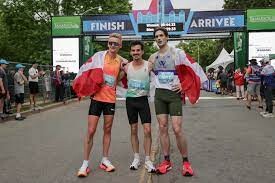
It was overcast and about 18 C in Ottawa Saturday–slightly warmer than ideal for racing, but less hot than it has been in recent years, which was a relief for the runners and made fast times possible. The race began with a fairly sedate 2:57 split, but got progressively faster (the third-kilometre split was 2:45). Flanagan took advantage of the hard downhill turn where the race crosses the canal, to make his move. It was a $6,000 payday for Flanagan, who will get $5,000 for the win and an additional $1,000 bonus for the national record.
Linkletter will be disappointed not to take the national championship, something he has yet to accomplish in his career; he is Canadian, but lives and trains in Flagstaff, Arizona, under former American marathoner Ryan Hall. Linkletter has been named to the Canadian marathon team for the Paris Olympics, along with Levins. Flanagan is also qualified for the Olympics (in the 5,000m), but has not yet been officially selected.

Coughler won his third consecutive Spring Run-Off 8K in Toronto’s High Park in April; in 2023, he won the Canadian 10,000m Championships.
For Flanagan and Linkletter, Saturday’s race was almost a repeat of the 2022 event, which Flanagan also won (in 28:40), with Linkletter finishing second.
by Anne Francis
Login to leave a comment
Ottawa 10K
Ottawa's course is fast, scenic and few elevation changes. Considered to be an excellent course for first timers and should provide an environment conducive to setting a PR. The Ottawa 10K is the only IAAF Gold Label 10K event in Canada and one of only four IAAF Gold Label 10Ks in the world. The Ottawa 10K attracts one of the...
more...U.S. Olympic Marathoners Will Race the Bolder Boulder 10K as a Pre-Paris Tune-Up
Conner Mantz, Clayton Young, and Leonard Korir will run in the International Pro Team Challenge on May 27.
Memorial Day is always an exceptional celebration for runners in Boulder, Colorado, but this year, it will have some extra special Olympic flair.
On Monday, May 27, more than 40,000 runners will run through the city that’s known for the iconic Flatirons rock formations, the Pearl Street pedestrian mall, and an exceptionally active population in the annual Bolder Boulder 10K. Now in its 44th year, it’s been one of the top road running races in the U.S. since its inception, and this year will serve as one of the final tune-ups for the men’s U.S. Olympic marathon squad before racing in the Paris Olympics later this summer.
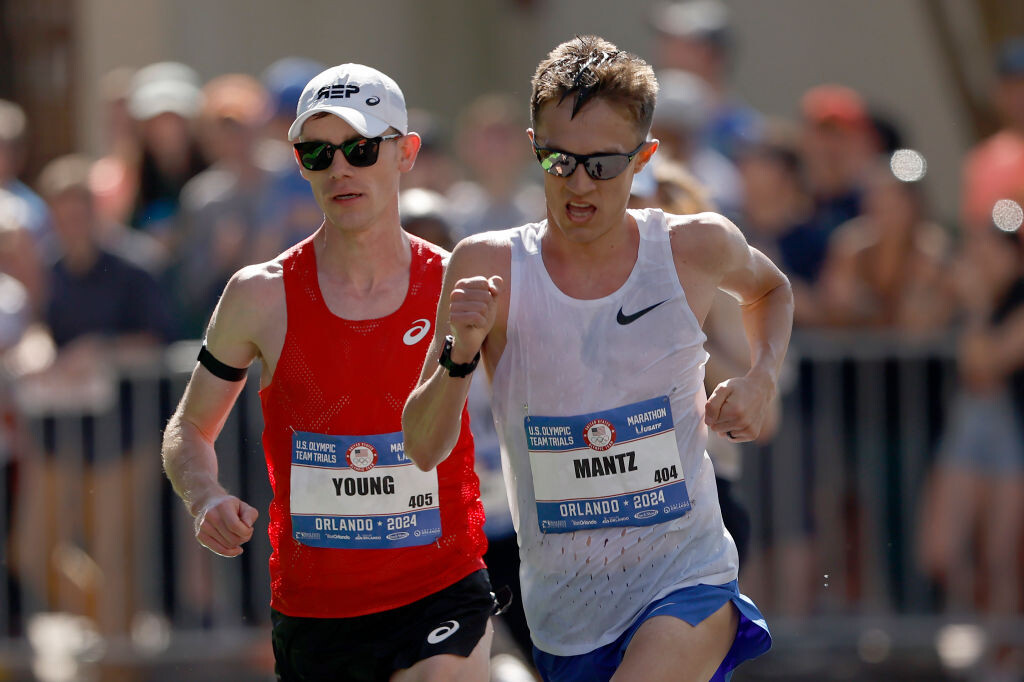
Conner Mantz, Clayton Young, and Leonard Korir, the top three finishers in the 2024 U.S. Olympic Trials who will be racing the marathon in the Paris Olympics on August 10, will be competing as Team USA Red in the Bolder Boulder’s International Pro Team Challenge that follows the citizen’s races. (Korir is expected to officially be named to the U.S. team in early May based on final pre-Olympic international rankings.)
The pro race, which has a prize purse of $83,700 before potential bonuses, is one of the things that makes the Bolder Boulder so unique. After all the runners in 98 citizen waves have completed the race, professional men’s and women’s international teams from more than a dozen countries compete on the same course for team and individual titles. The races feature a staggered start, with women beginning 15 minutes before the men so the winners of each race will finish about 10 minutes apart inside the University of Colorado’s Folsom Field football stadium.
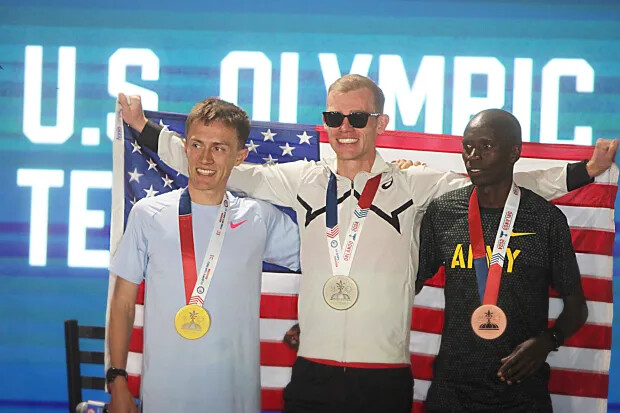
The finishing moments are among the thrilling spectacles in American running. By that point, the stadium is filled with a near-capacity crowd of roaring runners, family, and friends who have been watching the action play out on the massive video screens.
“The finish in the full stadium is like nothing else in the sport,” says Mantz, 27, who won the men’s race last year in 29:08 with a thrilling late-race surge to pass Kenya’s Alex Masai in the final 200 meters before the finish. “It was pretty electric. It took away all the pain you’re feeling mid-race. I was like, ‘Just race as hard as you can.’”
Team USA Red will have plenty of competition, from Team USA White, the secondary American team of Jared Ward, Futsum Zienasellassie, and Sam Chelanga, as well as teams from Kenya, Ethiopia, Mexico, and Rwanda. Teams are scored like a cross country race, with points awarded on the basis of finishing place, which means the team with the lowest combined score for all three runners is the winner. Ties are decided by the positions of the third-place finishers.
The women’s Team USA Red team will be led by defending champion Emily Durgin, along with Sara Hall and Boulder native Nell Rojas. Durgin finished ninth at the U.S. Olympic Trials in February and won the USATF 10 Mile Championships on April 7 in Washington D.C. At last year’s Bolder Boulder, she stormed to victory in 33:24, winning by 24 seconds over Kenya’s Daisy Kimeli.
Hall placed fifth in the U.S. Olympic Trials Marathon on February 3 in a U.S. master’s record (2:26:06) and 15th in the Boston Marathon on April 15. The women’s Team USA White roster will be composed of an all-University of Colorado alumnae squad—Makena Morley, Sara Vaughn, and Carrie Verdon.
“I can’t wait to be back in Boulder for the best day of the year,” says Durgin, 29, who will compete in the U.S. Olympic Trials 10,000 meters on the track in late June with the hopes of making the U.S. Olympic team. “Competing with Nell and Sara will make the experience even better.”
The women’s U.S. Olympic marathon team of Fionna O’Keefe, Emily Sisson, and Dakotah Lindwurm were invited to race in the Bolder Boulder but each runner declined, citing scheduling timing conflicts or a disinterest in racing at Boulder’s lofty altitude (5,430 feet). All of the runners who are racing for the U.S. teams in Boulder live at 4,500 feet or higher.
An Olympic Legacy
Boulder is known as one of the top running meccas in the U.S., in part because elite-level American and international runners have made it their training base since Olympic gold medalist Frank Shorter arrived in the early 1970s. Emma Coburn, Jenny Simpson, Yared Nuguse, Joe Klecker, Jake Riley, Hellen Obiri, and Edna Kiplagat are among the many top-level runners who are currently training in Boulder. Shorter, the 1972 marathon gold medalist, was a co-founder of Bolder Boulder 10K in 1979, and helped it grow into one of the country’s largest races.
Since then, numerous U.S. Olympians have raced in the Bolder Boulder, including Deena Kastor (a three-time women’s champion), Aliphine Tuliamuk (the 2022 women’s winner), Alan Culpepper, Elva Dyer, Ryan Hall, Abdi Abdirahman, Jorge Torres, Shalane Flanagan, Amy Cragg, Magdalena Boulet, and Libby Hickman, as well as Korir (who won it in 2022), and Ward (who was fourth in 2022).
Thanks to Boulder’s robust running community and the prestige of the race, the Bolder Boulder has also always featured fast sub-elite runners competing in the early citizen waves. Yet, the race has also celebrated dedicated middle-of-the-pack runners, as well as the first-time runners and walkers in the later waves. It was one of the first races to have bands playing along the course (as well as belly dancers and other entertainers), runners dressed up in costumes, elite wheelchair races, and in recent years, it has been known for a mid-race slip-and-slide and unofficial bacon aid station.
For the past 25 years, the Bolder Boulder has organized a special Memorial Day tribute—one of the largest in the country—that honors military veterans and new cadets.
The U.S. men’s Olympic marathon team competing in this year’s Bolder Boulder will be a legacy moment for the race, says Bolder Boulder race director Cliff Bosley.
“Having the three men that will represent our country in the marathon at this summer’s Paris Olympic Games is something we are extremely proud of,” Bosley says. “All three ran here last year, and to have them back is just incredible for the race, the city of Boulder, and the sport of running.”
by Brian Metzler
Login to leave a comment
World Athletics to raise marathon standards for 2025 World Championships
The men's standard is expected to go up to 2:06:30, and the women's standard will be 2:23:30
On Tuesday, the marathon entry standards for the 2025 World Athletics Championships in Tokyo were leaked to social media, and the men’s and women’s marathon qualification marks seem to be getting a lot tougher.
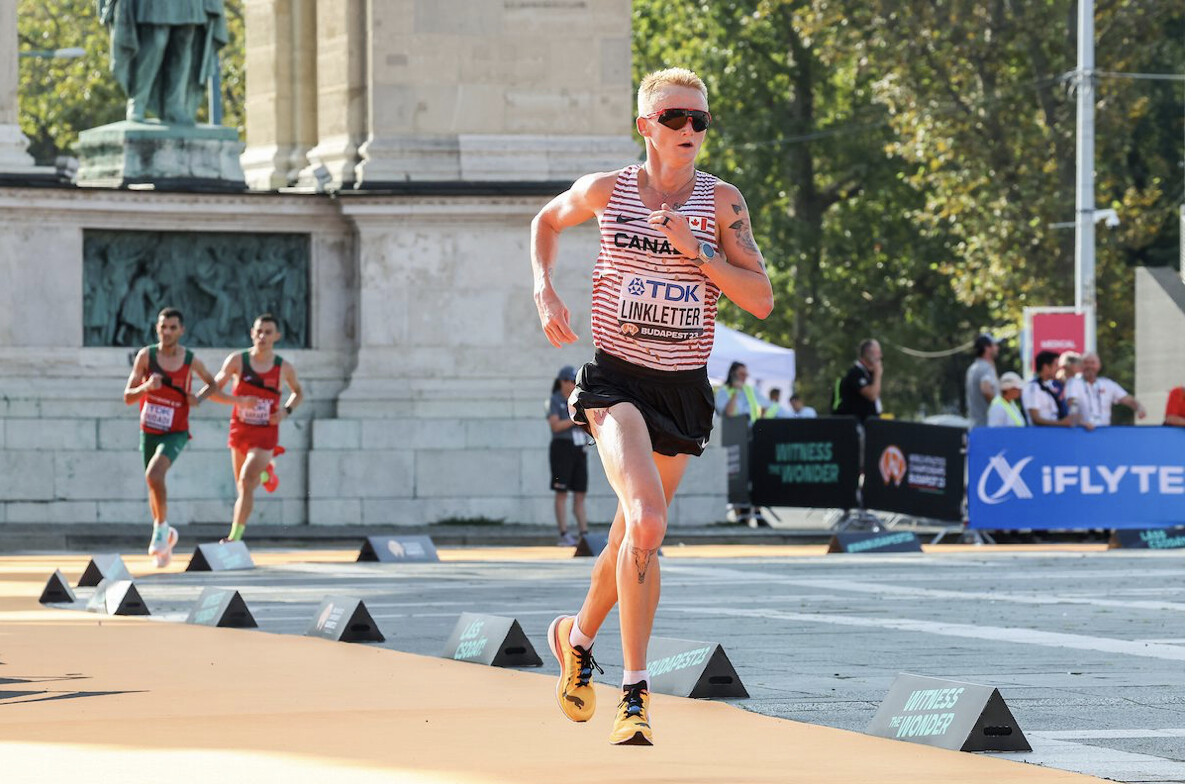

The women’s marathon entry standard is expected to be increased by three minutes and 20 seconds, to 2:23:30, from the previous 2:26:50 mark for the Paris Olympics. With the number of female athletes recording sub-2:20 times, most expected to see an increase in the women’s standard.
The men’s marathon standard is expected to see an increase of one minute and 40 seconds, to 2:06:30, from its previous mark of 2:08:10. Only 91 athletes have hit this new mark in the Paris Olympic qualifying window (November 1, 2022 to April 30, 2024). Sixty-five of those 91 athletes are Kenyan and Ethiopian.When the women’s marathon entry standard was released for the Paris Olympics, World Athletics intended for a near 50/50 split in runners hitting the entry standard and the rest of the field qualifying via the World Athletics rankings and points system. The number of women who will qualify on points for the Paris Olympics will be zero, with 82 women of the (soft cap) of 80 spots hitting the Olympic standard of 2:26:50.The new standard of 2:23:30 is a mark only two Canadian female marathoners have surpassed (Natasha Wodak’s Canadian record of 2:23:12 from the 2022 Berlin Marathon and Malindi Elmore’s 2:23:30 from Berlin in 2023). One hundred and fifteen female athletes have run under this mark in the Paris Olympic qualifying window, with the top mark being Tigist Assefa’s world record of 2:11:53 in Berlin. Even though Elmore’s mark equalled the Tokyo WC qualifying mark in September 2023, her time will not get her into the 2025 World Championship marathon, since the qualifying window did not open until November.
Only four North American men have ever run under the proposed 2025 World Championship standard: Canada’s Cam Levins (2:05:35–Tokyo 2023) and three Americans: Khalid Khannouchi (2:05:38–London 2002), Galen Rupp (2:06:07–Prague 2018) and Ryan Hall (2:06:17–London 2008).World Athletics’ tougher standards come with the organization’s goal to create a dual pathway of qualification, with 50 per cent of athletes qualifying through entry standards and the remaining 50 per cent qualifying through World Rankings and its points system.
by Running magazine
Login to leave a comment
Meet the marathon guru behind three of North America's top runners
It’s been an exciting start to the year for Brigham Young University (BYU) cross-country and track head coach Ed Eyestone. In February, three athletes who once ran for Eyestone at BYU qualified for the Paris Olympics in the men’s marathon, including Canada’s Rory Linkletter, who hit the Olympic standard at last weekend’s Sevilla Marathon, running a two-minute-plus personal best of 2:08:01.
Eyestone, who coached Linkletter for five years at BYU before Linkletter turned pro (he is now coached by former U.S. marathoner Ryan Hall), knew he was ready for a breakout performance after watching Linkletter execute a top-20 finish in the marathon at the 2023 World Championships in Budapest. “I was super excited for him, and told him he was next, after the U.S. marathon trials,” says Eyestone. “To see him execute on race day, and run a fast time, I was proud of him.”

“It turns out that the group of 10K runners we had in 2018 was special,” laughs Eyestone. Linkletter ran for BYU in Provo, Utah, from 2015 to 2019, and just happened to be a part of a special group of young runners who would turn out to be three of North America’s top marathoners. U.S. Olympic Marathon Trials champion Conner Mantz and second-place finisher Clayton Young also ran at BYU during this time; they helped lead the Cougars XC team to three top-three finishes and an NCAA championship title in 2019.
“Looking back on that 2018 team, we were second and now have three men who’ve run faster than 2:08:10… if only the NCAA’s was 26.2 miles,” Eyestone laughs.
“Every high school athlete we recruit has aspirations of running professionally or being an Olympian one day,” he says. “I know with Mantz, he was heavily recruited out of high school, and he wanted to go to a school that would one day prepare him for the marathon.”
Eyestone’s coaching philosophy for developing long-distance athletes is not rocket science. He believes in long-term progression, so his athletes aren’t maxing out in college, and are leaving the window open for higher mileage post-collegiately. “I’ll have my 5,000m and 10,000m guys run around 80 miles a week, with a long run of 90 minutes,” he says. Eyestone has continued to coach Mantz and Young at the professional level, and still swears by not having them do much over two-hour long runs. “We have a great program at BYU, and it’s not unusual for Mantz and Young to hop in and work out with the college kids.”
BYU is an altitude school, standing at 1,400 metres above sea level, and has a large recruiting pool and an extensive following, with its affiliation with the Church of Jesus Christ of Latter-day Saints.
When Eyestone arrived as a coach at BYU in 2000, his goal was to build a culture to become a powerhouse program in the NCAA. “We wanted to recruit guys who wanted to challenge for an NCAA XC podium spot every year,” he says. “It all starts at the beginning of the year, with the team’s veterans setting the tone and getting younger athletes and recruits to buy in.”
Despite Linkletter choosing to part ways with Eyestone as his coach in 2019, the two remain close friends and share a level of respect for one another. “Rory is an incredible leader; he was our team captain,” says Eyestone. “He would always hold the team accountable for showing up on time and developing a healthy routine […] I remember he called it Ferrari fuel.”
Eyestone’s favourite thing about being a coach is being able to see the ripple effect of a good performance or win on an athlete’s family and personal life. “My son-in-law told me on Sunday after Rory’s race that four percent of the athletes in the men’s marathon in Paris will be former BYU runners,” Eyestone revealed. “I couldn’t be more proud of them.”
Login to leave a comment
Rory Linkletter to chase Olympic marathon standard in Spain
After a short and successful stint on the indoor track to end 2023, Canadian marathoner Rory Linkletter has announced his next race, the Sevilla Marathon on Feb. 18. Linkletter’s goal is to run a personal best and book his ticket to the Paris Olympics, which will require a time of 2:08:10.
“I will be heading to Spain to run the Sevilla Marathon on Feb. 18,” Linkletter wrote on Instagram. His reasoning for choosing to race in Sevilla was to give himself ample time to recover and prepare after his 18th-place finish in the marathon at the 2023 World Athletics Championships in late August.
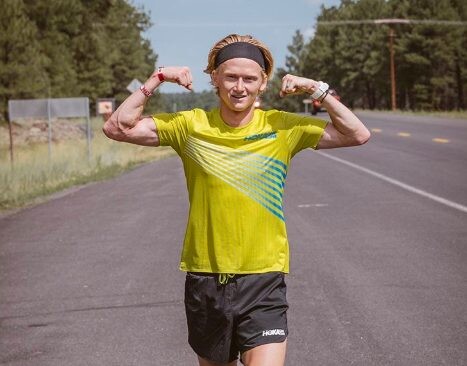
Although Linkletter’s time of 2:12:16 in Budapest was shy of his personal best, he referred to the race as the smartest he’s ever run, passing over 20 runners in the final 15 kilometers.
In Sevilla, Linkletter will be vying for the fastest time of his career, and he will need to hit the men’s Olympic A standard of 2:08:10. If he misses the standard, he can still be selected for Team Canada via the World Athletics rankings. He has a personal best of 2:10:24 from the 2022 World Championships in Eugene, Ore.
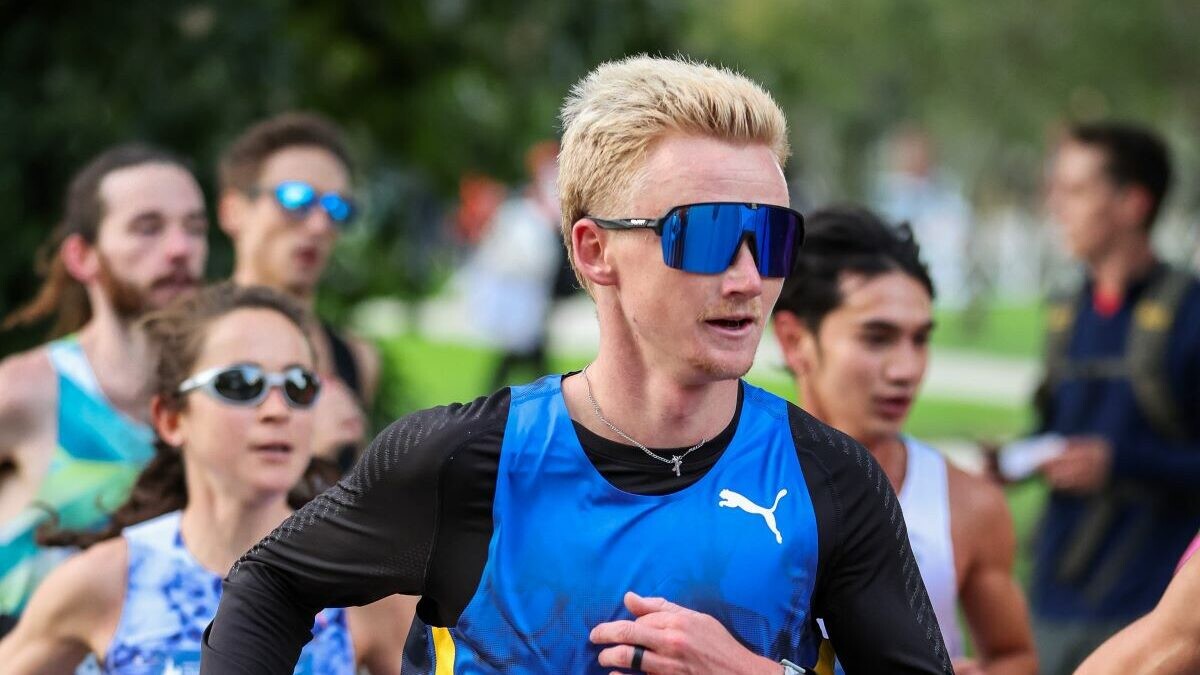
“Training is going well, and I want to set myself up well for an Olympic Standard attempt (2:08:10),” Linkletter said.
The 27-year-old had the second-fastest Canadian men’s marathon time in 2023, behind only Cam Levins’s 2:05:36 in Tokyo. Levins already has one of the three eligible marathon spots for the Canadian men’s Olympic team, but with five months left to qualify, two spots are up for grabs for Canadians who meet the Olympic B standard of 2:11:30.
If Linkletter were to hit the A or B standard, he would potentially be selected for his first Olympic Games.
The Canadian-born marathoner, who lives in Flagstaff, Ariz., has been working on his speed over the last few months with his coach, former U.S. marathoner Ryan Hall, to improve his speed. In early December, he became the 74th Canadian to run a sub-four-minute mile and only the second Canadian to accomplish the feat while also being a sub-2:12 marathoner.
He joined marathon record holder Levins as the only other Canadian to do so.
by Marley Dickinson
Login to leave a comment
Zurich Marathon Sevilla
This urban, flat, fast and beautiful brand new race course will drive athletes through the most beautiful monuments of the city. Zurich Maraton de Sevilla brings the unique opportunity to brake the Best personal result over the mythical distance to all the athletes, professional or age groupers, in one of the most perfect international marathon circuits. This fast marathon takes...
more...Elite women's marathoner Hall to run Manchester Road Race
Sara Hall, who was fifth in the World Marathon Championships last year, has entered this year's Manchester Road Race. This will be her first appearance in the Thanksgiving Day run.
Hall, 40, finished in 2:22:10 in the world event in Eugene, Oregon, and was the runner-up at the 2020 London Marathon in 2:22:01. Her personal-best for the 26.2-mile run 2:20:32, and 1:07:15.
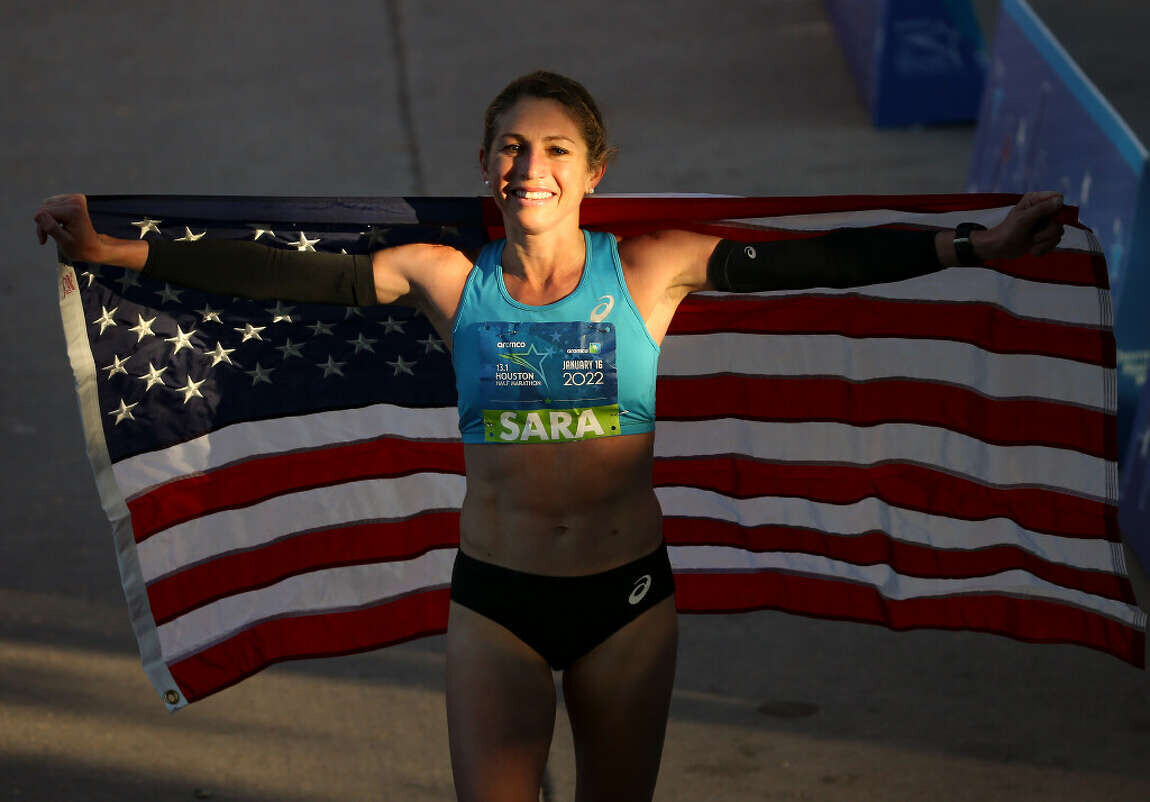
A seven-time All-American when she competed for Stanford, Hall ran the steeplechase before becoming a marathoner. She won the gold medal in the steeplechase at the 2011 Pan American Games in Mexico.
Hall is married to retired Olympic marathoner Ryan Hall. Ryan, who also competed for Stanford, set the United States records for the marathon and half marathon. In 2017, the couple adopted four young sisters from Ethiopia. The family resides in Flagstaff, Arizona.
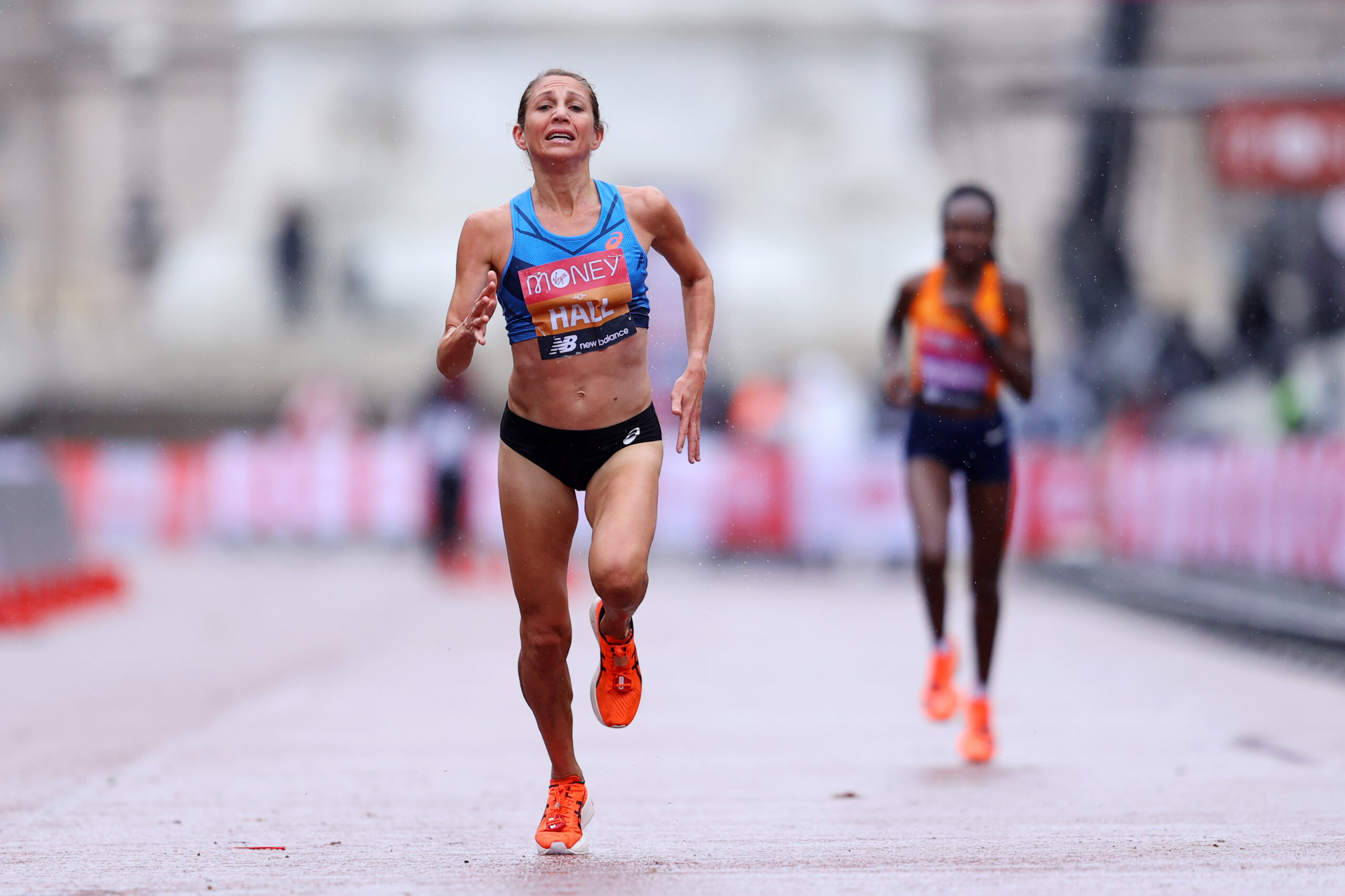
“Sara is a wonderful addition to this year’s race,” said Jim Harvey, the MRRs elite runner coordinator. “She is a very accomplished athlete and a great person.”
The 87th Manchester Road Race, which has been designated a World Athletics Label Event by World Athletics, starts at 10 a.m. on Thanksgiving Day Nov. 23. The 4.748-mile-long road race is run on a loop course through Manchester’s central district that starts and finishes on Main Street, in front of St. James Church.
Login to leave a comment
Manchester Road Race
The Manchester Road race is one of New England’s oldest and most popular road races. The 86th Manchester Road Race will be held on Thanksgiving Day. It starts and finishes on Main Street, in front of St. James Church. The Connecticut Sports Writers’ Alliance recently honored the Manchester Road Race. The CSWA, which is comprised of sports journalists and broadcasters...
more...Scott Fauble Is Aiming for the Olympic Standard at Berlin Marathon
Fauble will hope to become first American man to hit 2:08:10 Olympic standard in Sunday’s race
Scott Fauble was not planning on running a fall marathon in 2023. On April 17, he finished 7th at the Boston Marathon to earn top American honors — just as he did in Boston and New York in 2022. His time of 2:09:44 represented the fourth sub-2:10 of his career, making him just the seventh American to accomplish that feat after Ryan Hall, Galen Rupp, Meb Keflezighi, Khalid Khannouchi, Alberto Salazar, and Mbarak Hussein. In previous years, a top-10 finish at a World Marathon Major counted as an automatic qualifying standard for the Olympic marathon; Fauble, with three straight top-10 finishes on his resume, figured he was in good position for Paris and could shift his focus to the US Olympic Trials in February 2024.
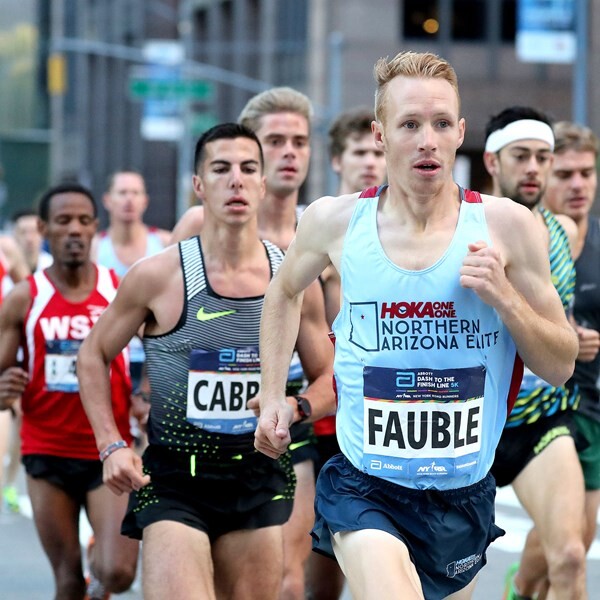
But the Olympic qualifying system for 2024 is far more complicated than in previous years, with ever-shifting world rankings and things like “quota reallocation places” creating confusion among fans and athletes alike. Any athlete ranked in the top 65 of the filtered “Road to Paris” list on January 30, 2024, is considered qualified…except the “Road to Paris” list does not currently exist. After Boston, Fauble, who is currently ranked 122nd* — that’s in the world rankings, which is a different list than “Road to Paris” — tried to take a closer look at where he stood, creating spreadsheets and projecting where he might rank after accounting for time qualifiers, the three-athlete-per-country limit, and potential changes after the 2023 fall marathon season. After a while, his brain began to hurt.
“I felt like the Pepe Silvia meme from It’s Always Sunny in Philadelphia,” Fauble said. “…It was like, this is complicated and stressful and I can just get the standard. This doesn’t need to be an issue.”
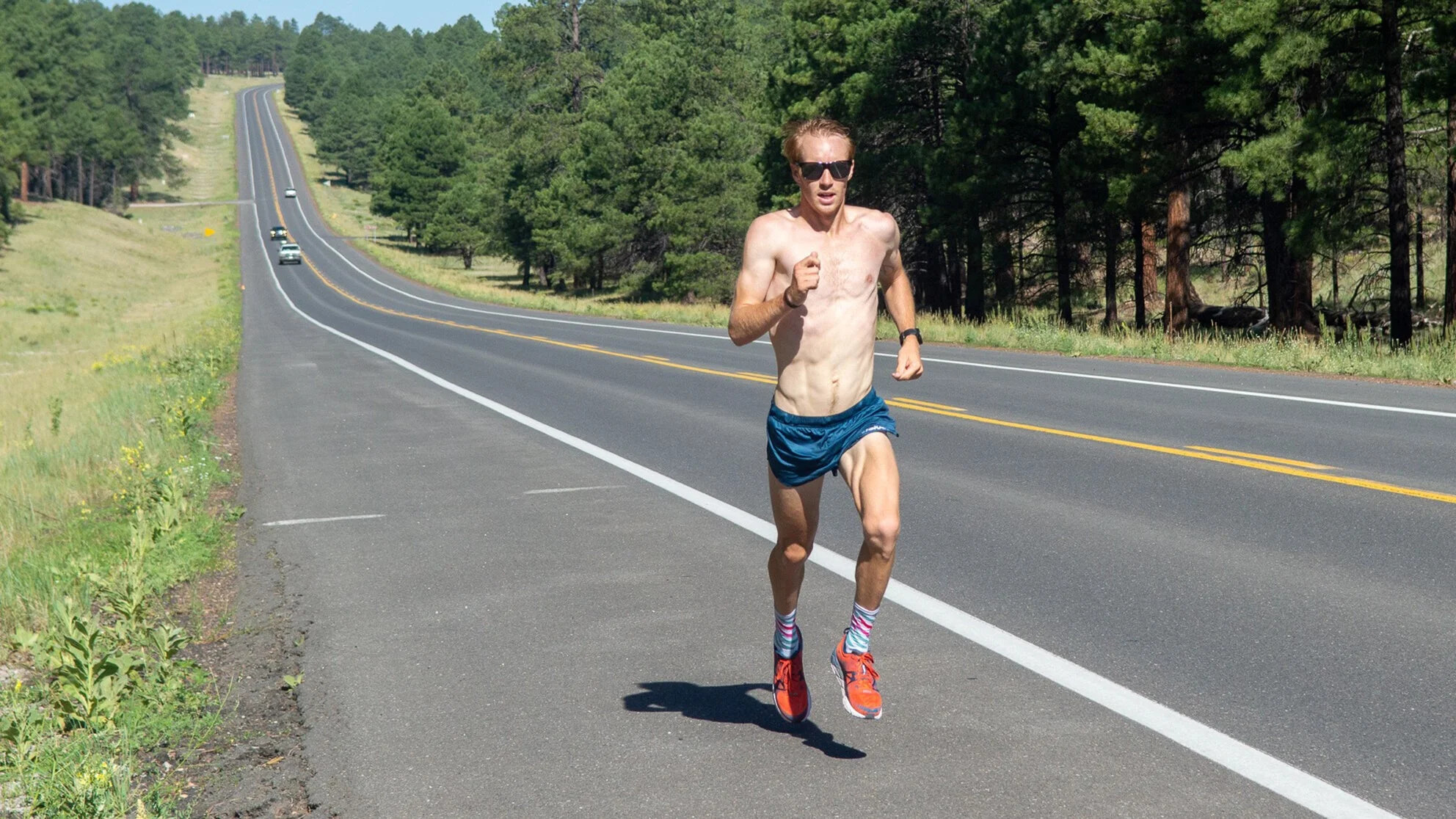
That is why Fauble, begrudgingly, made the decision to run the Berlin Marathon. He was not initially looking forward to the race, but with a strong training block in Boulder behind him and the race just four days away, he has changed his tune.
“I’m very excited,” Fauble said. “I wasn’t planning on doing a fall marathon after Boston and I had to figure out ways to get excited for it and I think that’s one of the things that has fired me up, actually seeing how fast I can go and pushing for a PR as opposed to letting the race play out and seeing what I can do.”
Chasing a time is a dramatically different approach to Fauble’s typical marathon M.O. Of the nine marathons he has run, only two have featured pacemakers: his debut in Frankfurt in 2017, and the Marathon Project in 2020. When Fauble runs Boston and New York, the hilly courses where he has found the greatest success, he does not enter with a goal time in mind. Instead, Fauble will wait until the race begins and assess a number of factors — the weather, how he’s feeling, how fast the other runners are going — before deciding which pace to run. Typically, that has led to Fauble letting the leaders go early and picking off stragglers as they fade over the second half of the race.
Berlin will be different. There are no hills to account for, and while Fauble will still fight for every place, he is not hiding the fact that the primary goal of this race is to hit a time. Specifically, the Olympic standard of 2:08:10. Only five Americans have ever bettered that time in history, but Fauble, who ran his personal best of 2:08:52 in Boston in 2022, believes he is capable of doing it.
“I don’t think that me running in the 2:07s is a huge stretch of the imagination,” said Fauble, who has removed some of the hillier routes from his training under coach Joe Bosshard but has otherwise prepared similarly for Berlin as he would Boston or New York. “I think I’ve been in that kind of shape a bunch of times.”
Every American marathoner will be rooting for Fauble
Currently, no male American marathoner has earned the 2024 Olympic standard — either by hitting the time standard of 2:08:10 or by finishing in the top five of a Platinum Label Marathon (which includes Berlin). It’s pvery likely someone such as Fauble or Conner Mantz will be ranked in the top 65 of the “Road to Paris” list at the end of January, but with the Olympic Trials less than five months away, US marathoners are getting antsy.
American pros rarely run the Berlin Marathon, typically opting for Chicago or New York in the fall — both of which pay much bigger appearance fees to American runners. But this fall, many are bypassing New York because of the date (just 13 weeks before the Trials) and the course (too slow for a shot at the Olympic standard). A sizeable crew, led by Mantz and Galen Rupp, will be in Chicago, while a far larger number than usual have opted for Berlin.
Berlin’s course is just as fast as Chicago’s, if not faster. It’s also two weeks before Chicago — an extra two weeks to prepare for the Trials — and the weather is typically a little better in Berlin than Chicago. That’s why Keira D’Amato opted for Berlin over Chicago for her American record attempt last year. It’s also why 60:02 half marathoner Teshome Mekonen — another American targeting the Olympic standard this fall — chose Berlin over Chicago.
In addition to Fauble and Mekonen, the 2023 Berlin field also includes 2016 Olympian Jared Ward, 2021 Olympian Jake Riley, and Tyler Pennel, who has finished 5th and 11th at the last two Olympic Marathon Trials. All of them will be looking to run fast. And every other American marathoner will be hoping they do the same.
That’s because of a new provision in the Olympic qualification system which states that any country with three qualified athletes may choose to send any three athletes it wants to Paris — as long as they have run at least 2:11:30 (men) or 2:29:30 (women) within the qualifying window. That’s why every American will be rooting for Fauble and others to run fast this fall: if the US has three athletes with the standard, then anyone who has run under 2:11:30 has the opportunity to make the team by finishing in the top three at the Trials.
The above provision, which World Athletics is referring to as “quota reallocation” means that someone such as Fauble could run the Olympic standard and open up a spot in Paris for an American athlete who ends up beating him at the Trials — thus taking a spot that would not otherwise be available had Fauble not run the standard. Fauble, obviously, is hoping such a scenario does not come to pass. But he is aware of the possibility and has accepted it as part of his reality.
“I don’t mind it,” Fauble said. “Sports have never really been about identifying the best team or the best athlete. They’re an entertainment product and they overemphasize very specific days on the calendar. Even if I was the only one with the standard and I get beat at the Trials, the 73-9 Warriors didn’t win the NBA title that year. You’ve gotta do it on the big days. That’s what being a professional athlete is about.”
by Jonathan Gault
Login to leave a comment
BMW Berlin Marathon
The story of the BERLIN-MARATHON is a story of the development of road running. When the first BERLIN-MARATHON was started on 13th October 1974 on a minor road next to the stadium of the organisers‘ club SC Charlottenburg Berlin 286 athletes had entered. The first winners were runners from Berlin: Günter Hallas (2:44:53), who still runs the BERLIN-MARATHON today, and...
more...Cam Levins becomes the first Canadian runner to break 2:06, running to a fifth-place finish in Tokyo
On Sunday morning in Tokyo, Cam Levins of Campbell River, B.C., solidified himself as the fastest marathoner in North American history at the 2023 Tokyo Marathon, placing fifth in 2:05:36 to shatter his previous Canadian record of 2:07:09 and breaking the long-standing North American record of 2:05:38.
The 33-year-old marathoner has put Canadian distance running on the map, once again, nearly winning the Tokyo Marathon. Levins ran the perfect race, staying patient early on and making all the right moves to contend for the victory.
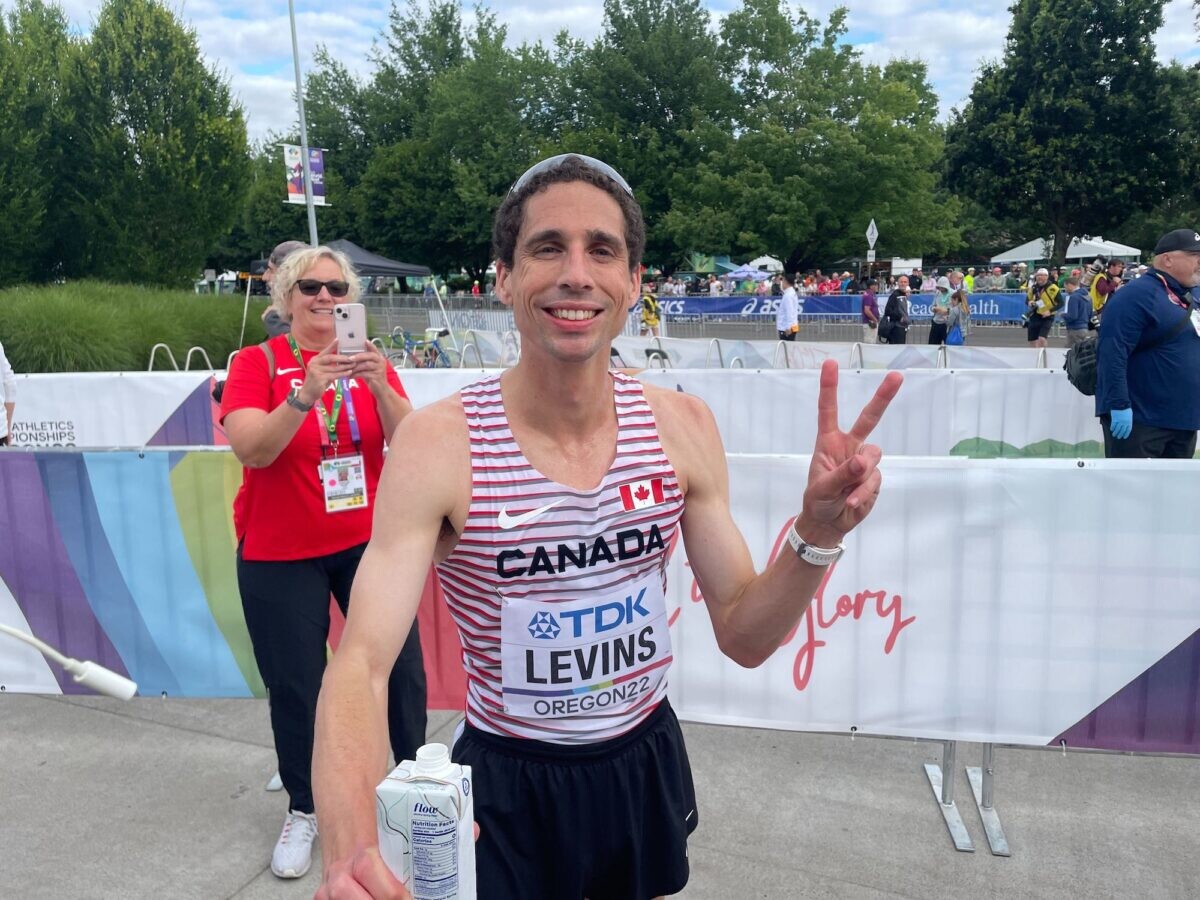
With one kilometre to go, Levins was in a group of five runners vying for the win, but Ethiopia’s Deso Gelmisa sprinted away with 400m left, winning the 2023 Tokyo Marathon.
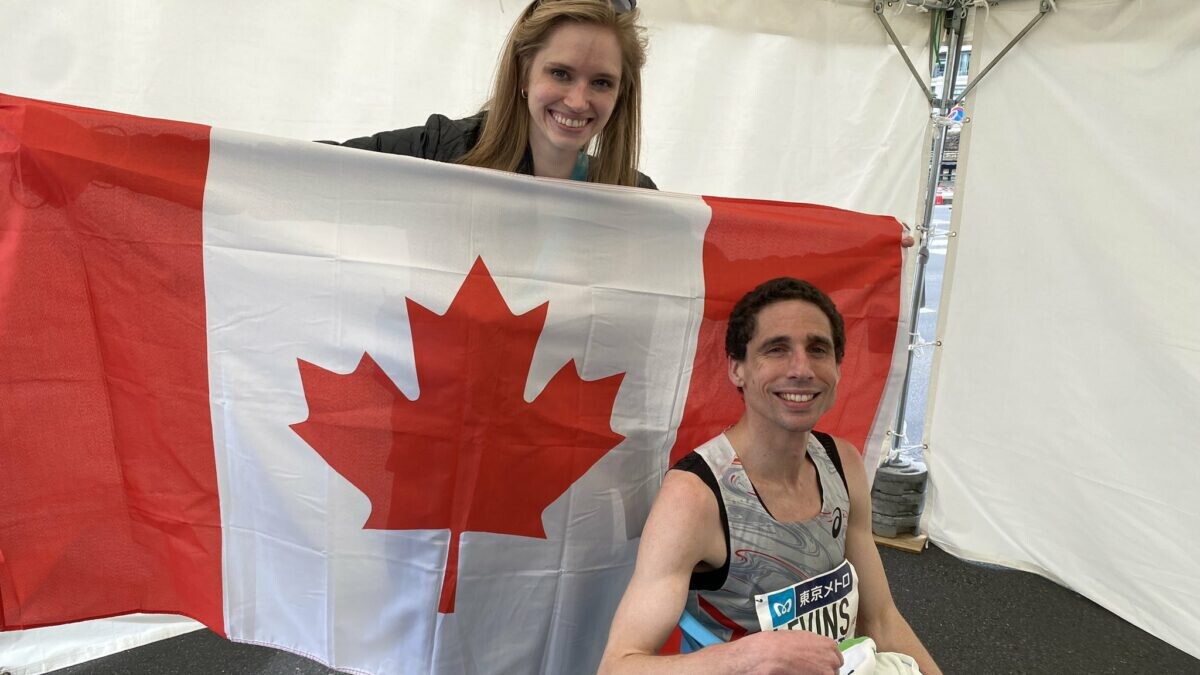
It was an Ethiopian sweep of the podium in Tokyo, with Gelmisa taking the win in his first Abbott World Marathon Major, in 2:05:22. His compatriot, Mohamed Esa, finished one second back for second, and Tsegaye Getachew was third (2:05:25).
Levins said, going into the race, that he was shooting for a time of 2:05 after his spectacular half-marathon record run of 60:18 in early February.
His time of 2:05:36 (pending ratification), breaks U.S. marathoner Khalid Khannouchi’s North American record of 2:05:38 from the 2002 Tokyo Marathon. American Ryan Hall is the only athlete to run faster than Levins, 2:04:58 at the 2011 Boston Marathon (though Boston is considered non-record-eligible by World Athletics since it is a net downhill, point-to-point course).
Cam Levins now has four of the six fastest Canadian marathon times in history.
In potentially her last major marathon, Canada’sKrista DuChene ran her fastest time in four years, clocking 2:38:53 for 19th overall. The last time DuChene, 46, broke the 2:40 mark was at the 2019 Berlin Marathon, where she ran 2:32:27.
by Running Magazine
Login to leave a comment
Tokyo Marathon
The Tokyo Marathon is a world-renowned annual marathon held in Tokyo, Japan. As one of the prestigious Abbott World Marathon Majors, it attracts elite and amateur runners from around the globe. The race holds World Athletics Platinum Label status, recognizing its high competitive standards, top-tier organization, and international appeal. Sponsored by Tokyo Metro, the Tokyo Marathon has grown into one...
more...Runners: you’re probably not eating enough protein
If you’re a runner or live an active lifestyle, you’re probably underestimating how much protein you need. Registered dietician and author Pamela Nisevich Bede touts the importance of staying on top of your protein needs and intake in her book Fuel the Fire.
Olympian and half-marathon record holder Ryan Hall has said “I wish I would have eaten more protein. I bought into the whole ‘your body can only absorb twenty grams of protein in one sitting line and wasn’t recovering optimally.” After Hall began working with a nutritionist, he discovered he was deficient in protein, and adjusted his intake: a few months later, Hall ran his best marathon ever.
“Your best bet is to consume a variety of proteins from animal and plant sources throughout the day,” Bede says. She offers some suggestions on how to dial up your protein intake and improve your performance and recovery.

Protein
Proteins are formed on building blocks called amino acids, and they are essential in keeping your immune system functioning, bones and tendons strong, healthy skin, hair and nails, and more. Exercise demands support from protein, and some research suggests athletes may require at least twice the recommended daily amount. If you are not consuming enough overall calories, protein is particularly critical, because your body will use some protein for energy–reducing the amount of protein available for other tasks.

Amino acids found in protein are often called the ‘building block’ of muscles and are key for both muscle growth and for rebuilding muscles after exercise-induced breakdown. Protein can be taken in from both animal and vegetable sources; if you’re considering changing your diet to plant-based, be aware that you’ll need protein from a range of sources (eat a varied diet).
Make sure every meal includes a protein source
Double-check what you have on your plate every time you sit down to eat (or grab a snack on the go). Depending on your running mileage and general activity level, you may need more, but Bede says that in general for athletes a snack should have at least 15 grams of protein, and a meal should include at least 30 grams.
The recommended amount of protein in both Canada and the U.S. is 0.8/kg/day, which, Bede says, is “possibly enough to support health and the activities of daily living, but is definitely inadequate to support performance.” If you’re headed for a second helping of food, opt for a protein-rich choice instead of a starch–a scoop of lentils or a small chicken breast are both lean protein options.
Plan it out, and switch it up
Plan out your meals in advance if possible to make sure you’re taking in enough protein throughout the day. If you’re vegan or simply prefer plant protein, you need to make sure you have a variety throughout the day. Bede suggests vegans consider supplementing with branched-chain amino acids (BCAAs) to ensure an adequate intake.
While plant-based protein consumption needs to be done with awareness, Bede adds that “longevity studies suggest diets including higher intakes of plant-based vs. animal-based protein and fat often leads to better health outcomes.”
Protein powders for the win
If you’re having a hard time eating enough protein, Bede says that protein powders are an appropriate option to bring into your diet, and can be added to smoothies and yogurt–options are endless. Choosing a protein powder carefully is important: avoid any brand that has ‘proprietary blends’ and supplements added, and watch for extra sugars and fat. The ideal protein powder should have 20–30 grams of protein per serving.
Protein needs vary across a spectrum, Bede says, and your personal requirements (including the amount you exercise) plus the overall quality of the protein of your diet should be considered: consulting with a registered dietician to assess your personal protein needs can be a great way to jump-start proper protein fuelling.
by Running Magazine
Login to leave a comment
Running Legend Ryan Hall Shared a Look at His 'Hybrid Athlete' Training Plan
The former Olympian's workout combines resistance training and cardio.
Ryan Hall might be best known as the Olympic long distance runner who broke records for his time in the marathon and half marathon (and holds onto that half marathon record to this day), but he has undergone a dramatic body transformation since retiring as a pro athlete. He has packed on an impressive amount of muscle—and strength—without compromising on his famous speed, and now undertakes physical challenges which require both strength and stamina.
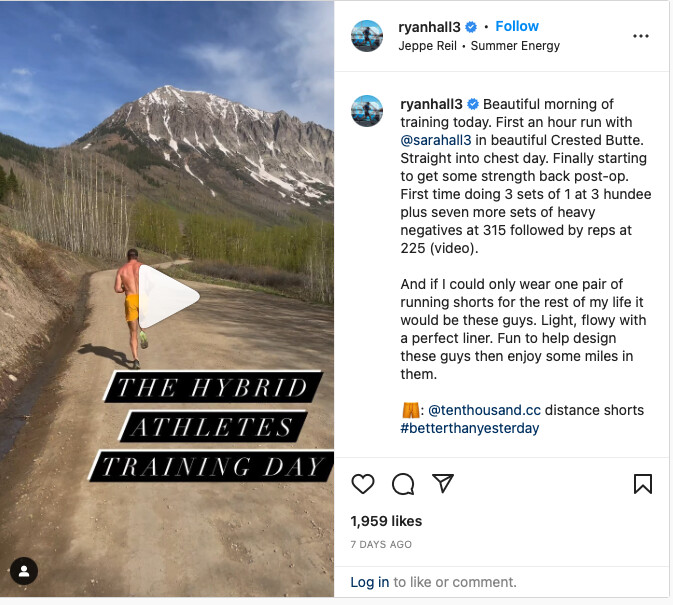
This is reflected in the way he now approaches training. In a recent video on his Instagram, Hall shared what an average day looks like for him, and described his self-designed program as a "hybrid athlete" workout.
"First an hour run with @sarahall3 in beautiful Crested Butte," he wrote in the caption. "Straight into chest day. Finally starting to get some strength back post-op. First time doing 3 sets of 1 at 3 hundee plus seven more sets of heavy negatives at 315 followed by reps at 225."
Striking that balance between strength training and cardio has been a learning experience for Hall. "It's kind of hard, honestly, cause I like going out for little 30 minute easy runs. But even with that three times a week, for me, my body just will get rid of muscle," he told Men's Health.
"Or it'll be really hard to add muscle even if I'm eating a ton of calories. So I definitely have the marathon runner genetics, the hard gainer genetics, and I have to kind of fight through that with some kind of intuitive, outside of the box training that I found has worked for me."
Login to leave a comment
Ben Flanagan and Leslie Sexton will defend Canadian 10k titles in Ottawa on May 28th
Ben Flanagan and Leslie Sexton will now defend their 2021 crowns on May 28th, 2022, at the Ottawa 10k presented by Otto’s Ottawa.
Owing to COVID restrictions – which delayed in-person racing – the Athletics Canada Canadian Championships were held in October 2021 in Toronto rather than in Ottawa last May. Flanagan raced to a 28:42 victory on the waterfront and Sexton, although crossing the line second on the day, was also crowned national champion.
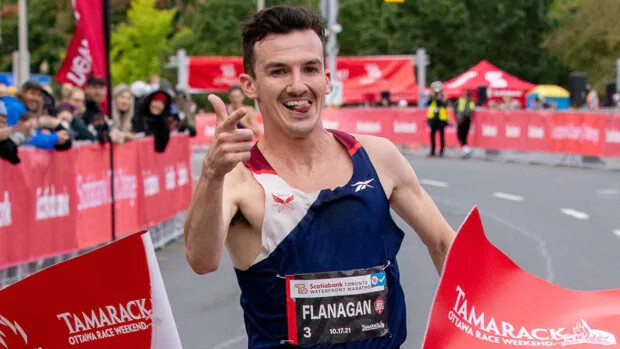
Scottish guest runner Sarah Inglis finished first but was ineligible for the prize money and the title. Sexton, who has relocated to Vancouver following several years in Kingston, Ontario, ran a personal best of 32:04. A month later she significantly lowered her best marathon time to 2:28:35 when she won the Philadelphia Marathon.
This time around Flanagan will face stiff competition from not only Luc Bruchet, a two-time Canadian Olympian at 5,000m, but also from Rory Linkletter, who is having a stellar season.
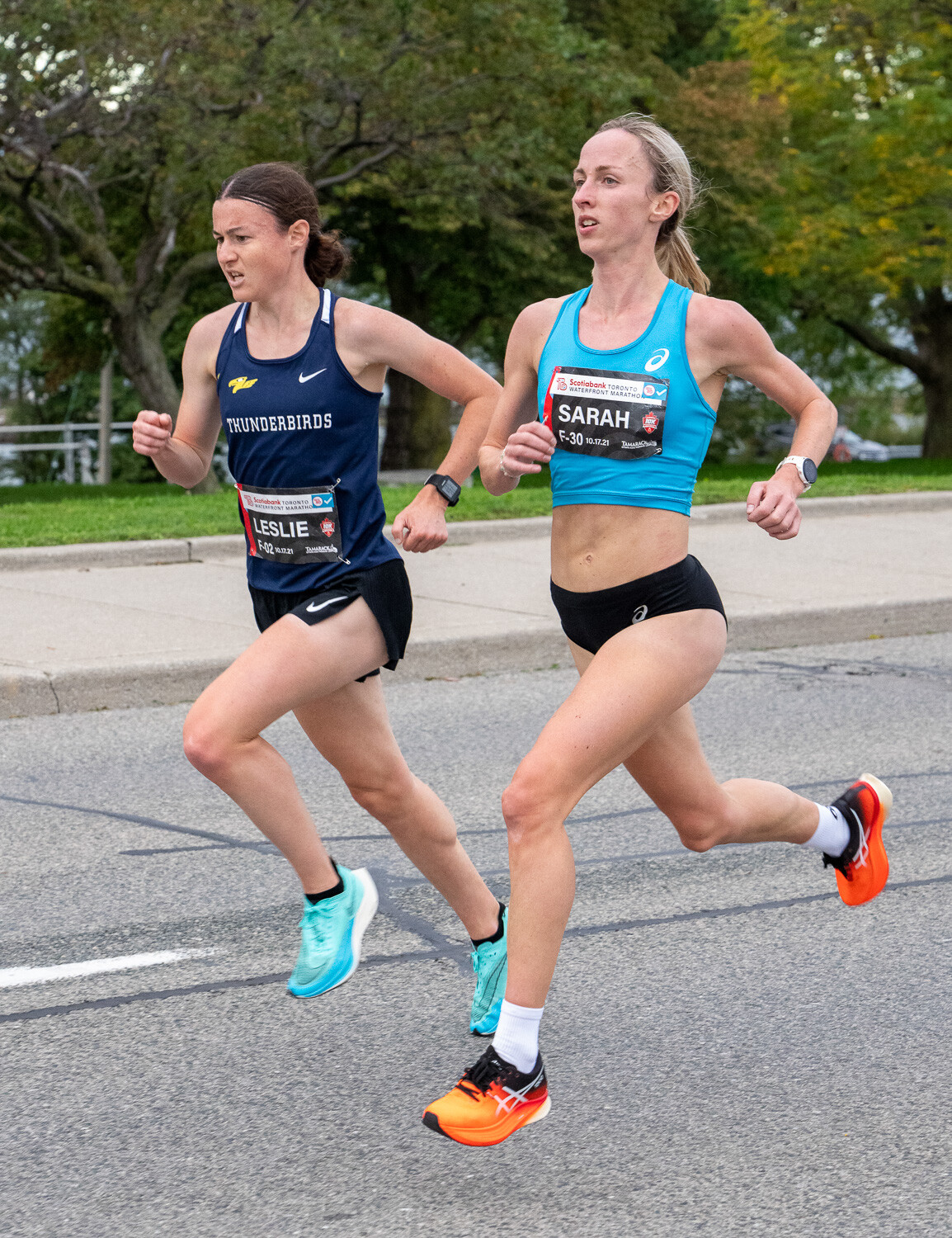
After breaking the Canadian Half Marathon record with a 1:01:08 clocking in Houston on January 16th – and finishing 20 seconds ahead of Flanagan – Linkletter ran 28:43 at the Cooper River Ridge Run 10k on April 2nd. In between those fine performances, he confirmed he has the speed to match Flanagan with an indoor 3,000m personal best of 7:49.13. That was recorded in Louisville, Kentucky on February 12th.
Linkletter, who lives and trains in Flagstaff, Arizona, parted ways with Hoka’s Northern Arizona Elite group last December to train with American marathon great Ryan Hall.
Bruchet was runner-up in that 2021 Toronto championship race with a time of 28:49. On April 24th, the 31-year-old from Vancouver set a new personal best of 28:29 in winning the Vancouver Sun Run 10k, which is a result that should cause Flanagan some concern.
Complicating his title defense a little further, Flanagan is coming back from six weeks of rehabilitation on a broken toe. But with a month of solid running, he surprised many by successfully completing a 1,500m/5,000m double at the Jesse Owens Track Classic in Ohio. He ran 3:44.98 and 14:10.07 with just ninety minutes between.
by Christopher Kelsall
Login to leave a comment
Ottawa 10K
Ottawa's course is fast, scenic and few elevation changes. Considered to be an excellent course for first timers and should provide an environment conducive to setting a PR. The Ottawa 10K is the only IAAF Gold Label 10K event in Canada and one of only four IAAF Gold Label 10Ks in the world. The Ottawa 10K attracts one of the...
more...Olympian Ryan Hall Shared His Best Advice for Working Out Before a Big Race
The record-breaking marathoner offered his tips for optimizing your pre-race routine, as well as some common mistakes to avoid.
Former Olympic athlete Ryan Hall might have packed on the muscle and set his sights on mastering feats of strength since retiring as a professional long distance runner, but he still holds the American record for fastest marathon and the world record for fastest half-marathon. All of which is to say, if you're preparing for a race yourself, there are worse people to turn to for advice.
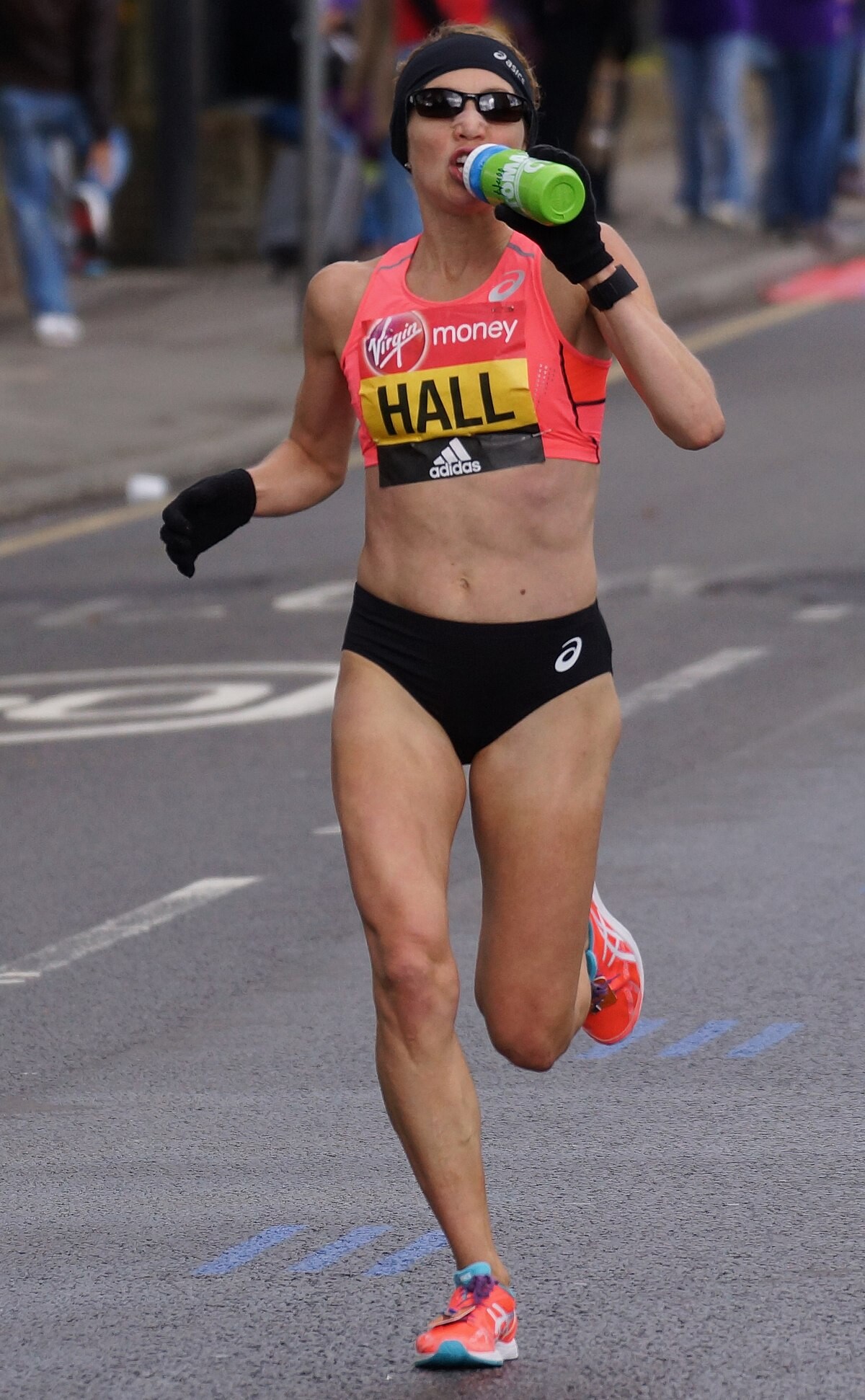
In the lengthy caption to a new Instagram post, which sees him coaching his wife and fellow ultrarunner Sara through her last training session prior to the Tokyo Marathon this coming Sunday, Hall shared his top tips on what to do—and what is best avoided—while working out before a big race day.
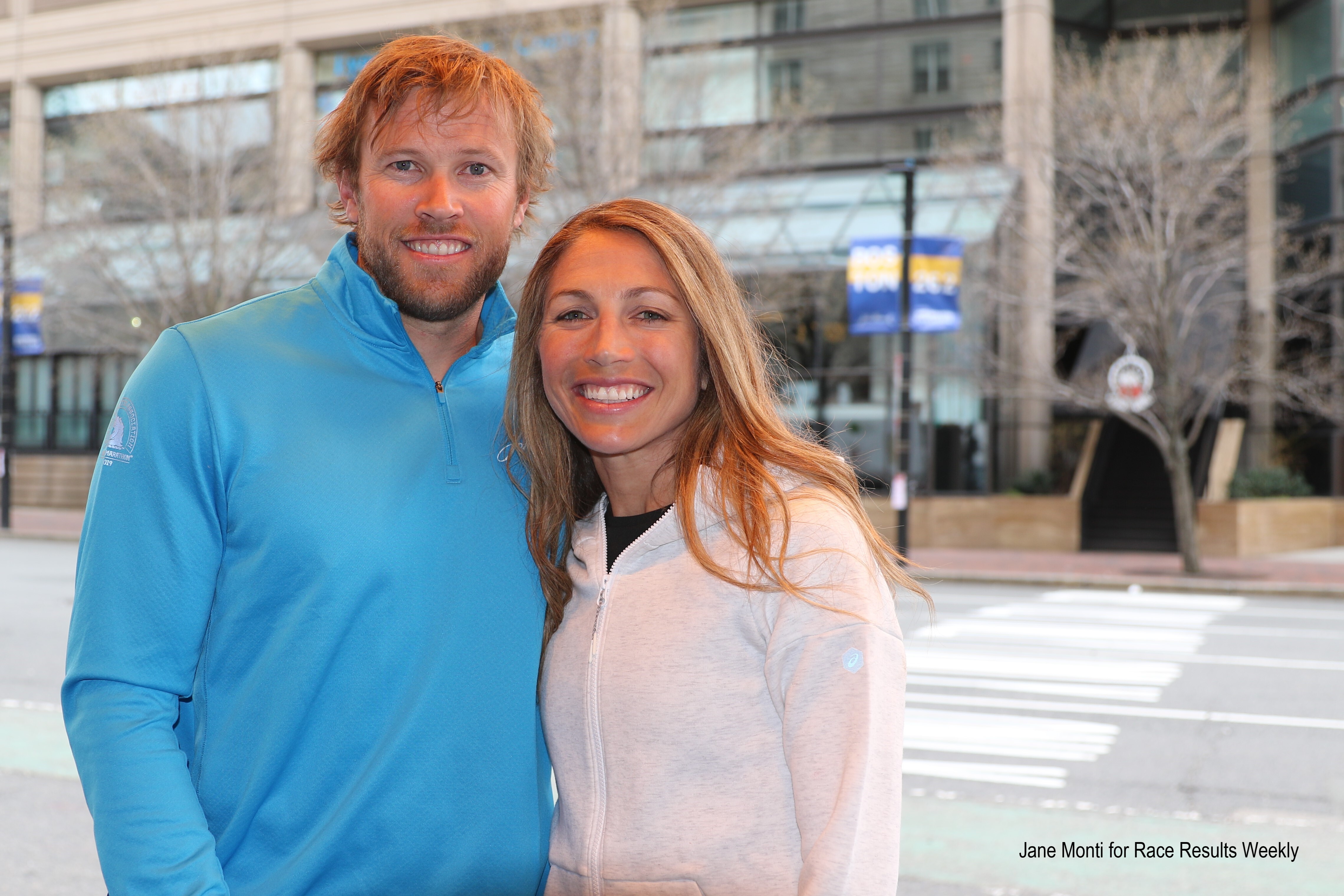
Hall notes that it can be tempting to go hard in order to try and and "prove" your fitness to yourself as you approach the big day, but that you need to resist this urge, as it can have a detrimental effect on your performance when it really matters. "This is where I see the most mistakes made," he says. "Whether it’s easy running or light workouts, the point is to show up to the starting line fresh and hungry rather than depleted and having left your best stuff in training."
If you're unsure of how intensely you should be running in the days leading up to a race, Hall suggests threshold running with long strides. In other words, running at a constant pace that does not cause lactic build-up in the muscles. "Most athletes come out of threshold workouts feeling much better compared to MVO2 max/interval workout," he says.
"Stick to what works for you," he also writes. "The only way to find out what that is is through experimentation. Play with the workout timing and components."
Preparation for a race is not just physical, though: Hall speaks about the psychological aspect as well, saying: "It’s most important that you believe in what you’re doing. Confidence is of utmost importance prior to a race."
by Mens Health
Login to leave a comment
American record-setter Sara Hall sets sights on NYC Half, says U.S. poised to dominate in 2022
Fleet-footed Sara Hall returns to action at the New York City Half next month having claimed the United States half-marathon record last month ahead of what she sees as a banner year for American athletics.
She set the U.S. record of 1:07:15 in Houston last month, beating Molly Huddle's previous best (2018) by 10 seconds, after finishing on the podium at the 2020 London Marathon and at the Chicago Marathon last year.

Joining her at the marquee New York race are Tokyo bronze medalist Molly Seidel, who finished fourth in the New York City Marathon in November, and 2021 Chicago runner-up Emma Bates.
"It's been awesome to see U.S. female marathoners either getting on the podium or being in contention every time out at the highest level every time," Hall told Reuters.
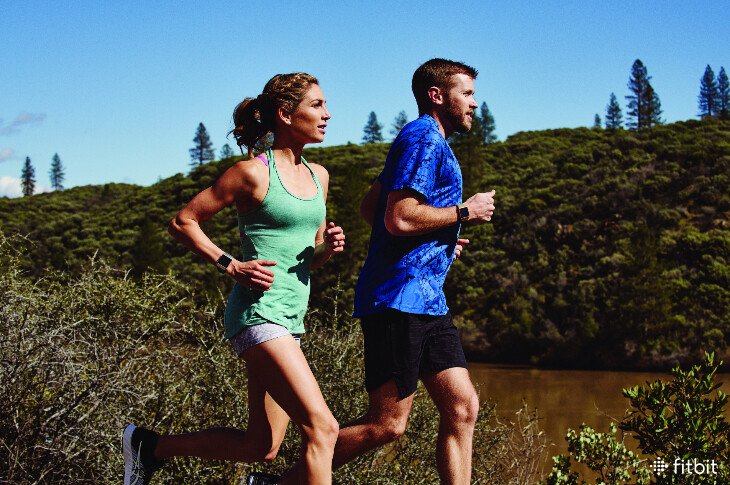
With all eyes on the U.S. when it hosts the World Athletics Championships for the first time this summer, Hall believes the U.S. could dominate at Eugene, Oregon's Hayward Field.
"USA track and field is strong against so many," said Hall. "Every event, we're in medal contention... it's a really exciting time to be a fan of the sport."
She credits her own recent run of success in part to her husband, Ryan Hall, who began coaching her after he retired from professional athletics in 2016. Whereas "tough love" has been widely embraced in athletics coaching for decades, she says his softer approach has made the difference.
Together, they hold the men's and women's American half-marathon records.
"I've had coaches in the past that were like, 'Oh, you just gave up', you know, like that kind of stuff," said Hall.
"That was really detrimental to me because it really made me believe I wasn't mentally tough. And then when you believe that about yourself, it's kind of a self-fulfilling prophecy."
Hall hopes hers can be an example in what can be achieved with a method not based in "fear," as conversation about mental health and wellbeing dominates the upper echelons of sport.
"I hope that people are seeing what creates longevity," Hall told Reuters. "That win at all costs, tough love approach, that doesn't create longevity in the sport."
The NYC Half will take place on March 20.
by Amy Tennery
Login to leave a comment
United Airlines NYC Half-Marathon
The United Airlines NYC Half takes runners from around the city and the globe on a 13.1-mile tour of NYC. Led by a talent-packed roster of American and international elites, runners will stop traffic in the Big Apple this March! Runners will begin their journey on Prospect Park’s Center Drive before taking the race onto Brooklyn’s streets. For the third...
more...You Know You Have to Get Comfortable With the Uncomfortable on Tough Runs—Here's How
All runners can benefit from learning these simple thought techniques.
Olympic medalist and champion marathoner Meb Keflezighi thought about dropping out of every marathon he ran—even the three he won.
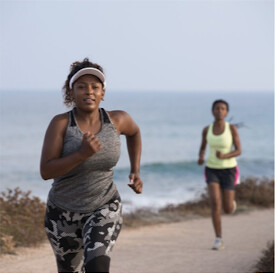
So if you’ve had those thoughts, it’s certainly not just you. All runners have rough patches when pushing themselves, whether in a race, during a hard workout, or on a long run. Experts use the phrase “psychological crisis” to describe when your body’s signals dominate your attention and you think about slowing or stopping.
These moments often occur two-thirds to three-quarters of the way through a workout or race. Speaking about the Ursuline Academy runners she coaches in Dallas, elite runner Becky Wade says: “They’re deep enough into the race that they’re hurting, but not close enough to the finish line yet to get excited or start kicking. It’s easy to doubt whether they’ll be able to hang on, and they back off a bit as a protective mechanism.”
What separates Keflezighi, Wade, and other successful runners from some of us is that they know these rough patches will come, and they have mental strength techniques for dealing with them.
These techniques are quite simple. Even better, they can be learned, and then honed, so that you persevere despite the internal voice telling you to back off or drop out. Here are six elite-endorsed ways to build mental strength when the going gets tough.
1. Know Why You’re Doing This
Good goals not only guide your training. They can also fortify you during difficult stretches.
Know the purpose of a given workout or race, and how it will help you meet a personally meaningful goal, says Olympian Roisin McGettigan, a sport psychology coach who holds the Irish record in the steeplechase.
For example, “if it was a long workout, I would remind myself that this is the time to work on my strength and endurance,” McGettigan says. “If it was an early-season race, the purpose might be ‘to see where I’m at’ or ‘blow off the cobwebs.’”
These why-am-I-doing-this thoughts can occur not just when you’re acutely suffering, but also when you’re bored or apathetic. McGettigan says to remind yourself why you’re out there in those situations as well. Think of how easy running will help you recover for your next key workout, or how an hour alone on the roads provides a calming antidote to the message-a-minute pace of modern life.
If thoughts alone don’t do the job for you, McGettigan recommends using visual cues. “I often drew a smiley face or heart on my hand to remind me that I really loved what I was doing and I was saying ‘yes’ to this experience,” she says.
2. Enlist Family and Friends
Telling a few key people about your race or hard workout adds accountability. When a moment of crisis occurs, picture yourself recounting the run to them. Will you be proud to tell them how you handled the challenge?
Keflezighi was in 21st place halfway through the 2012 Olympic Marathon. Bothered by stomach and foot pain, he pondered dropping out. Then he thought about his family, who were waiting for him at the finish line. What kind of example would dropping out set for his daughters, he asked himself. He committed to finishing no matter what, and wound up crossing the line in fourth place.
You can also enlist others in practical terms. As McGettigan notes, most elite runners train with others, in part to be pulled through hard efforts when they’re struggling and might otherwise slack off. Wade tells the high schoolers she coaches to latch on to a teammate or competitor if their resolve falters during a race. Doing so can shift your attention from how much you’re hurting to the more straightforward task of maintaining contact.
3. Visualize Success
To reiterate: Successful racers know one or more psychological crises are likely to occur when they’re pushing themselves. One way they prepare for the challenge is to play the race through their head before they get to the starting line. As Wade, a 2:30 marathoner, puts it, “I envision myself in a race atmosphere, down to the course, competition, and atmosphere.”
A key benefit of doing so is that, when the urge to slow or stop strikes, you have a counter-narrative ready—that vision you implanted and watched several times of yourself rising to the challenge and continuing to run strong.
“I think having visualized the race going well in my head many times allowed me to stay engaged, because I had already told myself I was going to have a good race,” says Mark Coogan, whose long elite career was highlighted by a spot on the 1996 Olympic marathon team. “Knowing what I was going to do in the race allowed me to be more aware of how I was running physically, so I could stay loose and smooth.”
Coogan is now the coach of New Balance Boston, which includes on its roster Olympians Elle Purrier St. Pierre and Heather MacLean. He encourages his athletes to spend 10 to 15 minutes a day visualizing in the week leading up to a big race.
“I tell them to visualize seeing themselves running well,” Coogan says. “Visualize the race you want to happen.”
4. Focus on Your Body—But Not Excessively
Experts used to believe that experienced runners focus on bodily sensations (known as associating) and that less experienced runners focus on anything but their body (known as dissociating). Thanks in part to research by Noel Brick, Ph.D., a psychology professor at the University of Ulster and co-author of The Genius of Athletes, it’s now known that that old dichotomy is too simplistic.
Brick has shown that a Goldilocks-level of bodily awareness leads to lower perceived exertion. “Focusing excessively on bodily sensations, like breathing or feelings of discomfort, can be harmful to our performance,” Brick says. Focusing solely on these sensations can negatively affect performance by increasing how hard the work feels and making the run feel more unpleasant. This then leads to slowing down.
A better approach? Check in periodically, notice what your body is telling you, and then focus elsewhere. When racing a 10K, for example, Coogan would do a body check about once a mile. He’d make sure his shoulders were low and level, that his hands were cupped loosely, that he wasn’t overstriding, and so on. Now as a coach, he periodically yells “body check” to his runners to remind them to do a quick scan.
Consider running form cues when doing your own body scan, making sure you’re running relaxed but strong—after you make adjustments, take your thoughts elsewhere.
5. Chunk Your Miles
If, a few strides into a marathon you think, “Oof, 26.2 miles to go,” you likely have a long day ahead of you.
Successful runners avoid getting overwhelmed by what they’re attempting with a technique known as chunking. “I mentally break the effort down into manageable bites, and focus only on getting through the bit I’m in,” Wade says. “This often means completing a loop, making it to my water bottle, or getting through a specific stretch of road or distance.” Or, as U.S. half marathon record-holder Ryan Hall put it in his book title, run the mile you’re in.
Notice that Wade’s examples of chunking are specific tasks. Psychologists call these process goals—step-by-step actions that contribute to performing well in the short term. Focusing on process goals has two key payoffs. First, they keep you from overthinking the run’s outcome, such as what your time will be. Research has shown that thinking too much about outcome goals can induce anxiety and cause distraction.
Chunking via process goals also encourages actions that directly improve your performance. One of Coogan’s main focuses when marathoning was making sure he got his bottle every 5K, and then taking the time to drink adequately from the bottle. Doing so ensured that he stayed hydrated and fueled, and therefore didn’t falter in the final miles. Similarly, Wade’s focus on the next stretch of a road race, or her next split in a track race, leads to running that section of the race as well as possible.
Chunking is also helpful during interval workouts. Wade encourages the high schoolers she coaches to focus on just the current repeat or set, and reminds them that a recovery jog and chance to regroup is never more than a few minutes away.
6. Talk to Yourself Like You’re Your Coach
We all talk to ourselves when we run. (If you doubt that, monitor your mind on your next outing.) What matters here is the nature of that talk.
A study published in Psychophysiology found that people rated running at a given speed harder when they talked to themselves negatively compared to when their self-talk was positive. The runners also produced more cortisol, a hormone associated with emotional stress, when their self-talk was negative.
During a tough patch, Brick advises, “you might say to yourself, ‘my legs feel tired, but I can push through this.’ Research has shown that using simple statements like this can help us maintain our performance, despite how tired we feel.”
Coogan would repeat a few go-to phrases to himself, such as “you’re okay, Mark,” during races and hard workouts. And research supports Coogan’s tendency to speak to himself in the second person—using “you” rather than “I.”
In a study with cyclists, the participants did separate 10K time trials in which they used two versions of positive self-talk phrases. The phrases were identical except that in one they addressed themselves as “I,” and in the other they addressed themselves as “you.” Although the cyclists rated the time trials as feeling equally hard, when they spoke to themselves in the second person, they rode 2.2 percent faster. If that seems like an insignificant difference, consider that a 24:30 5K is 2 percent faster than a 25:00 5K. Which would you rather run?
Psychologists say this distinction works because addressing yourself as “you” provides emotional distance from the duress you’re under. In this set-up, you’re talking to yourself more like a coach would talk to you. And a good coach would never say, “you stink—drop out.” They would find a simple phrase or two that would help you weather the crisis and push through for a strong finish. With this simple switch in your thinking, you can provide that mental push for yourself.
by Runner’s World
Login to leave a comment
Rory Linkletter breaks the Canadian half-marathon record at Houston, Linkletter ran 1:01:08 for eighth place
The Houston Half-Marathon took place Sunday morning as part of the Houston Marathon weekend, and Rory Linkletter lowered Jeff Schiebler’s 23-year-old Canadian half-marathon record of 61:28, crossing the finish line in 61:08 for eighth place. His compatriot, Ben Flanagan, was only half a minute behind him, finishing 12th in 61:38.
Going into the race, both athletes had their eyes on Schiebler’s record, which hasn’t been touched in more than two decades. Linkletter recently left the NAZ Elite track club to train with American Marathon record-holder, Ryan Hall, citing stagnation in training as his reason for making the change. His decision seems to have paid off, and he ran a huge PB Sunday morning to become the new Canadian record-holder. The 25-year-old’s previous record of 61:44 was also run on the Houston course just last year.
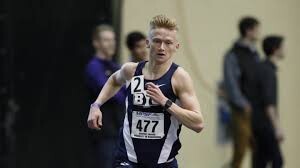
Linkletter has enjoyed plenty of success lately, and his most recent result was a second-place finish at the California International Marathon in a new personal best time of 2:12:52.
Flanagan was also on the hunt for the Canadian record this Sunday, and came agonizingly close, running just 10 seconds behind Schiebler’s time. The 27-year-old has also had a lot of success recently, winning the Canadian 10K championships in Toronto in October and taking the title in the Manchester Road Race in November. “I am looking forward to competing,” he told Canadian Running ahead of the race. “The plan is to run conservatively to tackle the Canadian record. It’s engraved in my head.”
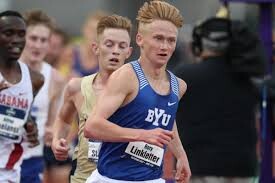
While he didn’t achieve his goal, Flanagan ran a very strong race and we will have plenty more opportunities to watch Flanagan on the roads. He will be running a few 5,000m and 10,000m races this spring to secure a spot on Team Canada at the 2022 World Championships in Eugene, Ore., but tells us that he will be stepping up to the marathon in hopes of qualifying for the Paris 2022 Olympics.
Ethiopia’s Milkesa Tolosa won the race in 1:00:24, followed by Kenya’s John Korir in second in 1:00:27 and Wilfred Kimitei of the U.K. in third in 1:00:44.
by Brittany Hambleton
Login to leave a comment
Aramco Houston Half Marathon
The Chevron Houston Marathon provides runners with a one-of-a-kind experience in the vibrant and dynamic setting of America's fourth-largest city. Renowned for its fast, flat, and scenic single-loop course, the race has earned accolades as the "fastest winter marathon" and the "second fastest marathon overall," according to the Ultimate Guide to Marathons. It’s a perfect opportunity for both elite athletes...
more...U.S. marathon record holder Scott Fauble announced as Rory Linkletter’s new coach
It has been a busy few weeks for Canada’s Rory Linkletter, as he ran a marathon personal best at the California International Marathon (2:12:52) and left the NAZ Elite track club. Now Linkletter is joining forces with American marathon record holder Ryan Hall as his coach.
In an interview with The Lap Count, Linkletter gave some insight on what’s next for Canada’s up-and-coming marathoner.
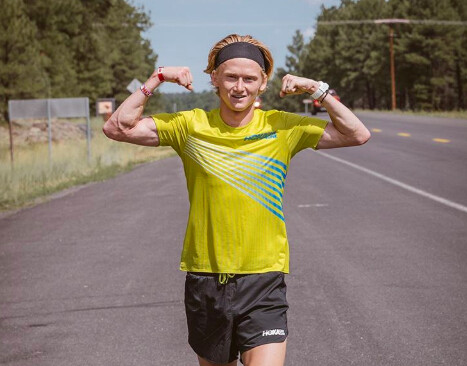
“I have fallen in love with Flagstaff, my wife and I bought a home earlier this year, so ideally I will stay here for the remainder of my career,” says Linkletter. “As for coaching, I’ve decided to work with Ryan Hall.”
This announcement comes days after his departure from HOKA and Ben Rosario’s NAZ Elite. Linkletter is now left unsponsored but believes that Hall’s philosophy will suit his talents and career goals. “I trust that if I perform how I know I can that won’t last forever,” says Linkletter.
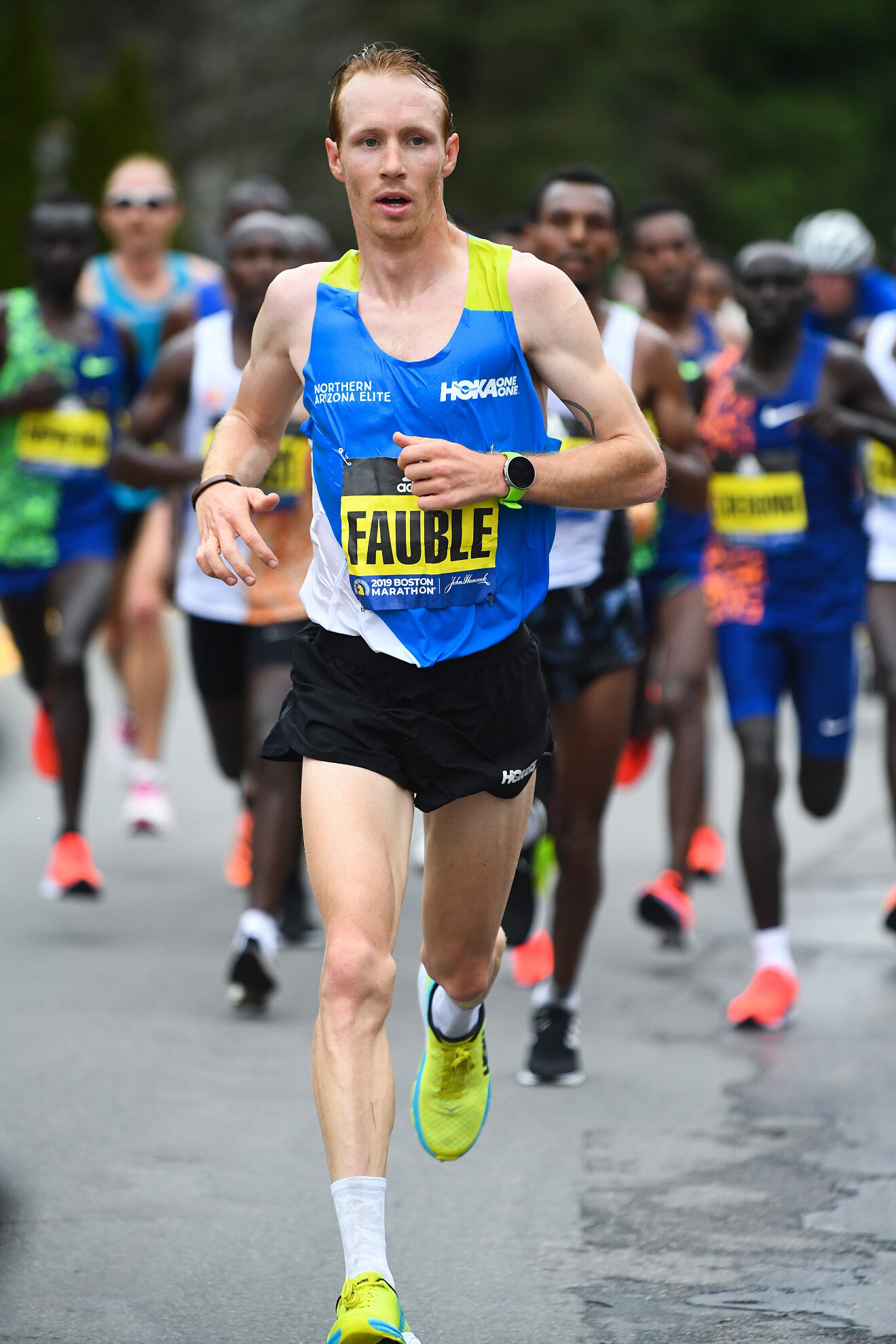
Hall currently coaches his wife Sara Hall, the second-fastest U.S. marathoner, clocking 2:20:32 at The Marathon Project in Chandler, Ariz. Ryan holds the fastest time ever by an American and is the only North-American man to run under 2:05 (Boston 2011). Although Ryan has retired from professional running, he remains as a coach for post-colligate athletes and marathoners in Flagstaff, Ariz.
Linkletter’s previous NAZ Elite teammate, Scott Fauble, also revealed that he will be remaining in Flagstaff. The top American at the 2019 Boston Marathon will be coached virtually by Joe Bosshard, who resides in Colorado and currently coaches Emma Coburn, Emma Bates and Cory McGee.
by Marley Dickinson
Login to leave a comment
Olympic Marathoner Ryan Hall Shared Things to Do the Night Before a Big Race
Ryan Hall made history as a runner, becoming the first American to break the hour barrier in the half-marathon. Since retiring from pro running in 2016, he has packed on the muscle and is now able to deadlift more than 500 pounds—while still holding onto his record as the fastest American runner of all time in the half and full marathon categories.
Hall's wife Sara, meanwhile, continues to kill it as an elite distance runner; she was the first American in over a decade to reach the podium at last year's London Marathon. Today, Sara is competing in a half-marathon race in Eugene, and in a post shared to Instagram last night, Hall broke down the seven most important things that they have both learned over the years about how to best prepare for a long-distance race.
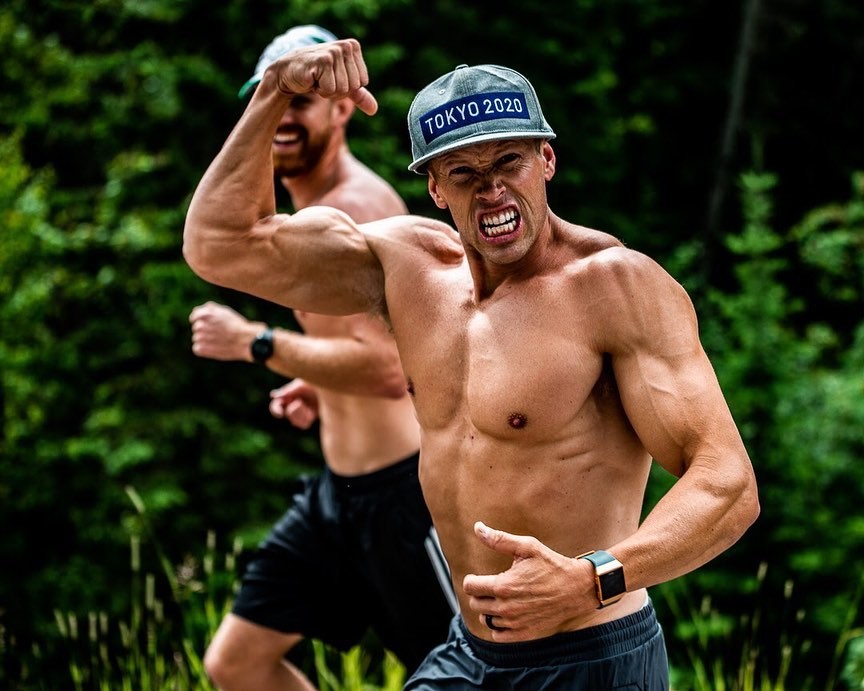
First off, Hall recommends lying down rather than sitting wherever possible. "Sitting creates all kinds of tightness and kinks that you want to avoid pre-race," he says
Secondly: eat up. A common pitfall is to not consume enough calories to keep you going when the time comes. "Don't be afraid to eat," he says. "Remember that you are fueling today for tomorrow’s race." He also advises to "keep your food simple," suggesting white meat and egg whites as good sources of protein and white rice and pasta as simple carb sources, as well as to keep your electrolytes up, "as they are needed not only for holding water/hydration but also for your muscles to neurologically fire."
Ryan Hall made history as a runner, becoming the first American to break the hour barrier in the half-marathon. Since retiring from pro running in 2016, he has packed on the muscle and is now able to deadlift more than 500 pounds—while still holding onto his record as the fastest American runner of all time in the half and full marathon categories.

Hall's wife Sara, meanwhile, continues to kill it as an elite distance runner; she was the first American in over a decade to reach the podium at last year's London Marathon. Today, Sara is competing in a half-marathon race in Eugene, and in a post shared to Instagram last night, Hall broke down the seven most important things that they have both learned over the years about how to best prepare for a long-distance race.
First off, Hall recommends lying down rather than sitting wherever possible. "Sitting creates all kinds of tightness and kinks that you want to avoid pre-race," he says
Secondly: eat up. A common pitfall is to not consume enough calories to keep you going when the time comes. "Don't be afraid to eat," he says. "Remember that you are fueling today for tomorrow’s race." He also advises to "keep your food simple," suggesting white meat and egg whites as good sources of protein and white rice and pasta as simple carb sources, as well as to keep your electrolytes up, "as they are needed not only for holding water/hydration but also for your muscles to neurologically fire."
He also urges you to stay away from hot tubs as they can "leave legs feeling jello-y", and says it's perfectly normal to not sleep very well the night before a big race.
Finally, he says, be sure to enjoy yourself. "Reminding myself of this reality takes the pressure off and reminds me to soak it all in and enjoy every part of the experience," he says. "I’ve found, when I am having the most fun is when I’m usually performing the best."
by Philip Ellis
Login to leave a comment
Sarah Hall ran the second fastest time for the marathon at the Marathon Project
Sara Hall won The Marathon Project in Chandler, Arizona, on Sunday, December 20, running 2:20:32—making her the second-fastest American marathoner of all time. She took almost 90 seconds off her previous PR of 2:22:01, which she ran only 11 weeks ago at the London Marathon.
For about the first 18 miles of the race Hall, 37, flirted with the pace of Deena Kastor’s American record— 2:19:36—which has stood since 2006. But Hall, who ran behind two male pacesetters, couldn’t quite maintain the pace through the later miles.
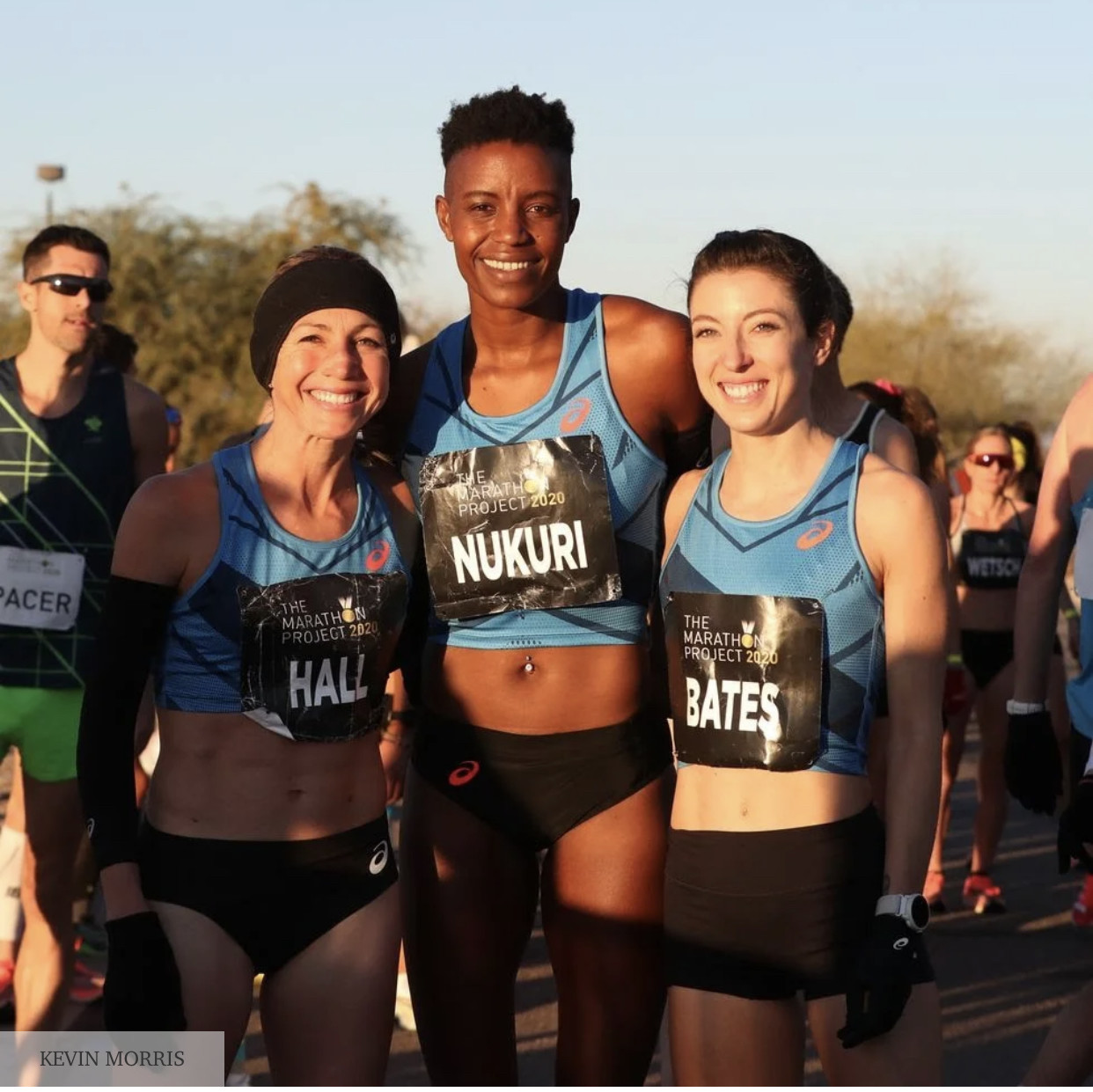
Keira D’Amato, the Virginia realtor who earlier this year ran an American record for the women’s-only 10 mile, finished second in 2:22:56, taking nearly 12 minutes off her previous marathon best.

Kellyn Taylor, 34, who went with Hall for the first half of the race, fell back in the second half and finished in 2:25:22.
The 37-year-old Hall ran a personal best 2:22.01 at London on Oct. 4 and was hoping on a short turnaround to better Deena Kastor's 14-year American record of 2:19.36, set at London in 2006. She came close with another significant PR drop, improving from sixth best in U.S. history to second ahead of Jordan Hasay's 2:20.57 at Chicago in 2017.
"London was so wonderful getting to place as high as I possibly could have," Hall said. "This was more of a time trial, and that's kind of tough when it feels like training sometimes. I really look forward to when we can get back to normal races with crowds, but I feel so grateful for the guys I was able to run with. They kept me honest in the second half when I was really struggling."
She said being No. 2 on the American marathon list is "kind of surreal. I've had so much disappointment in my career (including not finishing at the U.S. Olympic Trials in February) and I would have walked from this sport 10 years ago. But my husband just relentlessly believed in me and God encouraged me there was more there. I kind of (rediscovered) my love for it. Getting rid of the fear of failure really helped me enjoy it a lot more."
Two-time Olympian Ryan Hall, third fastest all-time among American men's marathoners, now coaches his wife, whose next goal is to make the U.S. Olympic track team for Tokyo in the 10,000-meter.
Sara Hall 2:20:32
Keira D'Amato 2:22:56
Kellyn Taylor 2:25:22
Emma Bates 2:25:40
Natasha Wodak 2:26:19
Login to leave a comment
Galen Rupp breezes to victory in a popup half marathon in Lane County
Galen Rupp Runs 60:22, Suguru Osako Runs 61:15 In Half Marathon
Galen Rupp cruised to victory in a special half marathon Friday near Row River in Lane County.

The former University of Oregon star and two-time Olympic medalist finished in 1 hour, 22 seconds, well in front of Japanese Olympian Suguru Osako, who crossed in 1:01:15.
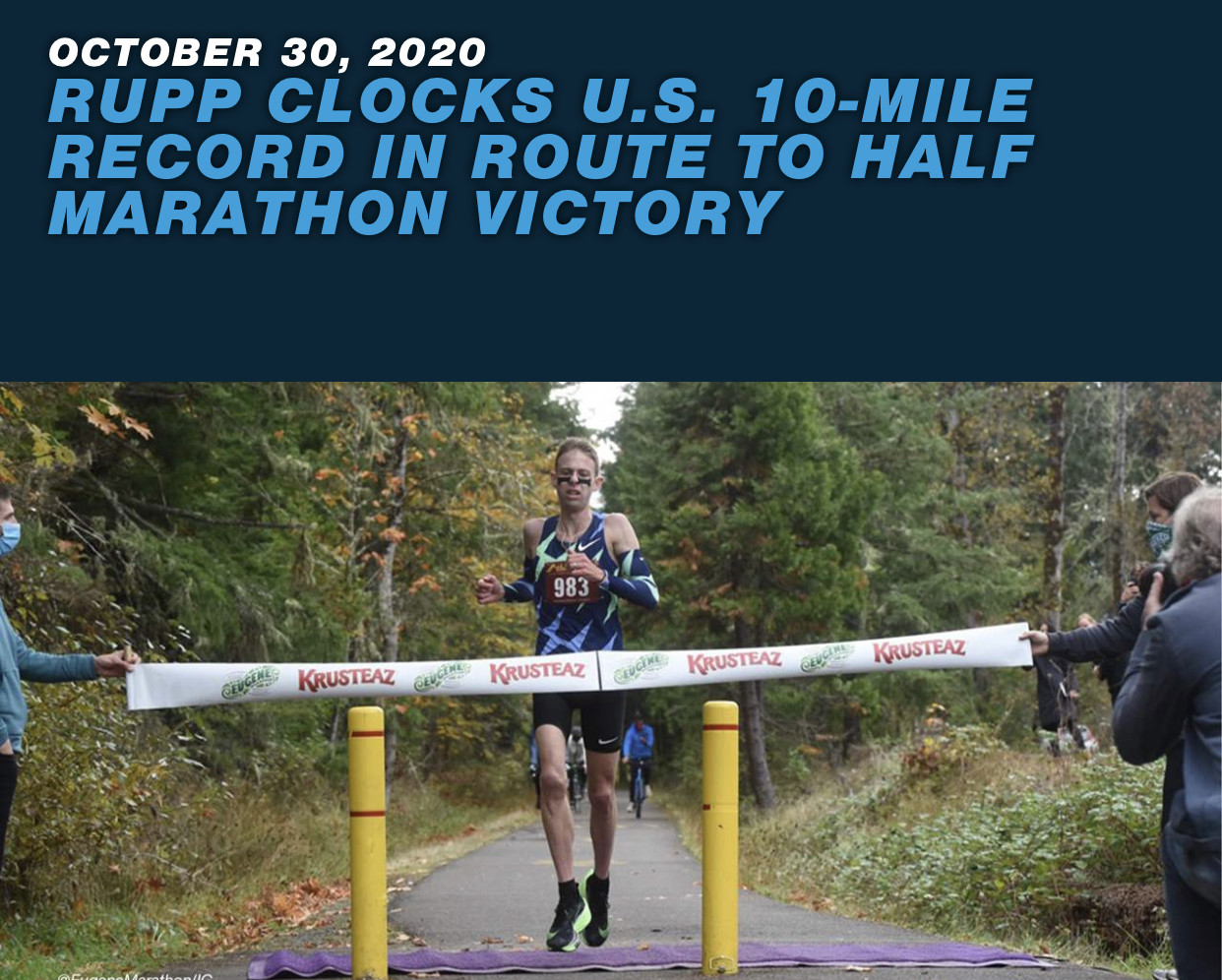
This was Rupp’s first competition since he won the U.S. Olympic Marathon Trials in Atlanta last February.
“It’s been a challenging year for everybody because of COVID,” Rupp said. “I’m so thankful and grateful to have this opportunity just to race. That was my whole mentality coming in here -- get a race in. If it happened that I ran really fast, great.”
The race was set up by the Eugene Marathon. The precise location and start time were kept secret to discourage spectators and stay within Oregon’s coronavirus protocols.
The lack of reliable internet service at the scene prevented the race from being live-streamed. Few details of the action were available while the runners were in the course.
Rupp’s winning time was well short of the U.S. record of 59:43, held by Ryan Hall since 2007. But Rupp’s 10-mile spit of 45:53 betters the U.S. 10-mile record of 46:13 held by Greg Meyer since 1983.
Ian Dobson of the Eugene Marathon said Rupp’s 10-mile time met all record criteria.
“Any time you set a record, it’s a great day,” Rupp said. "I think this technically is my PR (personal record) for a half marathon too. I ran a little quicker in Rome a few years ago, but that wasn’t a record-eligible course.
“Technically I came out with a PR. So, it was a great day. Any time you can do that, you can’t leave disappointed. I would have loved to go faster. It just wasn’t in the cards today.”
Login to leave a comment
Galen Rupp and Suguru Osako are aiming for a fast half marathon on Friday near Eugene
Olympians Galen Rupp and Suguru Osako have signed on for what is expected to be a blazingly fast half marathon Friday at an undisclosed location in Lane County.
Eugene Marathon has set up the course and ensured it is certified. Organizers are declining to reveal the course’s location or time in deference to the coronavirus pandemic. All participants have been tested for the virus.
Rupp won the men’s race at 2020 U.S. Olympic Marathon Trials last February in Atlanta. The former University of Oregon star is the 2012 Olympic silver medalist in the 10,000 meters and the 2016 Olympic bronze medalist in the marathon. He holds the U.S. record for the 10,000.
Osako is the Japanese record-holder in the marathon, as well as the 3,000 and 5,000 meters.
The two runners are former teammates with the now defunct Nike Oregon Project. Both are based in Portland, although Osako has been training in Flagstaff, Arizona.
“Galen called me maybe a month ago,” said Pete Julian, Osako’s coach. "He asked if Suguru would be interested in throwing down somewhere in Oregon in this time frame.
“I was like, ‘Galen, you called at the perfect time. That’s exactly what we want to do.'”
Rupp has not raced since winning in Atlanta. Osako was active with Julian’s group in track races over the summer. He had begun training for December’s Honolulu Marathon before that was canceled because of the coronavirus pandemic.
“I think they’re pretty lined up,” Julian said of the two runners. “Galen hasn’t raced in a long time. But he is old enough and wise enough now that if he says wants to run a good, hard, fast half marathon, you have to believe he is ready to go. I know Suguru is ready to go. It will be cool.”
The course is said to be flat. And if the race is fast, well, the U.S. record for a half marathon of 59 minutes, 43 seconds has been held by Ryan Hall since 2007. The Japanese half-marathon record is of 1:00.00 was set earlier this year by Yusuke Ogura.
Julian wouldn’t call Friday’s race a record attempt.
“Hey, man, 13.1 miles is a long way to go,” Julian said. “It’s almost foolish to say we’re targeting something because I know nothing about the course. My assumption is if the weather is nice, it’s warm enough and it’s not windy, and you have two guys like that, running around an hour for a half marathon is certainly within their capabilities.”
Eugene Marathon will be posting more details on its Twitter and Instagram accounts as the race nears. On Friday, organizers will use those platforms to provide updates on the progress of the competition.
by Ken Goe
Login to leave a comment
SARA HALL REFLECTS ON HARD WORK AND MOTHERHOOD IN BUILD UP TO LONDON MARATHON
Running At Peak Form Into Her Late 30s, Hall Continues Lifelong Pattern Of Putting In The Effort
When the future of racing in 2020 looked bleak as the COVID-19 crisis swept the world last spring, Sara Hall didn’t lose hope.
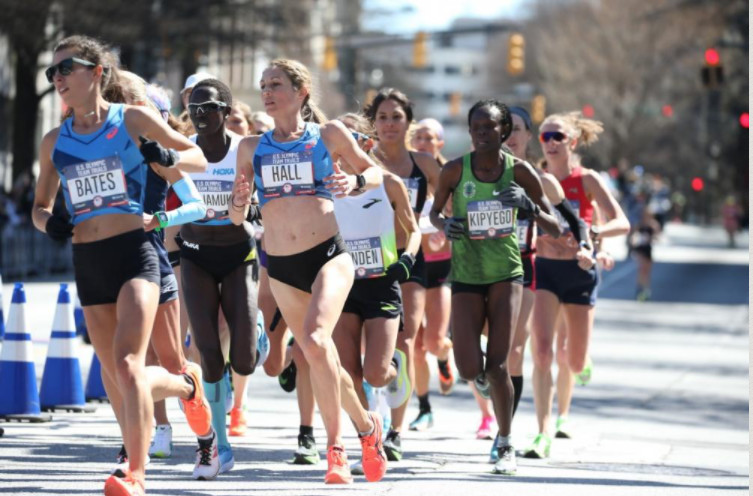
“I started training for a marathon in faith, before I knew there would be any real competitions,” said Hall, who has been eager to finally move past her heartbreaking performance from February at the U.S. Olympic Marathon Trials, where she dropped out at mile 22.
“It would have been easier just to hit the couch, but I set my mind on running a marathon, some way some how.”
Even if it meant racing 26.2 miles by herself, she said.
Ryan Hall, a two-time U.S. Olympic marathoner who retired in 2016, said his wife’s relentless competitive drive is one of his biggest challenges as her coach.
“She loves to train hard, but has a hard time taking extended breaks,” he said. “She is always ‘chomping at the bit’ to get back out there.”
When Hall heard that the London Marathon would host a highly secure, elite-only race amid the pandemic, she jumped at the precious opportunity.
On Oct. 4, she will face some of the world’s best marathoners, including defending London champion and world record holder Brigid Kosgei of Kenya and U.S. Olympic Marathon Trials champion Molly Seidel.
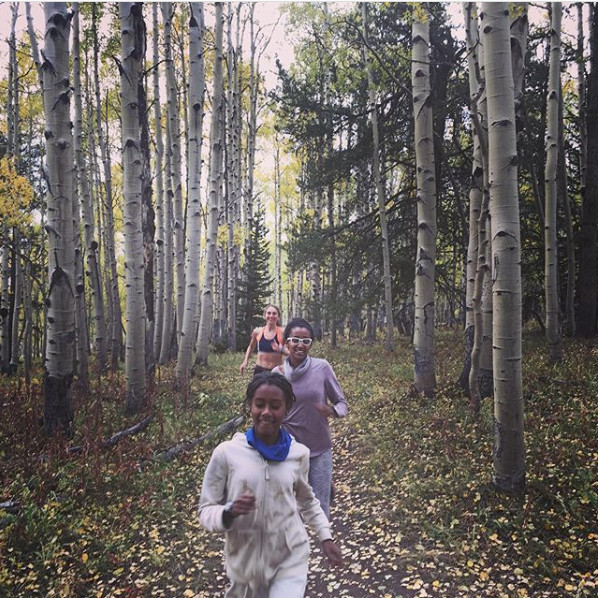
“Getting into the London Marathon felt like such a reward for a lot of perseverance this year — being willing to put in the work on faith alone,” said Hall, 37. “It felt against all odds to get to toe the line in a world marathon major.”
‘Against all odds’ is a familiar theme for Hall, a mother of four who has posted the fastest times of her career well into her 30s, including a 2:22 marathon last year in Berlin, where she finished fifth. Last month, with two male pacers, she ran a personal best of 1:08:18 in a half marathon along the Row River Trail in south of Eugene, Oregon, making her the sixth-fastest American woman ever in that distance.
A former Foot Locker Cross Country National Champion in high school and distance standout at Stanford University, Hall has competed at the highest levels of distance running for two decades — a great accomplishment in itself.
“It’s definitely surprised me,” she said of her longevity in the sport. “I think it’s a lot of factors, but I think the biggest are being naturally durable and learning to be really mentally-emotionally resilient.”
Ten years ago, after disappointing results as a 1,500-meter and 5,000-meter runner on the track, Hall thought her elite running career was over. She credits her Christian faith and Ryan with convincing her she had more to achieve.
Since then, she’s not only moved up to and mastered the marathon distance, she’s done it while becoming a mother to four adopted sisters from Ethiopia.
“When we adopted them, I didn’t think I’d be able to keep competing, but instead I’ve improved every year since they’ve been here,” said Hall, who is using her race in London to raise money for homeless children in Ethiopia, where she and Ryan have spent a lot of time working on various causes.
“I get to model to (my daughters) so many character aspects I want to instill in them: picking yourself up after defeat, taking risks, hard work, commitment,” she said. “Running is the greatest teacher.”
Inspired by their parents, three of the Halls' daughters have become runners. The oldest, Hana, currently a freshman runner at Grand Canyon University, won the Division 2 Arizona Cross Country Championships last fall. Hana and Mia, 16, both ran with their mom at the half marathon in Oregon.
In addition managing her kids’ remote learning and getting in her workouts, Hall has made time to discuss the racial justice movements happening across the United States.
“I’ve told my daughters about George Floyd, Ahmaud Arbery and Breonna Taylor,” she said. “We’ve discussed the movement in the U.S. and the systemic racism over the last 400 years that is the backstory to these recent events. I personally have been learning a lot.”
Despite the world’s turmoil in recent months, Hall has maintained extraordinary focus on the road ahead.
In the London Marathon, which will be held on a closed-loop course around St. James Park, she hopes to snag a new personal best and would love to finally land on the podium, after finishing fifth at the Frankfurt and Berlin Marathons.
“I’m focused on having my best marathon yet,” she said.
Login to leave a comment
TCS London Marathon
The London Marathon was first run on March 29, 1981 and has been held in the spring of every year since 2010. It is sponsored by Virgin Money and was founded by the former Olympic champion and journalist Chris Brasher and Welsh athlete John Disley. It is organized by Hugh Brasher (son of Chris) as Race Director and Nick Bitel...
more...Ryan Hall completes 69K ultramarathon, calls it ‘the hardest thing I’ve ever done’
Despite running just five times in 2020, the former U.S. Olympian made it through his first ultramarathon
Since retiring from professional running in 2016, American half-marathon record-holder Ryan Hall has not raced too much, and in 2020, he has only gone for a total of five training runs.
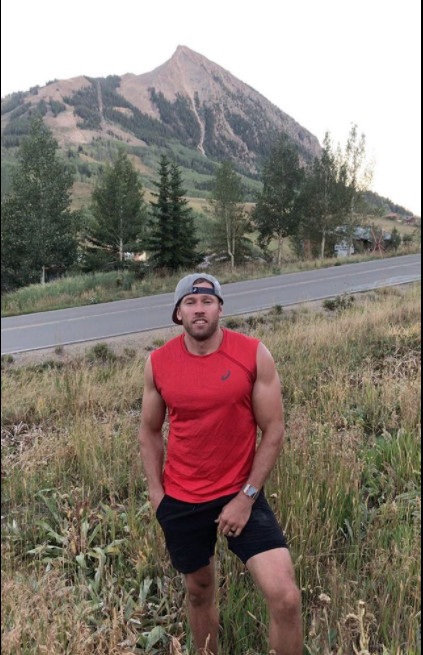
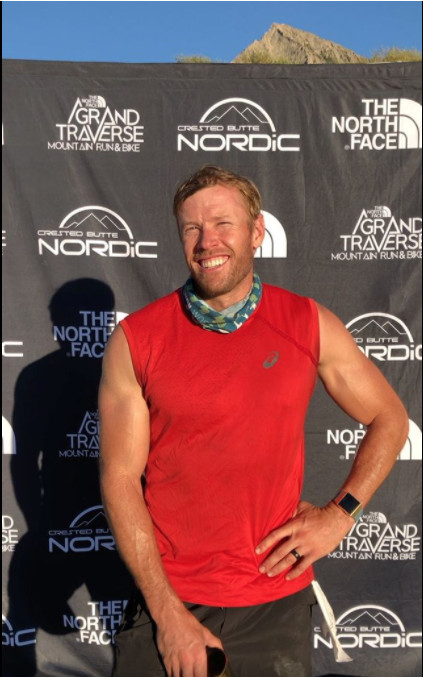
Despite this extremely low mileage for the year, he ran his first ultramarathon, completing the 69K Grand Traverse Mountain Run in Crested Butte, Colo., in 12:47:46.
In an interview after the race, Hall told the Grand Traverse team that he had hoped for “an epic adventure” that was “super hard,” and he said the event “exceeded super hard — it was super, super, super hard.”
The Grand Traverse
Local athlete Cam Smith of Crested Butte won the 69K race in an extremely tight finish, crossing the line just two seconds faster than second-place finisher Nick Coury. Smith won the race in 7:03:04. Hall was almost six hours back of the top finishers, but as he said before the race, he wasn’t running to compete for the win, he was just looking to finish.
“It was not pretty, it was not fast, but I got to the finish line,” he said in an Instagram video after the race. “I got the job done.” In his post-race interview, he said he has “never been more excited to reach a finish line.”
While he of course knew it would be a tough race, especially with no training, he said he still underestimated the challenge.
“It’s a really unique kind of pain,” he said, adding later on in his own video that the race was the hardest thing he has ever done.
No training
Hall works out a lot (he has been heavily invested in powerlifting since retiring from running), but deadlifts and benchpress reps won’t prepare you for any running race, let alone an ultramarathon. This isn’t his first time taking on a running challenge with little training under his belt.
In 2017, he ran the World Marathon Challenge (WMC) — an event in which he ran seven marathons in seven days on all seven continents — on next to no training. He finished in fifth place at that race, but he had no illusions that he could register a top result in Colorado over the weekend. He noted that the no-training approach likely isn’t a good idea for ultramarathons, saying, “I usually don’t recommend these kinds of races off five days of training a year.
Do as I say, not as I do.”
by Running Magazine
Login to leave a comment
Ryan Hall plans to run his first ultramarathon in Colorado
Ryan Hall retired from professional running in 2016, and since then, even though he has participated in a few races, his focus has been on powerlifting. On Saturday, Hall, the U.S. half-marathon record-holder, announced that he is getting back into racing, but instead of his once-preferred distances of 21K or 42K, he will be running a 69K race — his first crack at an ultramarathon.
To add to this already-daunting challenge, he will be racing after running just five times in 2020. The event, the Grand Traverse Mountain Run, is set to be held on September 5 in Crested Butte, Colo.
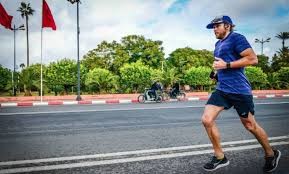
In an Instagram video announcing his race plans, Hall said the Grand Traverse will be an “epic challenge,” adding that he likes to “make it even more epic by not training.” He cited his running of the World Marathon Challenge (WMC) in 2017, an event for which he apparently trained very little. The WMC is a week-long event that sees participants run seven marathons in seven days on all seven continents. Despite his minimal training for that challenge, Hall finished in fifth place.

Although he was already heavily invested in weightlifting in 2017, Hall had only been retired from professional running for a year. Now more than four years removed from the lifestyle of an elite runner, Hall may have a tougher time getting through such an arduous challenge.
He noted that he has incorporated other cardio exercises into his training, like boxing, but after averaging less than one run per month all year, he acknowledged that this won’t be an easy undertaking. “I’m going to be in way over my head on this one,” he said, “but that’s where I like to be as an athlete.”
Hall said he is “so stoked for this challenge,” which features more than 2,700m of elevation gain, and he asked any of his ultrarunner followers to leave him tips for the race.
by Ben Snider-McGrath
Login to leave a comment
Sara Hall Runs Impressive Half Marathon PR—Without the Hoopla
Her 1:08:18 puts her sixth on the list of U.S. performers.
In the Oregon woods, on a bike trail along the shore of Dorena Lake, 30 miles south of Eugene, elite athlete Sara Hall ran her first race in more than five months on the roads—just her, two male pacers, and two of her four daughters, Hana and Mia, following at a distance.
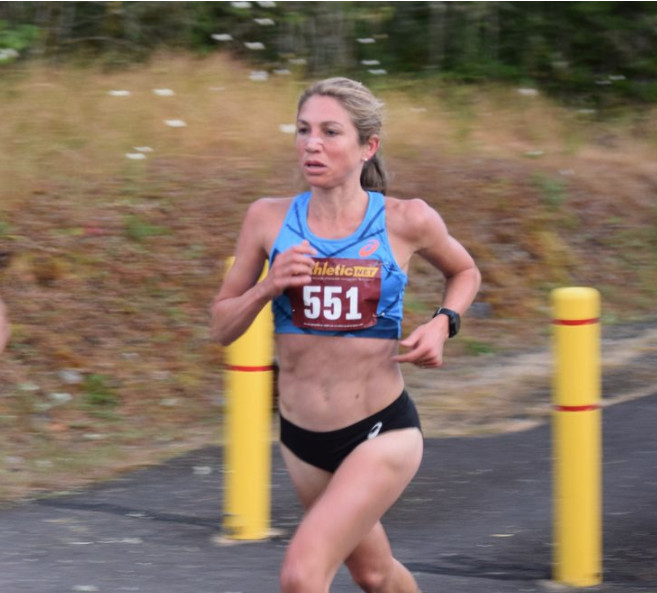

Hall, 37, finished the half marathon in 1:08:18, a personal record by 40 seconds and good for sixth-fastest American of all time. She averaged 5:12 pace.
It felt like a mirage. The race, called the Row River Half Marathon and staged by the organizers of the Eugene Marathon, began at 5:52 a.m., just as the sun was beginning to rise over the hills and the overnight fog was disappearing. The small pack of runners disappeared east along the bike path to a turnaround point, came back a little more than an hour later, and quickly left the area—an effort to avoid the heat of the day and to discourage any spectators in the COVID era.
It was a far cry from Hall’s last race, the Olympic Marathon Trials on February 29 in Atlanta, where close to 700 men and women started the event and 200,000 screaming fans crammed the streets with signs and cowbells. Hall, a 2:22 marathoner who thought she was in the best shape of her life and in a good position to make her first Olympic team, dropped out after the 22-mile mark.
Typically a frequent racer, Hall has had to live with the disappointment from the Trials for five months, with no opportunities to redeem herself after the pandemic shut down all races of note. Pro runners like her have been scrambling to find opportunities to test their fitness outside of their own training while keeping within guidelines for safe events during the pandemic.
“It felt surprisingly really good, yeah,” Hall said immediately after finishing. “I wasn’t sure how I’d feel out here. I’ve been pretty buried in training because there’s no races to freshen up for. So I just am, like, grinding for forever. And I was like hopefully my legs come around. To run a big PR like that without really a race atmosphere is really encouraging.”
Hall, who lives and trains at altitude in Flagstaff, Arizona, says she’s more of a competitor than a time trialer. Without the adrenaline of a pack, she wasn’t sure if she’s be able to access all her energy. But she was.
“I tried to just keep telling myself the mantras that keep me going in training,” she said. “But it’s a little harder. When I ran my last half, it was in Houston in a pack of African runners, and I was just getting gritty and mixing it up with them. It’s definitely a different mode out here. But I’m super thankful to the guys that were helping me out through the race. That helped a lot.”
Hall was paced by Eric Finan of Eugene and Jared Carson of Portland, both of whom were also entered into the Trials.
Race director Ian Dobson, a U.S. Olympian in 2008 and friend of Ryan Hall and Sara Hall since their days at Stanford University, floated the idea of putting on a socially distant race to them a couple of months ago. All participants and staff had current negative COVID tests and provided information for contact tracing, should it be necessary. Everyone but the runners wore masks.
It was an opportunity for Hall to get a tuneup race in—she has a marathon coming up in the fall—and a chance for the events team of the Eugene Marathon to host a race, after their flagship event was canceled in April.
“We wanted to take this unique opportunity to have someone like Sara be part of the event,” Dobson said. “And we want to be part of the storytelling—what does success for the running community look like during the Coranvirus?”
He said he hopes that big races make a speedy return instead of morphing into one-off boutique events with five or fewer participants. “The mass participation road race is such a cool thing,” he said. “That’s the business we’re in; it’s what we want to do. That said, given the current reality, this is what we can do.”
The Row River course was USATF-certified and the race is in the process of being sanctioned by USATF, which would make Hall’s time eligible to appear on record lists. She and her family are staying in Eugene for another week or so for more sea level training, as she prepares for the next marathon.
“I feel over-the-moon excited,” she said of the upcoming race. “I think I’m going to be the happiest person on that starting line. I’ve put in so much training just on faith that there would be opportunities. And even though everything was just canceled canceled canceled, to be able to have an actual race—I just wanted to cry when I got in. The trials was a massive disappointment, and I really want to be able to turn the page on that and continue to build and improve.”
Although Hall can’t yet say what race that is, observers believe it is the London Marathon, which yesterday announced it will host an elite-only version of its race around a loop in St. James Park.
Hall’s daughter Hana, 20, finished the Row River Half in 1:20:03. Her daughter Mia, 16, who has only been running for a year, finished in 1:23:18.
by Runner’s World
Login to leave a comment
Dathan Ritzenhein Retires at Age 37
Dathan Ritzenhein, a high school prodigy who went on to become a two-time global medalist, three-time Olympian, five-time national champion and a 2:07 marathoner, has decided to retire after 16 years of professional running.
The 37 year-old, who grew up in Rockford, Mich., and competed for the University of Colorado during his collegiate career, decided that he had accomplished all of his main goals and the time was right to shift his focus away from competitive running.
“I guess I’m not necessarily 25 and retiring in my prime,” Ritzenhein told Race Results Weekly by telephone from his Michigan home yesterday just after finishing a hard 10-mile run. He continued: “I have things that I wish that I have done in my career, but I’m also very satisfied, too. I think right now it’s something that I thought a lot about the last year.

I’ve had a lot of nostalgic moments, looking back a lot more than looking forward. So, I don’t know that I had a lot more goals that I was looking to accomplish.”
While still competing for Colorado, Ritzenhein made his first of three Olympic teams in 2004, despite finishing only 22nd at the USA Olympic Trials in the 10,000m. Ritzenhein made the team because he was one of only five athletes entered who had the Olympic “A” standard of 27:49.00 (he had run 27:38.50 in his debut at the distance in April, then a U.S. collegiate record). Trials winner Meb Keflezighi opted for the marathon (where he would win the silver medal) and Bob Kennedy dropped out. That left Abdi Abdirahman, Dan Browne (who would also compete in the Marathon) and Ritzenhein to run the 10,000m in Athens, the three remaining finishers who had the standard. Running on a badly injured foot in Athens, Ritzenhein failed to finish.
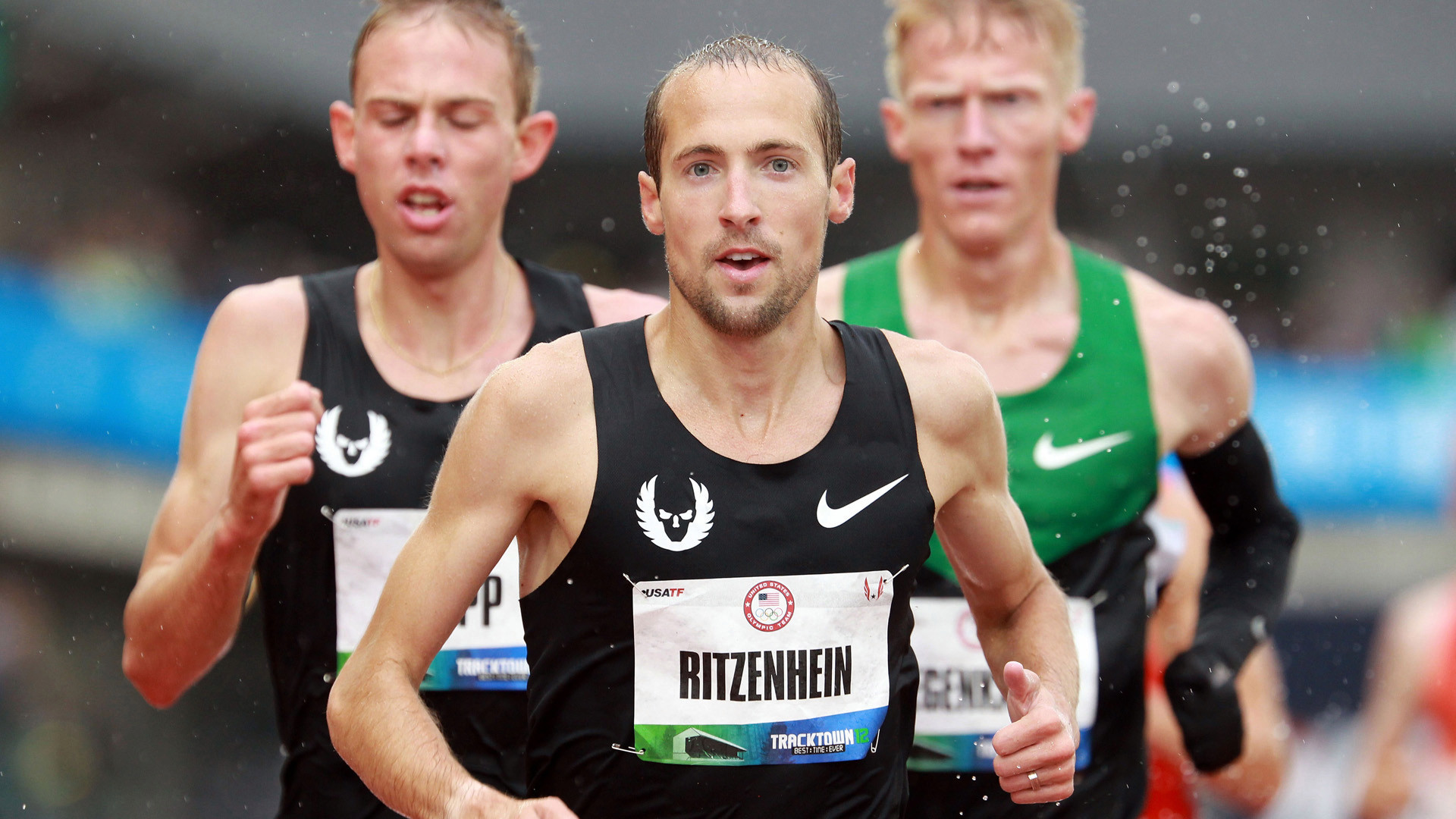
“My first one was a miserable experience where I hobbled my way on,” Ritzenhein said of making his first Olympic team. He continued: “I made the standard, and just not many people had it. Bob Kennedy had it and Meb, and Dan Browne and Abdi. Meb ended up running the marathon and Bob Kennedy dropped out of the 10-K, and I knew I just had to finish the race.”
Ritzenhein made his professional racing debut at the Boclassic 10-K in Bolzano, Italy, on December 31, 2004, the day after his 22nd birthday. He pushed the pace with two laps to go in the 8-lap race and finished third behind Sergey Lebed of Ukraine and Stefano Baldini of Italy (Baldini was the reigning Olympic Marathon champion). Ritzenhein had signed with Nike just prior to the Athens Olympics, and Brad Hudson became his coach. He won both the USATF cross country and 10-K road running titles in 2005, and under Hudson’s coaching jumped right to the marathon in 2006, making his debut at the New York City Marathon. It was a controversial decision, and after a 1:05:35 first half he finished 11th in 2:14:01, calling the discomfort he endured in the last four miles “undescribable.”
Almost exactly a year later, Ritzenhein returned to New York for the 2008 USA Olympic Trials Marathon (which were held in November, 2007), and he finished second to Ryan Hall in 2:11:07, a personal best. He would go on to finish ninth in the Olympic Marathon the following year in Beijing, and it looked like Ritzenhein was going to focus mainly on the marathon.
But unlike other track runners who moved up, Ritzenhein wasn’t so quick to abandon the track, cross country or road races below the marathon distance. He used his marathon strength to great effect in training, and his track running was never better. In one of his best years, 2009, he set the American record for 5000m of 12:56.27 (since broken), ran a 10,000m personal best of 27:22.28 when he finished sixth at the IAAF World Championships 10,000m, and won a bronze medal at the IAAF World Half-Marathon Championships, running 1:00:00. He was also the runner-up at the USATF championships for both the 10,000m and half-marathon, and finished 10th at the London Marathon.
“That’s what always drove me,” said Ritzenhein. “I would always have these goals and you’d have these valleys between them. Really high moments, like the American record, bronze medal at the world junior championships (in cross country), or the world half-marathon championships. Those are the races where you just feel invincible.”
But he was not invincible. Ritzenhein suffered numerous injuries throughout his career (he recalled having over 40 MRI’s), and had to have surgeries three times. He missed most of 2011 due to a surgery to his right Achilles tendon, but his long recovery (made even longer by a lingering infection) set him up for his most dramatic year, 2012.
“After three years away from the track I had doubts,” Ritzenhein said. “I poured it all out there. At the Olympic Trials it was an epic day. I didn’t have the standard and quite a few people in the race did.” He added: “It seemed like an impossible task.”
Ritzenhein said that he will always be a runner, and that he’ll still run hard sometimes (he averaged a six-minute pace on yesterday’s 10-miler, he said). He already coaches a few athletes, including marathoner Parker Stinson.
“This isn’t the end for sure,” he said. “This is all I know. The sport of running is my passion and my love.” He added: “I’m looking forward to continuing to give back to the sport; coaching is a passion of mine. I love writing, to talk to people, and give people advice. It’s in my DNA. I’ll always run. It’s just something I can’t go without.”
by David Monti
Login to leave a comment
Remembering Boston 2014, when Meb Keflezighi ran all the way to one of the defining victories in the race’s 123-year history, becoming the first U.S. male runner to win in 31 years
Before starting the 2014 Boston Marathon, Meb Keflezighi had four names scribbled in marker on his race bib corners: Martin, Krystle, Lingzi and Sean.
Martin Richard, Krystle Campbell and Lingzi Lu died as a result of the twin bombings near the Boylston Street finish line during the 2013 Boston Marathon. Three days later, Sean Collier, a policeman, was shot and killed in a confrontation with the attackers.
Keflezighi ran in 2014 in their memory and with his own remembrance. All the way to one of the defining victories in the race’s 123-year history, becoming the first U.S. male runner to win in 31 years.
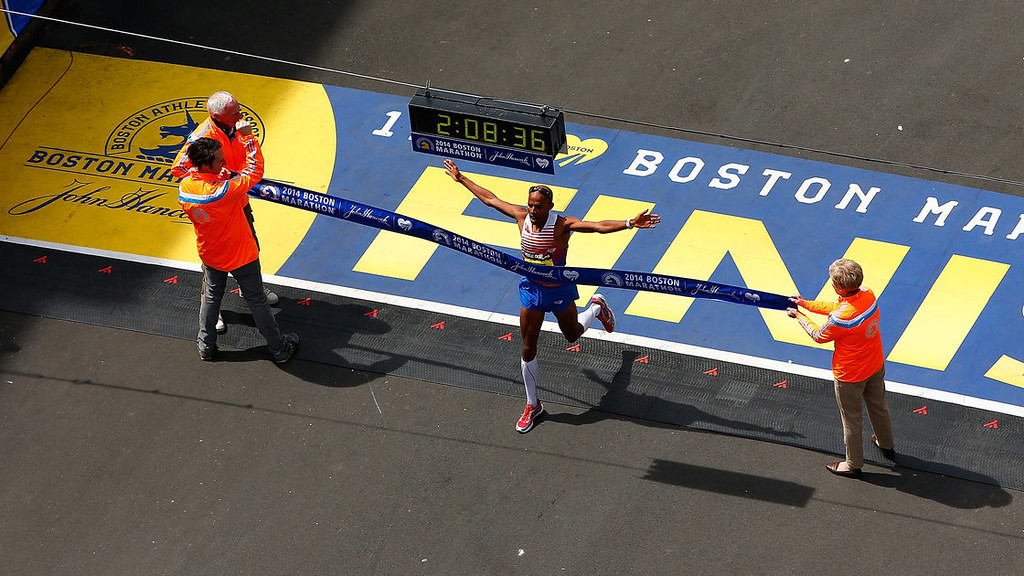
A year earlier, Keflezighi left an observer grandstand near the finish line of the Boston Marathon about five minutes before the bombs went off.
“The four victims that died in the explosion were spectators just like me,” he said.
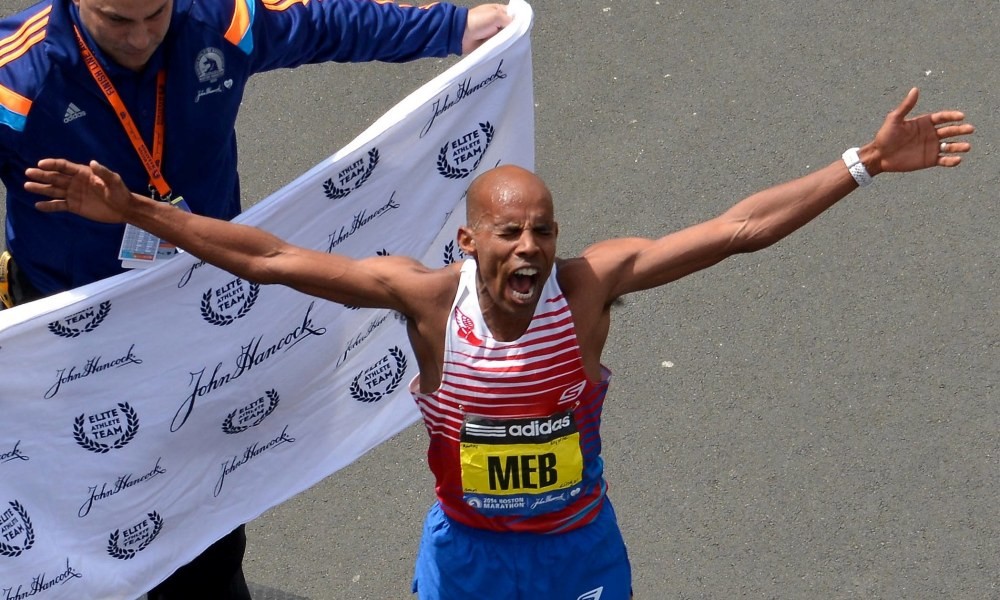
It marked a career turnaround at age 38 for Keflezighi, who had been dropped by Nike three years earlier. He considered retirement. The 2004 Olympic silver medalist and 2009 New York City Marathon champion had placed 23rd at his previous marathon and withdrew before the 2013 Boston race with a calf injury.
Keflezighi went out hard from the start, keen on meeting his minimum pre-race goal: to set a personal best. At the halfway point, he and little-known American Josphat Boit led the field by 30 seconds.
In the chase pack, other Americans conversed and strategized not to push the pace in pursuit.
“We needed to give Meb as much space as possible,” Ryan Hall, the fastest American marathoner in history, texted Tim Layden, then of Sports Illustrated and now of NBC Sports. “If the African guys were going to try to catch him, we weren’t going to do the work to help them. It wasn’t my day to win, as much as I wanted to. Meb winning was the next best thing and what the US needed.”
Keflezighi pulled away from Boit between the 15th and 19th miles, opening a one-minute lead. The margin dropped to about eight seconds at the 25-mile mark, but Keflezighi held off Kenyan Wilson Chebet by 11 seconds on Boylston.
“This is beyond running,” Keflezighi, whose full first name, Mebrahtom, means “let there be light” in the Eritrean language, said in a finish-area TV interview. “This is for the people, for the Boston Strong. We’re resilient as runners.”
Keflezighi, born in Eritrea, moved to the U.S. at age 12. His first time running seriously was in San Diego in junior high school, when PE students were given a grade for how much effort they put into a mile. He eventually earned a scholarship to UCLA and made his first Olympic team at age 25 in 2000.
Keflezighi retired from elite running in 2017 after 26 marathons, but he felt complete after Boston in 2014.
“99.9 of my career was fulfilled,” Keflezighi said after winning Boston. “Today, 110 percent.”
by Meb Keflezighi
Login to leave a comment
Boston Marathon
Among the nation’s oldest athletic clubs, the B.A.A. was established in 1887, and, in 1896, more than half of the U.S. Olympic Team at the first modern games was composed of B.A.A. club members. The Olympic Games provided the inspiration for the first Boston Marathon, which culminated the B.A.A. Games on April 19, 1897. John J. McDermott emerged from a...
more...Jemal Yimer, Jared Ward, Sara Hall, Molly huddle and more on Tap at 2020 Houston Half Marathon
Year-in, year-out, no American half marathon assembles better fields than Houston. In addition to being the site of both the men’s (Ryan Hall, 2007) and women’s (Molly Huddle, 2018) American records, there is always a deep list of sub-60:00 men and sub-67:00 women on the start line. Last year, Brigid Kosgei kicked off one of the greatest years in the history of distance running with a win in Houston.
The international fields in Houston, which takes place on Sunday, are strong once again. But from an American perspective, the more intriguing storyline is the impending US Olympic Marathon Trials, to be held in six weeks’ time in Atlanta. Several top Trials contenders — Molly Huddle and Sara Hall on the women’s side, Jared Ward and Shadrack Biwott on the men’s — will be racing on Sunday, and while no result will make or break their Trials hopes, it does give us one last piece of evidence to go on.
When Huddle debuted in the marathon, placing third in New York in 2016, it looked to be the first step in a journey that would culminate at the 2020 Olympic marathon. Among Americans, Huddle was the queen of all distances between 5k and the half marathon and her grind-it-out style seemed well-suited to marathon success.
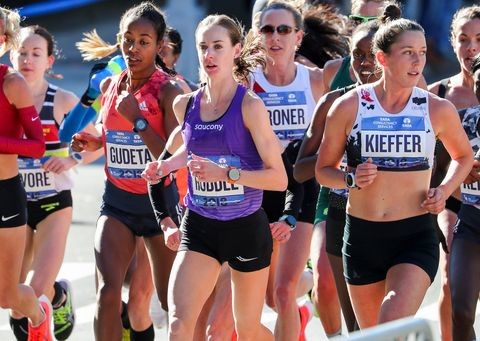
Tuliamuk, the 2018 US half marathon champ, is an option, though she’s got progressively slower in Houston the last three years, from 69:58 in 2017 to 71:41 in 2018 to 72:03 last year. She’ll need to get back to her 2017 form to crack the top two Americans on Sunday.
Katy Jermann (née Moen) and Molly Seidel both ran 70:27 last year, tied for third-fastest in the US. Of the two, Seidel, who in 2015 broke the “Foot Locker curse” to win the the 2015 NCAA XC title, is the more intriguing prospect. Seidel had never run a half before October 2019, but Houston will be her third in three months, and she plans to make her marathon debut at the Trials.
With a 2:09 in Boston and two sixth-place finishes in New York, Jared Ward has been the most consistent American marathoner over the last 18 months. Beating him on Sunday doesn’t guarantee a repeat result next month in Atlanta, but it would be a positive sign for the other Olympic hopefuls in this field.

With a high of 59, the temperature looks great for running on Sunday, though 13 mph winds mean the conditions won’t be perfect. Still, with the talent on hand in Houston, there should be competitive races up front. In the men’s race, there’s no clear favorite.
Ethiopia’s Jemal Yimer (58:33), the fourth-fastest man ever, was a close second last year after taking a wrong turn late in the race. He went on to run 59:09 in Valencia in October, where he finished two seconds behind Kenya’s Bernard Ngeno, also entered in Houston. Andamlak Belihu had a terrific 2019 (26:53/59:10, 5th at Worlds in 10k), while the last two Houston champs, Shura Kitata of Ethiopia and Jake Robertson of New Zealand, return as well.
Login to leave a comment
Aramco Houston Half Marathon
The Chevron Houston Marathon provides runners with a one-of-a-kind experience in the vibrant and dynamic setting of America's fourth-largest city. Renowned for its fast, flat, and scenic single-loop course, the race has earned accolades as the "fastest winter marathon" and the "second fastest marathon overall," according to the Ultimate Guide to Marathons. It’s a perfect opportunity for both elite athletes...
more...Sara Hall of Flagstaff finished fifth Sunday at the Berlin Marathon, first among American women
Sara Hall, 36, ran a personal best 2 hours, 22 minutes, 16 seconds, sixth fastest in U.S. marathon history. Her previous PR was 2:26.20 at the 2018 Ottawa Marathon.
The women’s race was won by Ashete Bekere in 2:20:14, pulling away at the end from fellow-Ethiopian Mare Dibaba, 2:20:21, with Kenya’s Sally Chepyego taking third overall in 2:21:06.
Hall’s time takes four minutes from her previous best time of 2:26:20 and moves her up to sixth in the U.S. all-time rankings.
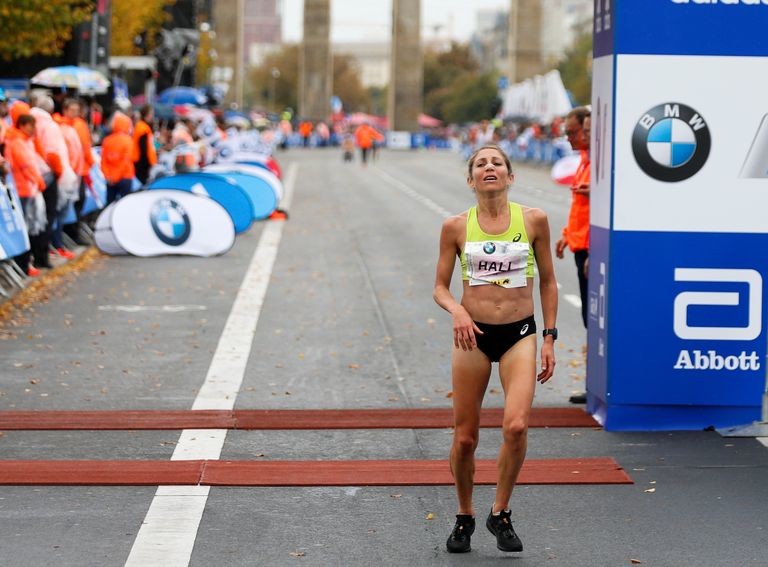
“I’m very happy. It’s the first time I’ve run a marathon with negative splits,” Hall told Runner’s World. “When I began to catch other women after halfway, I had fun and ran some 5:15 miles. It got tough near the end, with strong wind and running alone, but I finished strong. Ryan and I knew I was ready for an improvement, and it’s good to do it well.”
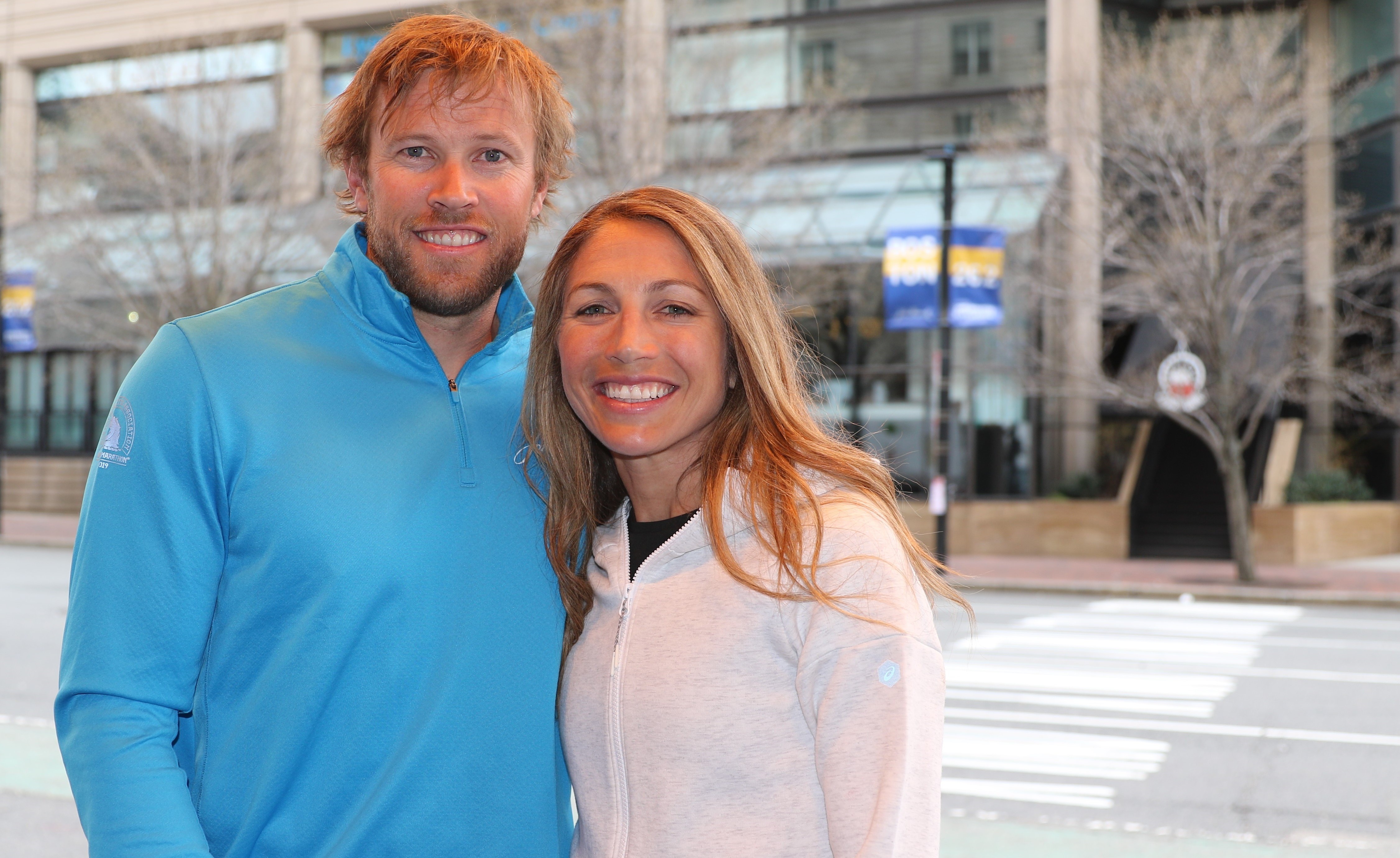
Hall is among several women with Arizona ties who are U.S. contenders for the 2020 Tokyo Olympics. Others include Amy Cragg, Emily Sisson, Kellyn Taylor, Desiree Linden, Allie Kieffer and Stephanie Bruce.
Hall also gave a lot of credit to her husband and coach, Ryan Hall, who is the American record holder in the half marathon. She said it was her best period of training ever, with not one day off for injury or illness since racing Boston in April.
“We knew from her training times that she was ready to move to a new level. It was a matter of getting it right in the race today,” Ryan Hall added.
by Jeff Mecalfe
Login to leave a comment
BMW Berlin Marathon
The story of the BERLIN-MARATHON is a story of the development of road running. When the first BERLIN-MARATHON was started on 13th October 1974 on a minor road next to the stadium of the organisers‘ club SC Charlottenburg Berlin 286 athletes had entered. The first winners were runners from Berlin: Günter Hallas (2:44:53), who still runs the BERLIN-MARATHON today, and...
more...Debuting this month, The 41st Day follows the former pro marathoner Ryan Hall through his highs as an Olympic star and the lows that led to his early retirement
Debuting this month, The 41st Day follows @ryanhall3 through his highs as an Olympic star and the lows that led to his early retirement.
When Ryan Hall announced his retirement from professional competition at age 33 in 2016, many in the running community were surprised. But to Hall—who owns the third-fastest American marathon time on a record-eligible course (2:06:17)—the decision made perfect sense.

“I’ve always been an all-or-nothing kind of guy,” Hall says in The 41st Day, a new documentary set to debut in New York City on September 28. “When I was little and I decided I wanted to run, I knew I would go all in. But I also knew that a day would come when I would wake up and be done with it.”
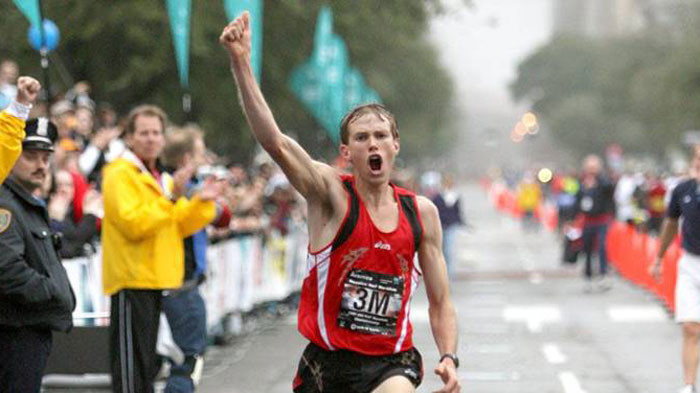
The documentary, which was provided to Runner’s World for advanced viewing, follows Hall through his early days as a teenage prodigy in Big Bear Lake, California, his meteoric rise as a cross-country and track athlete at Stanford University, and finally his rollercoaster career as a professional runner. You can watch the movie in select cities throughout October (view the full screening schedule here), and also preorder the DVD, which will be shipped in November.
In the film, Hall is interviewed during pinnacle stages of his career, such as when he set the American half marathon record (59:43) and won the Olympic Marathon Trials in 2007, as well as when he boldly announced in 2010 that he was leaving his coach and turning to God alone for guidance. Throughout the film, we see footage of Hall racing and training, as well as interacting with friends, family, plus his wife—professional marathoner Sara Hall—and their daughters, who all live in Flagstaff, Arizona, today.
by Hailey Middlebrook
Login to leave a comment
Sara Hall was the winner at the New York Mini USA 10-K in Central Park
On a morning with near-perfect weather conditions in Central Park, Sara Hall won a thrilling battle for the USATF Women’s 10-K Championship, using a devastating kick to pull away from fellow Flagstaff, Arizona, resident Stephanie Bruce in the final 100 meters. The event was held as part of the 48th edition of the NYRR New York Mini 10-K, the longest-running women’s-only road race in the world.
Five minutes before the open race began, a field of 28 American professionals set out for the national title under comfortable temperatures (68F/20C) with moderate humidity and a slight breeze. Emma Bates, winner of U.S. titles in the marathon and 25-K in the past sixth months, took the early lead as the pack raced up Central Park West for the first mile (5:20), with Jordan Hasay and Carrie Dimoff a step behind.
As the race moved into the park a few minutes later, Bruce inserted herself just behind Bates, while Hall began to move up through the tightly-bunched group.
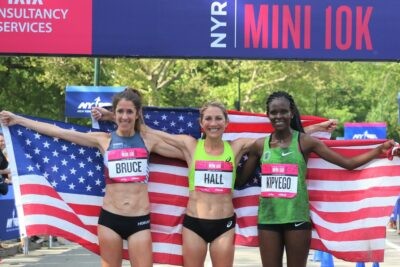
Shortly past 2 miles (10:28), a pack of five began to pull away, including Bates, Bruce, Hall, Aliphine Tuliamuk and Sally Kipyego. Laura Thweatt soon reconnected to the leaders and those six women climbed and descended the steep north hill in the park together through 3 miles (15:34) and 5-K (16:11). In the fourth, uphill mile Bates finally gave up the lead and appeared to be dropping back, with Thweatt and Kipyego taking turns controlling the pace.
“It was an honest pace the whole way. I couldn’t believe how fast we came through 5-K, which is mostly uphill,” Hall told Race Results Weekly. “There was always someone else would get in the lead and start pushing any time it slowed down.”

At the 4-mile mark (21:02) Bates had worked her way back into the mix, with Bruce and Thweatt now leading the group of six. Shortly past 8-K (26:02), the pack passed Sara’s husband and coach, Ryan Hall, cheering on the side of the course.
“I could tell she was relaxed,” the two-time Olympian said. “She smiled at me when she came past me. I was just telling her to collect herself on the downhill. When you’re at that point in the race, everyone is screaming at you and you have to just relax, take a deep breath, collect yourself for the finish.”
Moments later the 36-year-old Hall began a surge to the front, running side-by-side with Bruce, and Kipyego a stride back. With a little more than 400 meters to go, Kipyego lost contact as Bruce and Hall were powering uphill to the finish. At 6 miles (31:25) it was still tight, before Hall unleashed a powerful sprint over the final climb to the tape adjacent to Tavern on the Green (the same iconic finish line as the TCS New York City Marathon).
by Richard Sands
Login to leave a comment
New York Mini 10K
Join us for the NYRR New York Mini 10K, a race just for women. This race was made for you! It’s the world’s original women-only road race, founded in 1972 and named for the miniskirt, and it empowers women of all ages and fitness levels to be active and to look and feel great on the run. Every woman who...
more...The US Men's Marathon scene over the last few years was all about one runner Galen Rupp until now, enter Scott Fauble and Jared Ward
The America's men marathon scene over the last few years has not been very impressive not includng some steller performances by one Galen Rupp. There were no sub 2:10 performances (not including Ruff) since Meb keflezighi won the Boston Marathon in 2014 clocking 2:08:37. Things changed on April 15 in Boston.
Former University of Portland cross country and track star Scott Fauble was the top U.S. finisher and placed seventh overall in the 123rd Boston Marathon. Fauble’s time of 2:09:09 is the fastest time from a U.S. runner since 2014 besides Galen 2:06:07 at the 2018 Prague Marathon, 2:06:21 in Chicago the same year and two other sub 2:10 performances.
After the race Soctt Fauble posted, "I don’t have the words to explain yesterday yet. Until those words come, I want to say thank you to so many people, but mostly to Boston. You guys were perfect out there. Thank you."
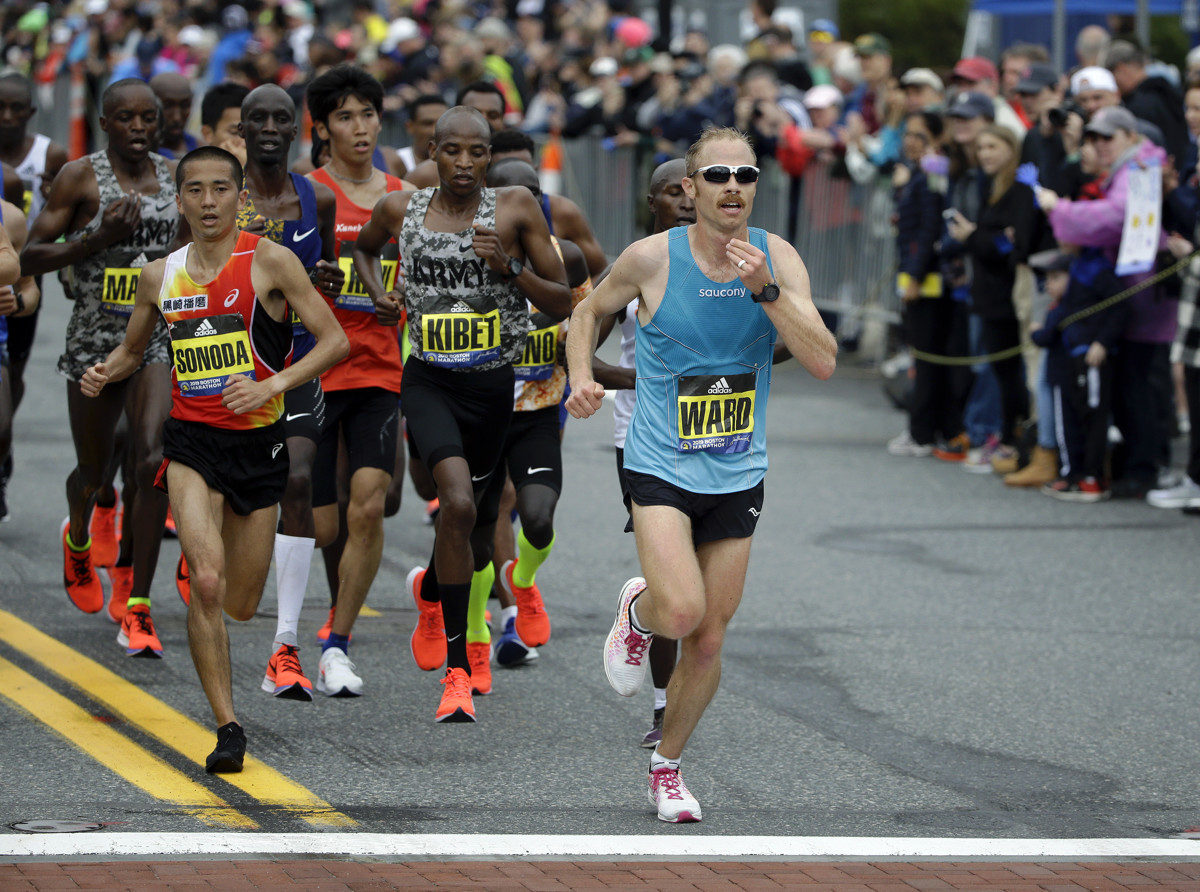
America's 25-year-old Jared Ward too had a steller day clocking 2:09:25 for eighth place. “I’ve been waiting on this 2:09 race for a long time. I think I’ve had it in me a little bit, but conditions today were good enough for running fast,” said Ward, now 30.
Fauble ran the 11th fastest time from a United States born marathon runner in history and the eight fastest time by an American in Boston Marathon history.
“When I was leading, I was thinking, ‘Holy bleep, I can’t believe I’m leading the bleeping Boston Marathon,’” Fauble said. “It was just a surreal experience to be leading a race I grew up watching on TV — not even just growing up, I watched it on TV the last four years and kind of idolized the race and the experience.”
Fauble had a stellar career as a runner for the Pilots. A former University of Portland male student athlete of the year winner, he led the Pilots’ cross country team to a third place finish in 2014, their first ever podium finish. He earned All-American honors for three straight years in cross-country from 2013 to 2015 and earned similar honors in the 10,000 meter race in track.
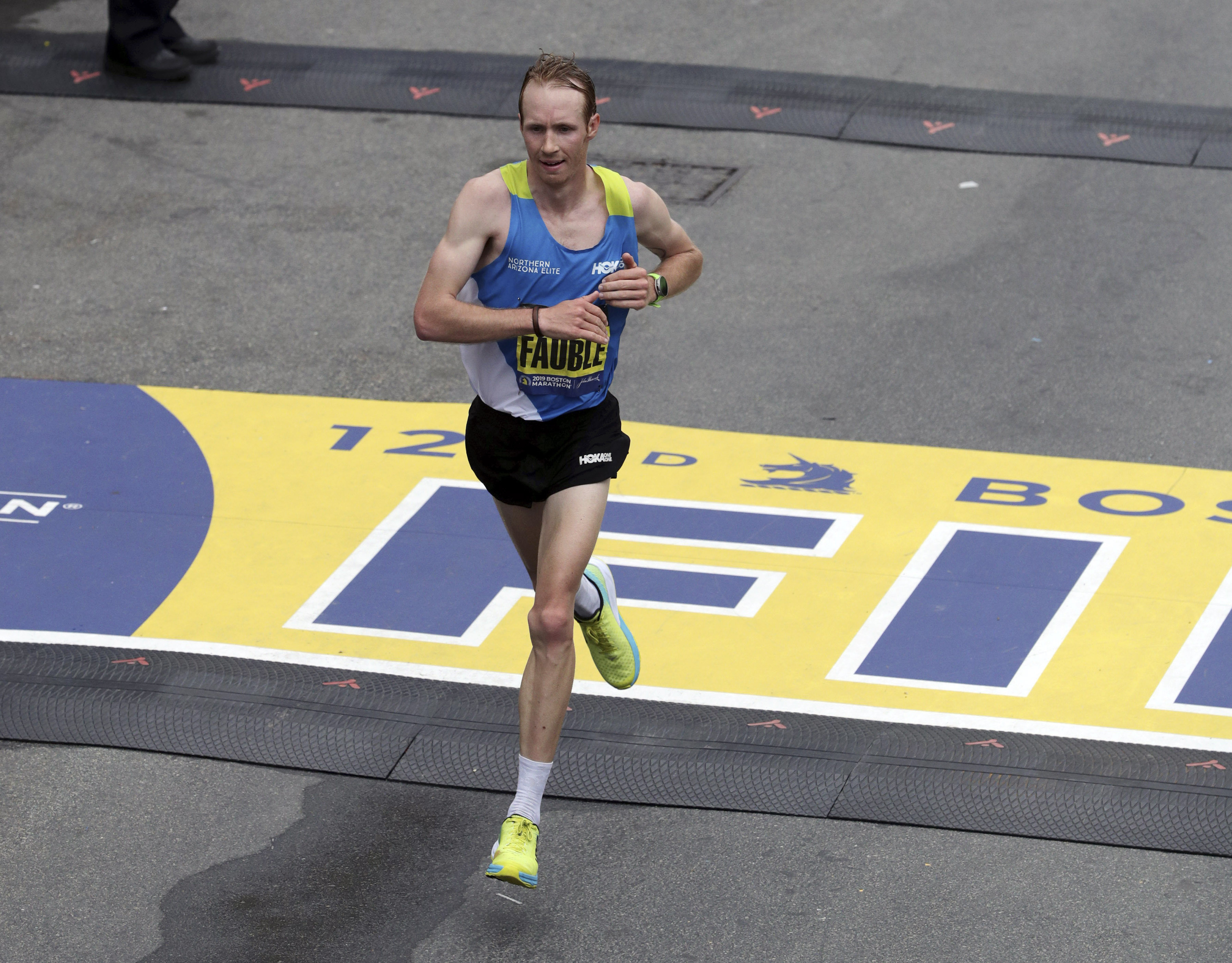
“Scott’s success surprises nobody,” Portland men’s cross country and track & field head coach Rob Conner said in a press release. “He was always the hardest working guy on our team and he has taken it to a new level as a professional. We are extremely excited for him and proud of his accomplishments.”
A review of the US all-time marathon scene looks like this. In 2011 Ryan Hall clocked 2:04:58 in Boston under perfect conditions and 2:06:07 in 2008 (London). This ranks Ryan Hall 77th on the all-time world list. America's Khalid Khannouchi clocked four times 2:07:04 or under in 2000, 2002 and 2006. Plus Galen's performances noted above.
Is this maybe the beginnings of American men moving up in the rankings?
Login to leave a comment
Boston Marathon
Among the nation’s oldest athletic clubs, the B.A.A. was established in 1887, and, in 1896, more than half of the U.S. Olympic Team at the first modern games was composed of B.A.A. club members. The Olympic Games provided the inspiration for the first Boston Marathon, which culminated the B.A.A. Games on April 19, 1897. John J. McDermott emerged from a...
more...John Hancock 2019 Boston Marathon US Elite Open Team
Featured video: 2019 Boston Marathon John Hancock U.S. Elite Open Team for Monday April 15.
Abdi Abdirahman, a four-time Olympian, placed sixth at the 2017 Boston Marathon. He is a multiple national champion in the 10,000m, 10K, 10-mile and half marathon.
Shadrack Biwott finished third this year in Boston. Last year, he was second American and fourth overall. Biwott placed fifth at the 2016 TCS New York City Marathon in a personal best time of 2:12:01.
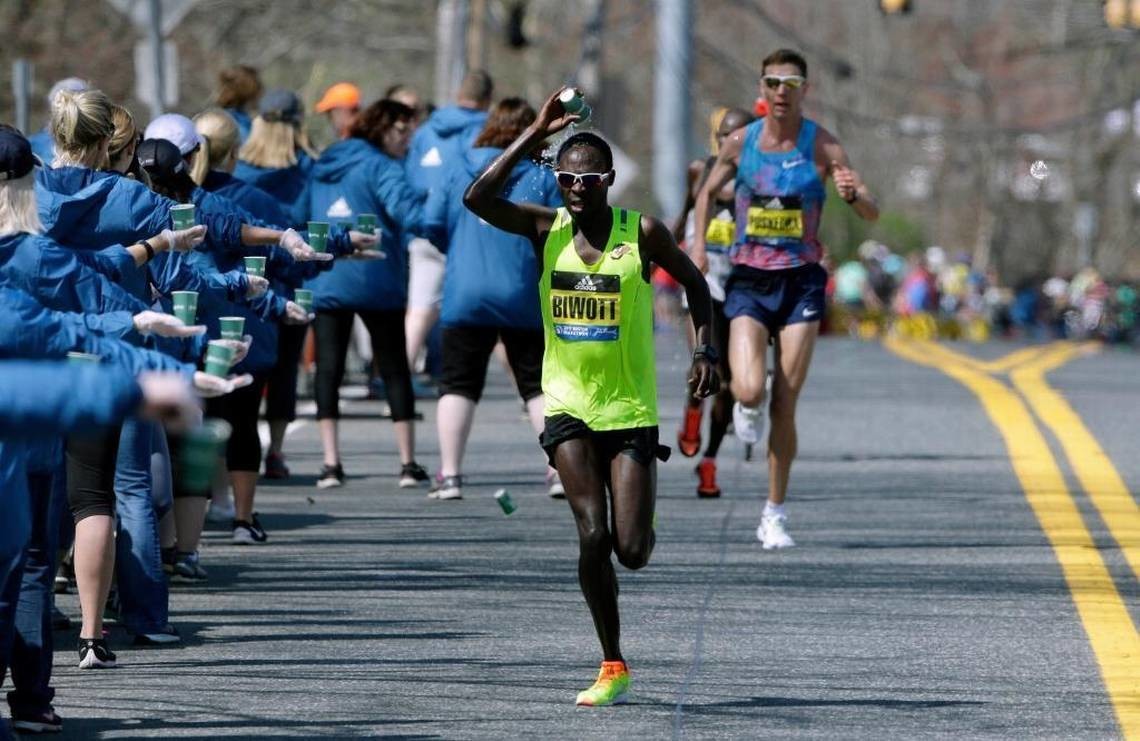
Aaron Braun, 13th at the 2018 Bank of America Chicago Marathon, is a versatile road runner. Braun is a national champion in the 12K and was top American at the 2015 Houston Marathon.
Sarah Crouch has finished top-ten three times at the Bank of America Chicago Marathon, including this year where she was top American and ninth overall. She is a past champion of the Tallahassee Marathon and finished 11th at the 2016 Boston Marathon.
Jeffrey Eggleston has raced on three IAAF World Championships Marathon teams, placing as high as 13th in 2018. He has won the Pittsburgh, Woodlands, Lima and San Diego Marathons and has been runner-up in Brisbane, Pittsburgh and at Twin Cities.
Scott Fauble was the second American and seventh overall at the 2018 TCS New York City Marathon. Fauble placed fourth in the 10,000m at the 2016 Olympic Trials and represented the United States at the 2017 IAAF World Cross Country Championships.
Lindsay Flanagan, the 2015 Pan American silver medalist in the marathon, finished 11th at the 2017 Boston Marathon and set her personal best of 2:29:25 at the Frankfurt Marathon this year.
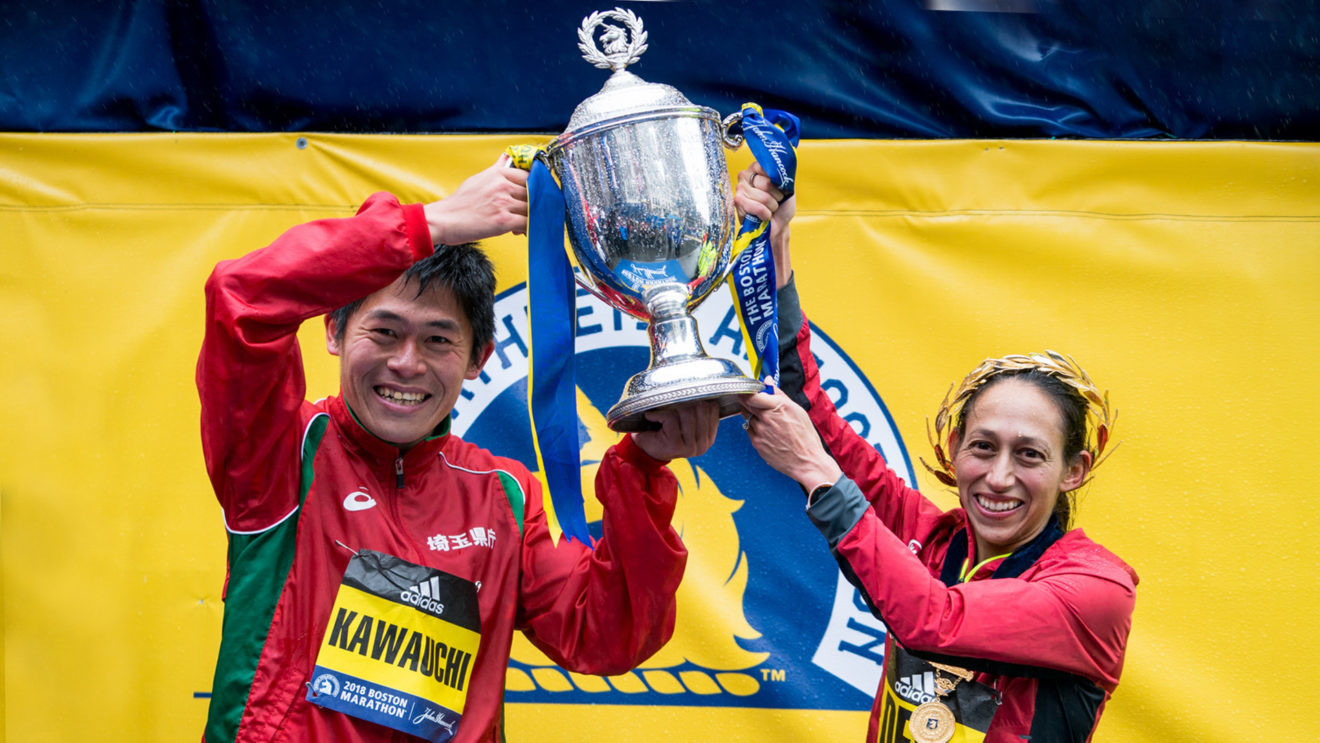
Sara Hall is the tenth fastest U.S. women’s marathoner of all time having set her 2:26:20 mark at the 2018 Ottawa Marathon. Hall has earned national titles in the marathon, 20K, 10-mile, mile and cross country. She is married to Ryan Hall, who is a John Hancock Elite Athlete Ambassador and holds the American course record of 2:04:58 at the Boston Marathon.
Jordan Hasay set an American debut record of 2:23:00 with her third-place finish in Boston in 2017. She then ran the second fastest marathon of all time by a U.S. woman at the 2018 Bank of America Chicago Marathon, where she placed third in 2:20:57. Hasay is an 18-time All American and a national champion at 15K and 20K.
Elkanah Kibet, a member of the U.S. Army World Class Athlete Program, has had two top-ten finishes at the Bank of America Chicago Marathon. At the 2017 IAAF World Championships Marathon, Kibet finished top American and 16th overall. He was 8th in Boston in 2018.
Desiree Linden, a two-time Olympian, returns to Boston as defending champion. A top-five finisher in eight Abbott World Marathon Majors, additional accomplishments include placing seventh at the 2016 Olympic Games Marathon, tenth at the 2009 IAAF World Championships Marathon, second at the 2012 and 2016 U.S. Olympic Marathon Trials and second in the 10,000m at the 2015 Pan American Games. In addition to her 2018 win in Boston, she placed second in 2011.
Timothy Ritchie, the 2017 U.S. National Marathon champion, ran for the U.S. at the 2016 IAAF World Half Marathon Championships where he placed 23th. Ritchie is the head men’s cross country coach at the University of Massachusetts, Amherst.
Dathan Ritzenhein is the fourth fastest U.S. marathoner of all time with a 2:07:47 personal best. Career highlights for the three-time Olympian include finishing ninth at the 2008 Olympic Marathon, winning the bronze medal at the 2009 IAAF World Half Marathon Championships and finishing 13th at the 2012 Olympic Games 10,000m.
Sarah Sellers ran through freezing rain and torrential wind this year to finish second behind Des Linden. In her 2017 marathon debut, Sellers won the Huntsville Marathon. In New York this year she finished 18th.
Brian Shrader is a versatile runner on the track and roads. He made his half marathon debut in Boston this year at the B.A.A. Half Marathon, running 1:05:26. He also made his marathon debut in 2018, running 2:13:31 at the USA Championships in Sacramento.
Becky Wade, a champion of the California International Marathon, finished 11th at the 2018 Virgin Money London Marathon and tenth at the 2017 Bank of America Chicago Marathon.
Jared Ward placed third at the 2016 U.S. Olympic Marathon Trials and followed with a sixth-place finish at the Olympic Marathon in Rio de Janeiro, less than a minute and a half out of medal contention. In 2017 Ward was tenth at the Boston Marathon and this year, he finished top American and sixth overall at the TCS New York City Marathon.
Login to leave a comment
Boston Marathon
Among the nation’s oldest athletic clubs, the B.A.A. was established in 1887, and, in 1896, more than half of the U.S. Olympic Team at the first modern games was composed of B.A.A. club members. The Olympic Games provided the inspiration for the first Boston Marathon, which culminated the B.A.A. Games on April 19, 1897. John J. McDermott emerged from a...
more...John Hancock today announced its Elite Athlete Ambassador Team for the 2019 Boston Marathon
Boston Marathon champions Meb Keflezighi, Tatyana McFadden, Bill Rodgers, Joan Benoit Samuelson, Greg Meyer and Uta Pippig will join Shalane Flanagan, Ryan Hall, Deena Kastor, Becca Pizzi and Team Hoyt as ambassadors for this year’s race.

“As Patriots’ Day nears, we welcome our 2019 Elite Ambassador Team for the Boston Marathon,” said John Hancock Chief Marketing Officer Barbara Goose.
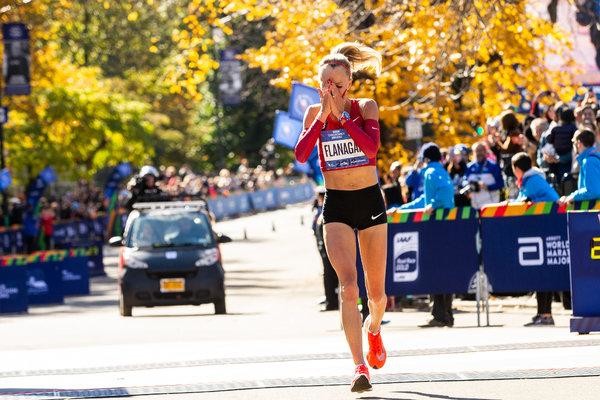
“Through their mentorship and inclusiveness, these accomplished athletes inspire runners of all ages and abilities during race week and throughout the year at John Hancock sponsored events.
The team has become an integral part of our community.”
Ambassadors will cheer on the 30,000 participants racing from Hopkinton to Boston on Patriots’ Day and attend media, community and race week events, including making appearances at the Runner’s Seminar at the Expo, surprise “meet and greets” near the finish line, and at the John Hancock Elite Athlete press conference on April 12 at 10 a.m. at the Fairmont Copley.
Login to leave a comment
Boston Marathon
Among the nation’s oldest athletic clubs, the B.A.A. was established in 1887, and, in 1896, more than half of the U.S. Olympic Team at the first modern games was composed of B.A.A. club members. The Olympic Games provided the inspiration for the first Boston Marathon, which culminated the B.A.A. Games on April 19, 1897. John J. McDermott emerged from a...
more...Meb Keflezighi became the first American male to win the Boston Marathon in 31 years in 2014
Two nights before the 2014 Boston Marathon, I was walking from the Harvard Club with race director Dave McGillivray after a meeting with the Martin Richard Foundation.
Dave asked me, “What’s your goal for Monday?” I said, “To win. I’m going to go for it.”
Of course I always ran to win, in the sense of getting the best out of myself on race day. But this time was different — I meant it literally.
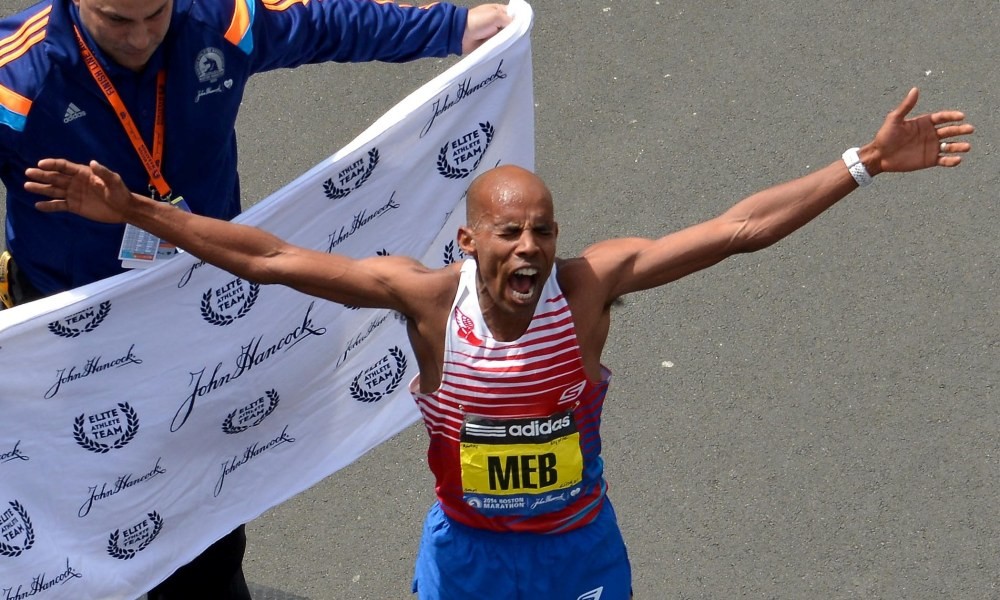
Boston 2014 was a special focus long before I broke the tape on Boylston Street.
I had watched the 2013 Boston Marathon from a grandstand by the finish with my good friend from San Diego, Rob Hill. Injury had scuttled my plan to be there as a competitor.
While I would have liked to be racing, watching thousands of runners finish amid the palpable positive energy was a great experience. I was taking photos and notes on the positive humanity and camaraderie the marathon embraces. It had been 30 years since an American man won Boston.
As soon as Lelisa Desisa of Ethiopia broke the tape in 2:10:22, I texted my friend and fellow US Olympian Ryan Hall, who also missed the race because of injury. “WE CAN DO THIS,” I wrote. Ryan texted back almost immediately, “We’ll get after it.” Already fired up for 2014, I left the stands.
by Meb Keflezighi
Login to leave a comment
Boston Marathon
Among the nation’s oldest athletic clubs, the B.A.A. was established in 1887, and, in 1896, more than half of the U.S. Olympic Team at the first modern games was composed of B.A.A. club members. The Olympic Games provided the inspiration for the first Boston Marathon, which culminated the B.A.A. Games on April 19, 1897. John J. McDermott emerged from a...
more...Galen Rupp was selected as USATF Athlete of the Week after winning the Prague Marathon clocking 2:06:07
Galen Rupp, the bronze medalist at the 2016 Olympic Games, ran 2:06:07 to win the Prague Marathon May 6 by almost a minute over Sisay Lemma of Ethiopia.
He sliced more than three minutes off his previous lifetime best of 2:09:20, set in winning Chicago last year. His time ranks him second only behind American record-holder Khalid Khannouchi, who ran 2:05:38 in 2002, on the U.S. all-time list. (Not including Ryan Hall’s time on the point-to-point Boston course.)
Rupp has never placed lower than third in any of the five marathons he has finished. He has also improved his PR on each marathon he has finished. Rupp (Portland, Oregon) won the Prague Marathon and became the second-fastest U.S. man ever in the event to earn USATF Athlete of the Week.
Now in its 17th year, USATF’s Athlete of the Week program is designed to recognize outstanding performers at all levels of the sport.
Login to leave a comment


